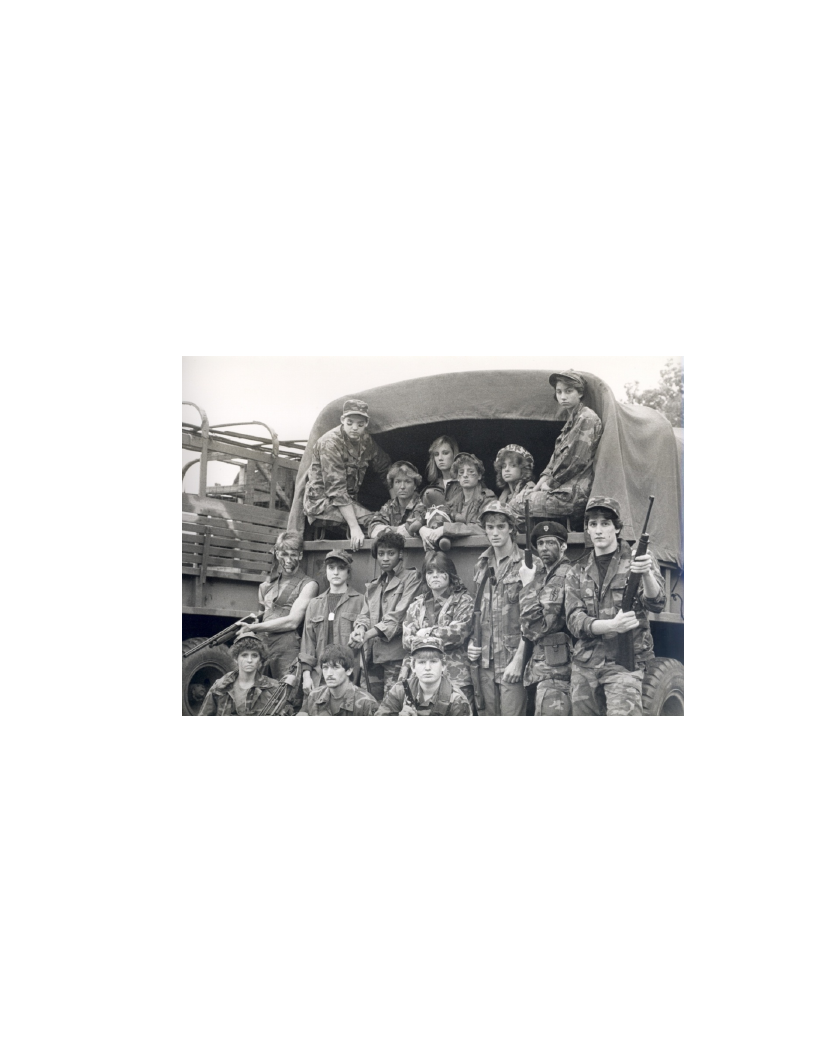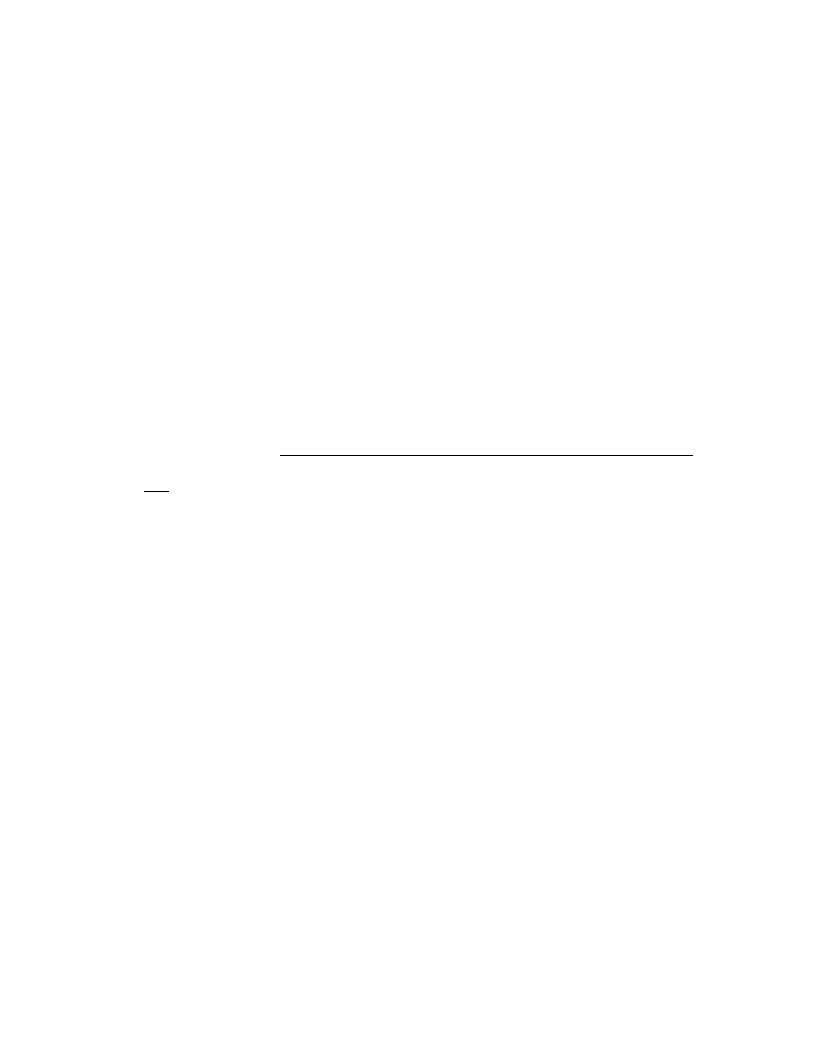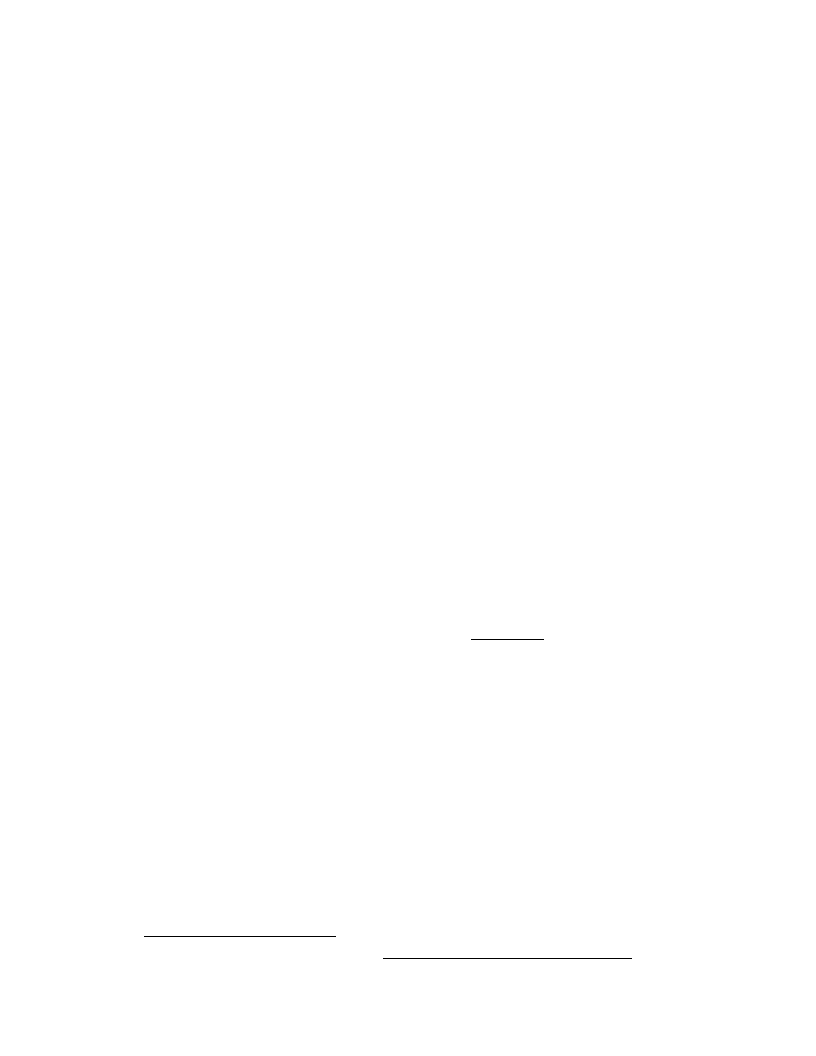
RHODES, DANIEL, Ph.D. An Anarchist Psychotherapy: Ecopsychology and a
Pedagogy of Life. (2008)
Directed by Glenn M. Hudak. 205 pp.
Drawing from my background in education and psychotherapy, I reflect on how
both of these fields are heavily influenced by developmental and behavioral psychology.
Today’s psychological model is influenced by a western scientific theory that is
reductionist and views the natural world and those in it as commodities to be dissected,
segmented and studied. I trace the evolution of this western scientific model and reflect
on how it has shaped contemporary psychology. Once psychology has adopted this
western scientific model as the only model, it demands that both education and
psychotherapy view those with whom they work as commodities. This model is
hierarchical, patriarchal and linear in its approach, which rejects the individual’s needs
and desires to be independent and autonomous.
During this process I intimate an alternative scientific model. The scientific model
that I postulate is more inclusive and views the natural world and those living in it as
organic and interconnected. I draw from an array of philosophical ideas ranging from
Eastern philosophies such as Taoism and Buddhism to western philosophical ideas such
as anarchism and Marxism. Anarchism and Marxism strongly critique western capitalist
endeavors. Both are models of critical theory that challenge the hierarchical aspects of
western psychology. I also look at ideas of ecofeminism and its critique of Neoliberalism
and globalization, which is promoted by the western scientific model as a way to support
the exploitation of Third World countries by transnational corporations and

agribusinesses. Ecofeminism is a strong critic of the patriarchal structure of western
science and western psychology. I will then reflect on the ideas of religion and
spirituality that are more ecological and “engaging;” or what I call ecospirituality. This
ecospirituality places strong emphasis on the ideas of contemplation, dialogue and
community building, which provides an alternative to the linear thinking in western
psychology and science.
Ultimately psychotherapy and education need to become an intellectual endeavor
and educators and psychotherapists need to become “cultural workers.” Through this
process there will be an embracing of radical democracy, communalism and ecological
consciousness. In this dissertation I suggest that western psychology should shift from its
developmental and behavioral influences with its reliance on a western reductionist
scientific view to what Theodore Roszak calls an ecopsychology. This ecopsychology is
inclusive, and therefore views the individual and the natural world as more than a
commodity and becomes a pedagogy of life.

AN ANARCHIST PSYCHOTHERAPY:
ECOPSYCHOLOGY AND A
PEDAGOGY OF LIFE
by
Daniel Rhodes
A Dissertation Submitted to
the Faculty of The Graduate School at
The University of North Carolina at Greensboro
in Partial Fulfillment
of the Requirements for the Degree
Doctor of Philosophy
Greensboro
2008
Approved by
_________________________________
Committee Chair

To
Cecil, Carolyn,
Betty & Laura
ii

APPROVAL PAGE
This dissertation has been approved by the following committee of the Faculty of
The Graduate School at The University of North Carolina at Greensboro.
Committee Chair
Committee Members
Date of Acceptance by Committee
Date of Final Oral Examination
iii

ACKNOWLEDGMENTS
I want to begin by acknowledging my committee chair and advisor, Dr. Glenn
Hudak. Dr. Hudak has become a dear friend and mentor and provided a great amount of
support for me during this endeavor. I also want to thank Dr. Leila Villaverde, committee
member and advisor for my graduate certificate in Women and Gender Studies, for her
support in both my graduate certificate and my dissertation. I also could not have done
this without the support and assistance of my other committee members, Dr. Bill
Hamilton, Dr. Svi Shapiro and Dr. Charles P. Gause, all of whom brought very unique
perspective to both my studies and my work on this dissertation. To all of them I give
many bows and many thanks.
I also want to thank my very supportive family. My life partner Laura Mrosla who
has supported me through all my endeavors (including my periodic stays at Buddhist
temples). To my uncle Cecil Allen, I only wish he could be here to share this with me. I
want to thank my aunt Carolyn Allen and my mother Betty Rhodes. I also want to
acknowledge my brother Randy Williams, who has read this dissertation over numerous
times as well as other writings and has given great feedback and suggestions throughout.
iv

TABLE OF CONTENTS
Page
CHAPTER
I. INTRODUCTION ................................................................................................1
The Journey..................................................................................................1
Methodology ..............................................................................................25
Chapter Summaries ....................................................................................30
II. A PSYCHOLOGY OF ANARCHISM...............................................................36
Who is Watching Me? ...............................................................................36
Panopticon..................................................................................................41
Panopticon and Social Sciences.................................................................44
Paranoid and Delusional ............................................................................47
Incorporating Science ................................................................................49
Evolving Science .......................................................................................53
A Psychology of Anarchism ......................................................................58
Freedom .....................................................................................................61
Alienation ...................................................................................................64
Re-connecting and Ecopsychology............................................................68
III. ECOPSYCHOLOGY..........................................................................................70
The Beats Man…The Beats .......................................................................70
Ecopsychology ...........................................................................................77
Taoist and Buddhist Influence ...................................................................80
Spiritual and Mystical Component ........................................................... 83
Connection ☯ Balance...............................................................................90
Wu Wei .......................................................................................................95
IV. GLOBALIZATION AND ECOFEMINISM ......................................................99
Globalization ..............................................................................................99
Ecofeminism and Globalization...............................................................108
Ecofeminism and Feminism ....................................................................112
Ecofeminism and Male Patriarchy...........................................................120
Ecofeminism and Western Environmentalism.........................................123
Critiques of Ecofeminism and Spirituality ..............................................126
v

Page
V. ECOSPIRITUALITY .......................................................................................130
Irrational Mysticism? ...............................................................................130
Fascist Ecology ........................................................................................132
Nanda and the Principle of Deduction for Justification...........................133
Nazis, Science and Fanaticism.................................................................134
Centrism vs. Radicalism ..........................................................................137
Ecoterrorism .............................................................................................139
Secularism vs. Spirituality .......................................................................142
Fast Food Spirituality...............................................................................145
Engaged Buddhism ..................................................................................150
Engaged Spirituality.................................................................................152
Engaged Pedagogy...................................................................................153
Engaged Communities .............................................................................155
Ecospirituality ..........................................................................................158
Working towards Synthesis .....................................................................159
VI. CONCLUSIONS...............................................................................................163
Intellectual Contemplation.......................................................................163
Client Centered and Productive ...............................................................169
Panoptic Psychotherapy ...........................................................................171
Dependence vs. Progress .........................................................................172
Strength-Based Practice and Outcome Measures ....................................175
CQI and CMIS .........................................................................................177
Cultural Workers......................................................................................180
Psychotherapeutic Regime of Truth.........................................................182
Towards an Anarchist Psychotherapy......................................................184
Institutions................................................................................................186
Final Note.................................................................................................189
REFERENCES ................................................................................................................191
vi

LIST OF FIGURES
Page
Figure 1. Author’s High School Annual Staff Photo ........................................................12
Figure 2. Photograph Taken at a Local Park......................................................................58
vii

1
CHAPTER I
INTRODUCTION
The Journey
I reflect on the fact that while I now sit down and begin this dissertation I have
spent most of my adult life in some form of higher education, either in formal educational
institutions or by my own personal quest. There is a lot of irony in this realization
considering I was not regarded as a stellar student during my primary and secondary
school years. Since I was perceived as a “lost cause” by our public educational system, I
was easily passed along in school, mainly sitting in the back of class with a book, usually
Kurt Vonnegut or science fiction. This reading became my own form of self education,
gravitating towards those stories or ideas that I found fascinating and would transport me
away from the oppressive confines of a small southern town. Since there was no
standardized testing, like the end of grade tests, I was able to do the bare minimum
needed to pass my classes, or be passed along without much difficulty. I was very crafty
and subversive during these years and this stealthy gamesmanship helped me avoid
getting in trouble or being labeled as a “special needs” child and placed in remedial
classrooms. With all of this subversion and avoidance of being inculcated into this
institutional educational system I managed to graduate from high school with a 1.86 GPA
and a future that seemed wide open, or as wide open as can be for a person that graduated
high school with such a low GPA.

2
Reflecting on this high school experience I am reminded of a passage I read in
Henry Giroux’s (2001) book Theory and Resistance in Education in which he talks about
“resistance theories” (p. 246). Giroux (2001) claims that the most common type of
resistance in educational settings are by those who he terms as “showy rebels,”
individuals who resist the educational systems by being boisterous, defiant, and
oppositional (p. 246). Giroux laments the fact that resistance theories ignore those other
resistant students who do not exhibit these showy rebel characteristics, these are students
I would call “shadow rebels.” For them, Giroux (2001) notes:
Some students go through the daily routines of schooling by minimizing their
participation in school practices while simultaneously displaying outward
conformity to the ideology of the school. That is, these students opt for modes of
resistance that are quietly subversive in the most immediate sense, but potentially
politically progressive in the long run. (p. 246).
I, of course, had no clue that I was being “politically progressive” at the time. I was
simply trying to survive in what I perceived as an oppressive school system where I
didn’t “fit in.” It was also during this time that I was also a victim of an even more
insidious system of social control: The media during the 1980s, something that I will
elaborate on a little later.
Part of the reason I was so resistant to the public education that was foisted upon
me was because I viewed it as part of a larger overall oppressive system, and that was the
small southern town mentality. My aunt and uncle had assumed the role of my parents
and settled in this small town after spending a good portion of their adult life traveling
and working around the United States. They came to this small community with a certain

3
cosmopolitan view that was unusual in these small southern areas. They instilled in me a
view of the world that was larger than this town and broader than the narrow views of the
inhabitants of the community. This broader perspective of course immediately separated
me from my peers and as I grew older I was increasingly viewed as strange and a misfit. I
felt alienated and disenfranchised from my teachers as well, most of whom shared the
narrow and provincial outlook of the community. An example of their parochial and
narrow outlook was an experience I had in third grade when my English teacher informed
the class we would be using “thee” along with “the” since “thee” was in the Bible and for
that reason we will be using it also. This, mind you, was a public school in the 1970s. I
also attribute educational styles such as this as laying the foundation of a conflicted view
of education and reality that would follow me up to the time I graduated high school.
As I barely progressed academically during my educational years and I
increasingly became distant from both peers and teachers, isolating myself through
reading and what was becoming a dominant force of the time, movies and the media
which included a very sparse version of cable network in relation to today standards. Part
of the problem I was having during these young years was that most of the people I knew
in this small community were unable to visualize the world beyond the small town and
anything outside of this community was regarded with suspicion. My aunt and uncle had
lived around the country so they viewed the world as an interesting place and wanted to
show me other parts of the country which they did through periodic travel. The books that
I read while growing up were also giving me an escape from the oppressiveness of a
small town with racist tendencies (the Klan was still active in this community in the

4
1970s and early 1980s and would periodically march through downtown). Kwame
Appiah reflects on this very notion of this small town mentality that would allow groups
like the Klan to still march. He focuses on Eric Rudolph, the individual who placed a pipe
bomb in a park during the 1996 Atlanta Olympics. As Appiah (2006) notes:
As news reports suggest, what’s especially troubling is the amount of support that
Rudolph seems to have enjoyed in places like Murphy, North Carolina, where he
was finally apprehended. Many of its residents openly identified with Rudolph;
during police manhunt, bumper stickers and T-shirts with the slogan “Rudolph’s a
Christian and I’m a Christian and he dedicated his life to fighting abortion,” a
young woman from Murphy, a mother of four, told a New York Times reporter.
“Those are our values. These are our woods. I don’t see what he did as a terrorist
act” (p. 142).
So as you can see the addition of movies and the media gave me the visual outlet that
allowed escape from the doldrums of this community. The irony of this fact was that
during the 1980s movies were dominated by an extreme form of patriotism that was
primarily being used to manipulate the population to buy into a perverted form of Reagan
democracy and more importantly a contemporary form or imperialism.
Mind you I was skinny, weak and strange. The images I was inundated with
during the 1980s were Rambo (Sylvester Stallone), and Schwarzenegger (in movies such
as Commando, 1985), and other movies such as Top Gun (1986). This was masculinity
and created a phenomenon that Douglas Kellner (1995) called the “Rambo effect” (p.
62). First Blood, the first installment of the Rambo movies, came out in 1982, when I was
a callow fourteen years old. For any adolescent, this is an age of self-doubt, insecurity
and awkwardness but for me I had all these feelings and the addition of being isolated
and adrift in this community. I had been greatly influenced by the movie Gandhi (1982)

5
when it came out in 1980 and actually had read some of Gandhi’s works while growing
up. Gandhi however was a million miles away both in time and place, much less
ideologically to the mindset of the small southern town in the early and mid 1980s.
Kindness in this small southern town was equated with weakness by both boys and girls
with whom I was growing up with (not to mention adults who psychically were not that
much more mature). I felt that my actual survival in this community would have to be
based on something that was perceived as a lot more masculine, and then enters Rambo.
As Kellner (1995) notes, Rambo and these other so called mythic figures are seen as
“victims of…the government and society at large” (p. 65). This victimization figured in
very well with the disenfranchisement that I was feeling at the time by both the
government (i.e. school system) and the society in which I was growing up (i.e. small
town).
You can see this victimization in the beginning of the first Rambo (1982) movie
where Rambo enters a small community which had very similar characteristics to the one
in which I was living. Here comes the mythic figure, war hero, outcast, and walking
wanderer; almost spiritual in a way, reminiscent of the 17th Century Japanese Zen poet
Basho and his travels that he wrote about in Narrow Road to a Far Province (1974),
A mound of summer grass:
Are warriors’ heroic deeds
Only dreams that pass?
His poem goes on to reflect, “What a fleeting thing is military glory.” (p. 57). Rambo
wanders into this small town and is immediately harassed and abused by the local law

6
enforcement agency. After being arrested and mistreated, he manages to escape and
instead of leaving the town decides to fight against the victimizing “oppressive authority
and power” (Kellner, 1995, p. 64). So here comes the twisted form of fascist propaganda;
Rambo, a product of militarism and structure, now fights against oppressive power
structures. The local law enforcement and National Guard are portrayed as bumbling
idiots, and it is Rambo’s great discipline, instilled by the military, that allows him to be
successful. It is not that Rambo was different than those that were victimizing him, just
better trained by the same system.
I, of course, just saw a man entering a small town that was being abused and
disenfranchised. Here was a worldly man who viewed the world as greater than himself.
This small town viewed him as strange and an outcast; I immediately identified with this
in my own life. This character became the modern version of myth. Star Wars (1977)
played a great role in the realm of myth for youth of my generation, but it was couched in
stellar fantasy and therefore unattainable. Rambo was the here and now and contained all
the elements of great myth, of the hero’s journey. As Joseph Campbell (1949) notes about
the hero’s journey and return he is “frequently unrecognized and disdained. He and/or the
world in which he finds himself suffers from a symbolic deficiency” (p. 37).
This movie was followed by a string of similar movies like it. Vietnam vet
movies, military hero movies, all with this notion of fighting for a cause, for something
just. As Kellner (1995) notes, the irony is that these movies conscripted the ideology of
the 1960s, of “individualism as social revolt and non-conformity”, and “about the
triumph of the individual over the system” (p. 65). I would argue that Rambo was not as

7
much personifying the hippie of the 1960s; he was personifying the revolutionary of the
late 50s to early 70s. He looked more like Che Guevara than a typical hippie of the 60s
and Rambo stumbling into this small community just bolsters this image. The individuals
in this small community were very much like the ones in my small town, narrow minded.
Rambo was worldly, he was Frantz Fanon and Che Guevara all wrapped up in one:
Fanon himself, like many of those fighting for Republican Spain or the Taliban,
was an international combatant. In many respects, his cosmopolitanism, his
tendency to identify with oppression and injustice in its many forms universally
rather than locally, his powerfully expressed humanism, his Maoist emphasis on
the revolutionary primacy of the peasantry, align Fanon with another famous
internationalist revolutionary and committed activist, another déraciné man of
routes, who was almost his exact contemporary and who died similarly young:
Che Guevara (Young, 2003, pp. 124 – 125.)
The media’s support of an actor president with imperialist designs very
masterfully crafts this image. It is no coincidence that in the third installment of the
Rambo movies, Rambo goes to Soviet occupied Afghanistan and fights with the
Mujahideen to help rescue his former colonel (in the real world the Mujahideen
eventually split off into Taliban and anti-Taliban factions and many of the Mujahideen
become Al Qaeda fighters). Rambo is supposed to be a postcolonial fighter, struggling
with freedom fighters in a small third world country, battling for independence against
the huge Soviet empire. In reality he is a symbol of American colonialism. In this movie
Rambo not only knows how to fight and use weapons, he also has the skills and abilities
to engage in complex tasks such as flying Soviet made helicopters, thus synching his
skills and intelligence with those real world freedom fighters that were also highly trained
and educated (both Fanon and Guevara were trained medical doctors).

8
Here is the contemporary postcolonial fighter, Rambo. In the fantasy world
Rambo was battling alongside freedom fighters in a Third World country. Meanwhile, in
the real world, Reagan was illegally supplying weapons to right wing dictators and death
squads in Third World Latin American countries, resulting in the death and rape of untold
number of people, all while conducting illegal weapons deals with Middle Eastern
countries. This support for dictators and right wing death squads actually began long
before Reagan, but was greatly escalated and supported by Reagan and his
administration. One of the most public assassinations occurring in a Latin American
country was the murder of Salvadoran Archbishop Oscar Romero; a Catholic priest who
spoke out against the United States supported dictator of his country, reporting to the
world the killings of innocent victims by the death squads. Romero had actually pleaded
with the American government not to send any money or support since it was being used
against his people:
Romero had asked President Carter to stop sending all aid, including humanitarian
aid, because, he said, it will be misused to “repress our people.” Turning a deaf
ear to Romero’s plea, the U.S. Congress appropriated $5.7 million in military aid
to El Salvador just one week after Romero’s murder. The precedent was set. By
the end of the twelve years of war, the United States was sending an average of $1
million a day to the Salvadoran government (Dennis, et. el., 2000, p. 94).
In addition to the monetary support that the United States provided to dictators
and death squads, supporting their terrorist activities in Latin American countries, the
United States military also trained them. One of the more insidious military fighting
groups from El Salvador was the Atlacatl Immediate Reaction Battalion:

9
The Atlacatl Battalion is an elite group organized by U.S. trainers in the early
1980s as a crack counter-terrorism force, and has been frequently implicated in
human rights abuses. The most famous was the massacre of over seven hundred
civilians in the town of Morazón in 1981,1 immediately following the battalion’s
initial training at Ft. Benning, Georgia (Sobrino, et. el. 1990, p. xv).
The training at Fort Benning mentioned in this paragraph was at the infamous School of
Americas. This School was developed to help train Latin American leaders and soldiers
to fight against communist insurrection, but most of the training involved torture
techniques and the training of death squads.
Another relatively well known case of murders in El Salvador (carried out by
soldiers educated at the School of Americas and sustained by United States financial
support) was the assassination of six Jesuit priests, their housekeeper and her teen-age
daughter in November 1989. The U.S. government was shameless in their denial of their
support of these murders and their assistance in helping the Salvadoran government cover
it up. This is evidenced by then U.S. Secretary of Defense Dick Cheney noting that
“There’s no indication at all that the government of El Salvador had any involvement” in
these murders and the State Department reporting that “The evidence has not linked the
killing to the military” (as cited in Sobrino et al., 1990, p. xix).
Of course, while the U.S. and Salvadoran governments were denying that they
had any connections to these brutal murders, they were both colluding to make sure the
only potential witness to all of this, a cleaning woman that lived on the campus where the
priests were located, would not go public with the information that she had seen
1 Bill Hamilton, PhD, one of my dissertation committee members, pointed out some inaccuracies
in this quote. “Town of Morazón” is actually “Department of Morazán.” Hamilton also noted that the
massacre took place in several hamlets and El Mozote being the largest of six.

10
Salvadoran soldiers enter the priests residence. Both the FBI and SIU (Salvadoran
Special Investigations Unit) assisted in transporting this woman to the United States,
where she was interrogated. After being denied legal counsel she became increasingly
frightened and eventually changed her story, leading the Attorney General to state that
she was “a very unreliable witness” (quoted in Sobrino, et. el., 1990, pp. xix – xx).
So in contrast to these actual events we have Rambo, elevated to the status of
“mythical” postcolonial fighter by the media. At the same time that Rambo was playing
as hero of the downtrodden in third world countries, the United States government was
actually directly connected to the massacre of countless number of people in Latin
American countries. But during this era of Reaganism the media were using these movies
as propaganda. These movies fed my need to rebel and to not conform to the system, and
encouraged a desire to feel important and wanting to do something that was greater than
myself. In essence I was being programmed, mentally colonized, and it was working.
This source of subversiveness becomes morphed into a perverted form of patriotism, and
in essence justified my rejection of my high school education. I did not need an education
to become a hero, I did not need an education to die for my country and fight for what I
thought was “right.”
These movies were also tapping into my insecurities. As mentioned earlier I was
this skinny, weakly kid growing up in a town were strength and masculinity were valued.
Rejected by girls because of my size and oddness, I felt isolated both mentally and
physically. These figures on the movie screen were god like. Rambo was a “mythic
warrior…larger-than-life human being” (Kellner, 1995, p. 67). As Kellner (1995) notes

11
the camera would “focus on his glistening biceps, his sculptured body and powerful
physique” and with this it would develop a “homo-erotic fascination with the male
warrior” (p. 67). I can attest to this! I was enthralled by these character’s physiques and
prowess. Being in my mid-teens, I would fantasize about being like one of these guys,
becoming one of them. Having the body shape of an ectomorph this Rambo body shape
was unattainable and unrealistic for me, but it was the body shape that was being fed to
both young men and women at the time.
This hyper masculine image added to my frustration and yet I was insidiously
drawn to it. What complicated the matter was the fact that these figures were also
emotionally damaged and unable to love. These movies were dripping with male
eroticism, but anything that consisted of actual erotic love was rejected. As Kellner
(1995) notes “this renunciation of women and sexuality highlights the theme that the
male warrior must go it alone and must thus renounce erotic pleasure” (p. 67). So in this
sense I could justify rejecting sexuality and women before they rejected me. This
rejection of love was very important for a crypto fascist system that was using the media
to brainwash impressionable young men to join the military under Reagan’s expanding
empire. For if you love, if you feel love for someone, then you have something to live
for. One is not as quick to sacrifice one’s life for a shaky political ideology if they have
something to live for.
This propaganda paid off. With the success of Rambo movies and Top Gun
(1986) there was an increase in military recruitment with a “big jump in applications to
military academies [where]…many students mentioned [Top Gun] in their applications”

12
(Kellner, 1995, p. 80) and where posters of Rambo were placed outside of Army
recruitment stations (Kellner, 1995, p. 70). It also was very influential in the school
systems, in relation to how kids interacted with each other and the system at large. The
one extracurricular activity that I engaged in during high school was with the annual staff
(yearbook), since my parents were photographers and I knew photography very well.
Figure 1 Author’s High School Annual Staff Photo (Author is on the row standing, second from the right)
Being steeped in the “Rambo effect” influenced our annual staff photo. We chose
to dress in camouflage and pose in the back of a military truck at the local National
Guard armory. This image is a sick statement considering an annual staff generally
attracts creative, sensitive and artistic individuals. This Rambo effect also influenced my
decision to join the Army and infantry at eighteen. My enlisting created a cognitive

13
dissonance however, where my sense of individuality and rejection of authoritarianism
reinforced by these movies bore no resemblance to the daily life of the infantry. I was
lured into this system with the idea that it would make me a “man”; where adventure
lurked around every corner and I could leave the oppressive small town mentality and see
the world.
Not only did these movies have a great impact on my youth and help steer me into
professions such as the military, they have had a dark and frightening legacy even now.
In an autobiography titled A Long Way Gone; Memoirs of a Boy Soldier Ishmael Beah
(2007) reflects in his days as a child soldier in Sierra Leone. As a way for adult soldiers
to indoctrinate the children kidnapped and forced into a life of military service and
killing, the adults would play for these children the movies that were such pop culture
icons in this country in the 1980s. In the events, which happed only a few years ago,
Beah talked about how “We would watch movies at night. War movies, Rambo: First
Blood, Rambo II, Commando, and so on. We all wanted to be like Rambo; we couldn’t
wait to implement his techniques” (p. 121). Beah notes on a disturbing conversation he
had with one of his childhood soldier buddies:
“Sometime I am going to take on a whole village by myself, just like Rambo,”
Alhaji told me, smiling at the new goal he had set for himself.
“I’d like to have some bazookas of my own, like the ones in Commando.
That would be beautiful,” I said, and we laughed (p. 122).
It is amazing to me, reading this and reflecting on my own experience, how powerful this
form of media is and how influential the messages from these movies are. These movies

14
instill a sense of invincibility. They equate the ability to massacre large numbers of
individuals with being courageous and brave.
In high school I studied different militaries and their combat forces. While the
Army attracted me because of the potential to enter Ranger or Special Forces school, I
was in for a rude awakening. Traveling down to Fort Benning Georgia (as noted earlier
this is where the infamous School of Americas is located) I was excited that I would be
training where both the Airborne school (parachute training) and Ranger school were
located. Upon arrival I was introduced to a system of hierarchy and control. Rambo was
valued by the military as a symbol of individual heroism and willingness to die for a
“cause” (of course, in fantasyland Rambo never dies). But individual heroism is not the
main purpose of the military. The ability to control young soldiers and get them to
following orders, conform and not ask questions, this is the main purpose of the military.
When I graduated high school I left an environment where if you were not part of the
culture you were an outcast, and entered an institutional system of the military where you
were ordered to be part of a culture. The sustaining aspect of the military culture is the
fact that at one point you may encounter adventure (this was the Army motto when I was
in high school, “It’s not just a job, it’s an adventure”). I struggled in basic training but
continued my military career (both active duty and reserves) for five years. I would not
trade my experience in the military, even though I do not agree with it. In some strange
way it gives me credibility to argue the insidiousness of the military system with
individuals that buy into jingoistic patriotism hook, line, and sinker, most of them having
never served in the military.

15
I learned more about personal hygiene, exercise, and athletics in the four months I
spent in infantry basic training then I did all during those years I took gym in school
(from 6th grade to 10th), which leads me to question what do most gym teachers provide?
In the school system I was faced with educated professionals that did not understand the
simple concept that one should wear shower shoes into a gym locker room to prevent the
spread of athlete’s foot, or the importance of wearing the correct shoes for running.
After my brief stint with basic training and active duty in the Army I returned
home, still active in the Army reserves. Not yet disillusioned by the military I was
planning my future and I knew I needed to utilize the resources that the military had
given me (i.e. G.I. Bill). Still steeped in this philosophy of duty and honor I decided to
attend the local community college and work towards a degree in criminal justice, with
the intent of becoming a law enforcement officer and possibly a federal agent. The
military actually gave me this sense of accomplishment, something that I had not felt in
the school system. The military also gave me something else, which I am sure they had
not intended, and that is my first introduction to Marxism.
When I entered the Army the US was still deep in the cold war with the Soviet
Union so most of our training was in relation to this “evil empire.” I wanted to
understand this enemy so I researched several aspects of beliefs, which included their
political structure. This research eventually introduced me to Marxist theory. Small
southern towns are not known for their understanding and support for leftist politics, so
there is a hint of irony that going from this small town to the Army gave me an
introduction to a political theory that is a lot better known in other democratic western

16
countries. My parents were products of the 1950s and McCarthyism and were terrified of
anything that could be considered subversive. Even though they identified themselves as
liberal, they were uncomfortable discussing ideas that were considered to the far left.
Marxism stayed in the back of my mind and really did not surface until a couple of years
later, when geopolitical events came to the forefront of my understanding.
While attending the local community college I once again interacted with a
bureaucratic system layered with rules and regulations. These rules serve a greater
purpose and that is perpetuating a system of institutional control for future workers.
Having managed to maneuver though high school I was armed with skills and techniques
that could help me in the process of obtaining my associates degree regardless of
institutional regulations. This experience in community college taught me that I have to
take a very active role in my own educational process. Bureaucrats in positions of power
in educational systems do not always have the student’s best interest at heart and if you
are going to rely on them you may never obtain your ultimate goal. Instructors and
advisors can be very helpful allies, but in a lot of ways they are in the same boat as the
students, attempting to understand and maneuver through a constantly changing system
of rules and regulations.
Since I actually graduated high school with little formal educational training I was
somewhat at a disadvantage when entering community college. Fortunately I
supplemented my secondary school years through my own studies and reading. When I
entered community college the school reviewed my high school GPA and required that I
take a few remedial classes. I attended a couple of these classes and found them tedious

17
so I decided to surpass them and work directly on the courses required for my degree. I
registered for the regular classes, and since most bureaucratic systems overwhelm
themselves with their own rules and regulations nobody followed up with fact that I had
not taken the required remedial courses. I passed all my coursework and eventually
graduated from community college with my associate’s degree without ever taken one
remedial class. The one very important idea I learned from my community college
encounter is that I have to take a very active part in my educational experience and not
rely on the system to do it for me.
A series of events happened towards the end of my community college experience
that changed my life dramatically and, to my view, re-connected me back to who I was as
a person. While in community college I continued my military service in the Army
reserves, transferring into a training or drill instructor unit. While in the reserves I
attended leadership schools such the Primary Leadership Development Course (PLDC),
the Leadership Academy (this was a school that trained individuals to become drill
instructors). All of this was happening to me during the late 1980s and events were
transpiring in the world from a geopolitical perspective that would change both my view
of the military and politics in general. One of these incidents happened in China and was
known as the Tiananmen Square massacre.
In June of 1989 students entered Tiananmen Square in China to protest and
demand for freedom and democracy. The Chinese government eventually cracked down
on these individuals, killing and wounding several. The United States government was
“somewhat” outspoken about this incident, but really did not make any moves to

18
demonstrate their concerns. While in community college I was starting to learn more
about American and World history. I was fascinated by the fact that the United States was
not really attempting to show its concern about China slaughtering its own people,
especially since we have been so aggressive in sanctions towards another communist
country, Cuba, where we have gone as far as implementing an embargo on “food and
medicine” (Chomsky, 2003, p. 88).
China has had a long history of Most Favored Nations (MFN) trading status with
the United States (or what is known as Normal Trade Relations). I began to question this
reality of sanctions and embargos on one communist country, yet MFN trading status
with another, especially since I was being feed a steady diet of honor, duty and country in
these military leadership academies. What I started to see is what Noam Chomsky
(2002) pointed out, “U.S. power doesn’t care much if the Chinese leaders murder
dissidents, what they care about is that the Chinese leaders let them make money” (p.
294). This exploitation of its own citizens for US economic gain is something that Cuba
would not allow and so we had to sanction them. I started to realize that the American
propaganda (brainwashed for me by the media and movies) was not about freedom and
democracy, but money and power; it was a neoimperialistic power
This was greatly complicated for me in 1990, when in August of that year Iraq
invaded the neighboring country of Kuwait. No more than a year after the Tiananmen
Square incident and suddenly the US starts to become very outspoken about this attack on
a sovereign nation. Much controversy came with this invasion, most of which the
American public did not understand. Iraq was very much a “US client state” which means

19
we had a very cozy relationship with Iraq up to this point (Churchill, 2003, p. 202). As
Ward Churchill (2003) points out, the U.S. government under the guidance of President
Bush “had approved the transfer of $5 million in advanced computers to the Iraq military
only the day before” Iraq invaded Kuwait (p. 202).
The United States had known about Iraq’s human rights violation and the killing
of their own people before its invasion of Kuwait, yet the United States continued to
maintain a very close relationship with Saddam Hussein. The United Stated continued
supporting Hussein and his government both economically and militarily even with the
knowledge of his barbarism. As Noam Chomsky (2003) points out, “Praise and support
shifted to denunciation as soon as the monster committed his first authentic crime:
disobeying orders by invading Kuwait” the orders that Hussein disobeyed were by the
US, which means as Chomsky notes, that the US was more concerned that Hussein was
becoming an independent leader instead of somebody we could control (p. 17). To the US
the worst crime that Hussein could commit was not listening to what we told him to do.
The other side of this story (which the American public was not made privy to) was that
Iraq considered Kuwait as part of its province. Most of the lines that were drawn in the
Middle East were drawn by colonial powers, and Kuwait was “separated from the rest of
the country by British fiat during the early 1920’s” (Churchill, 2003, p. 202).
My military role during all of these geopolitical conflicts had changed. Personally
I had become older and had grown intellectually so I started critically questioning what
was happening around the world, and the United States involvement. There was no doubt
in my mind, especially reflecting on our policy with China, Cuba, and now Iraq, that the

20
U. S. was motivated by a lot more than “honor, duty and democracy”; we were motivated
by oil and money. As noted my role in the military had also changed; I was no longer a
“grunt” (term used to demarcate an infantry solider from other soldiers), but I was a
leader and instructor. Reserve training units like the one I was in were being activated to
train others and then send them over to the Middle East to fight for oil companies and
money (although the U. S. was claiming it was democracy and freedom). The battalion I
was in was activating units and training people for the infamous “back door draft,”
although my unit had not yet been activated.
This back door draft needs some explanation since most people do not understand
it. When a person enlists in the military, they sign an agreement to an eight-year
commitment. So an individual can do two years active duty in the Army, finish his or her
time and go home, but they are still tethered to the Army for an additional six years, they
are just on “inactive status.” This means that at any point within the six years after a
soldier’s initial two-year service, he or she can be “called up” and ordered to active duty
again. After the cold war the military began following a business model and was
“downsizing,” which meant closing down units and releasing people from active duty.
When the United States government decided to invade Iraq, they basically reactivated
those soldiers that have been released from active duty, some of which did not want to be
reactivated. The units and instructors in our battalion that were activated were to do a
retraining “crash course” for these soldiers reactivated and send them overseas. I had a
great existential crisis with this.

21
So during the time leading up to this geopolitical event I finished the Leadership
Academy in the reserves, completed my associate’s degree, and was completing Basic
Law Enforcement Training (BLET) or “rookie school.” BLET is where I trained and
became certified to be a police officer. I was at a pinnacle point in my life; here I was this
young man, academically barely graduating high school, now having completed several
difficult training programs and an associate’s degree. I was still inculcated with this
brainwashing by the media and government, living this fantasy of being a soldier and
hero. I was now faced with the very great and difficult reality that I may be activated and
would have to train individuals to go fight and die for a cause that I believed was false.
I had to face the very real possibility that I may not be able to do what was
expected and ordered of me. I made the decision that if activated I would probably not go
and train others to die for oil companies and greedy politicians; I was prepared to become
a consciousness objector. That subversive part of me, that part of me that rejected
authority so many years ago in high school was coming out again, was being reclaimed. I
was becoming what I had been so long ago, a kid with anarchist leanings. Fortunately I
was not activated and as soon as the ground war was over and the troops started coming
back home I went to my Army reserve unit’s main office, turned in my equipment, and
transferred into the inactive reserves. Having a few more years left to serve on my
inactive statue I knew perfectly well that if in the future I was activated I would probably
not show up. I gave up my plans to become a law enforcement officer and decided to
continue on with my education, transferring to a university to work on my bachelor’s
degree.

22
This is where my true journey began. I started to reflect on the person I was
before the Rambo (1982) and Top Gun (1986) movies. Having my first introduction to
Marxism while in the Army, I revisited that philosophical theory, believing that the
government probably lied to me about a lot of things. Having gone through this great
existential crisis (my whole life was based on my training in the military and for law
enforcement) I sought out counseling to help me deal with this transition in life.
Education during this time also became a form of counseling for me, allowing me the
ability to explore philosophy, religion, the world and myself. What all of this did was
help me deprogram from the propaganda I had been inundated with and the training I had
received. Instead of rejecting all that I had learned during this time, I used it and accepted
it, integrating it into my understanding of this system that I had lived in and of myself.
My experiences in both the military and beyond became powerful tools for me in
my studies, in who I am and how I view this country and the world. It was also during
this time, after the military and while I was working on my bachelor’s degree, that I
began my studies in Eastern philosophies (Buddhism and Taoism). I had always been
fascinated with Eastern traditions, but my only venue for learning about them in a small
southern town was through martial arts. Once again I managed to morph this Eastern
philosophical interest into my military identity as an adolescent, but I was able to reclaim
this from a different standpoint and that was the philosophical and spiritual component.
My interest in psychology and psychotherapy was effectuated with my personal
counseling experience, especially in relation to how it can be helpful for people to ferret
through the minutia that we are all inundated with by both the media and government. To

23
me psychology was not a system to manipulate and brainwash, but to liberate and free a
person. It was becoming an anarchistic endeavor.
After completing college I worked in my chosen field of social work and
eventually went to graduate school, obtaining a master in social work and becoming a
psychotherapist. All of these experiences shaped me into what I am today, sitting here
working on my PhD and writing my dissertation. These experiences also gives the
foundation for this dissertation and imbues me with the theories I have and the arguments
that I want to postulate through these writings as reflected through the title I have for this
dissertation which is An Anarchist Psychotherapy: Ecopsychology and a Pedagogy of
Life. As the title itself denotes this dissertation is a fusion of multiple ideas; multiple
ideas that I have been in contact with throughout my life and that have played a
significant role in the shaping of my values and belief system. Some of these ideas seem
contradictory at first, if not at the very least unrelated. But for me there are various
threads that run through them and these threads are ideas such as justice, freedom,
ecology, and spirituality. As Kathleen Kesson (2002) notes on her work on contemplative
spirituality and social transformation she will, “Attempt to draw some theoretical links
between postmodernism, spirituality and the anarchist project” (p. 64).
This leads to the struggle I have with all of this, and that is congealing these ideas
together into a synthesis. One way I have personally managed to bring these ideas
together is through an internal dialectics, and synthesis is what dialectics does and I hope
that what you will see in the finished product is a dialectics of thoughts, ideas, etc (which
will be part of my methodology). I believe I can actually coalesce these ideas into a

24
working theoretical model that will not only offer a critical model to contemporary
society and our practices, but also provide an alternative model to how we approach
psychology, psychotherapy and education.
These ideas I work with throughout this dissertation are directly related to my
interests and beliefs. This work is related to my interest in leftist politics, especially
Marxism and anarchism. These are two ideologies that have been at odds for close to 150
years now, because adherents to these ideologies like to argue their views from a
historical standpoint and what I am proposing now is a need to bring these two ideas
together into a working model. There are some who have historically brought these
differing models together and it needs to continue to happen even now. Contemporary
anarchist Murray Bookchin (2004) touches on this in his introduction to the second
edition of his book Post-Scarcity Anarchism:
There was a time, even as recently as the early thirties, when radicals of all
kinds formed an ethical community, despite the many ideological differences
that divided them. Whether as socialists, anarchists, syndicalists, or populists,
they shared their views in free discourse, defended each other’s rights, and even
aided each other in publishing works that were ordinarily proscribed by the
bourgeois press. Anarchists like Emma Goldman could find solace and help
form Marxists like John Reed in times of difficulty, and anarchists like Sacco
and Vanzetti rallied universal support from the Left, including Communists,
despite their explicit criticisms of Soviet Russia (p. xxii).
I personally place myself in an anarchist camp, but with a strong desire to
understand and incorporate Marxist ideas and I hope my dissertation will reflect this. As
feminist Gayle Rubin (1993) notes, “Marxism is probably the most supple and powerful
conceptual system extant for analyzing social inequality” (p. 33). This work is also

25
related to my interest in religions, especially Buddhism, Taoism and indigenous religious
practices (Native American traditions and shamanism). Being a practicing Buddhist for
close to 10 years now, Buddhism has been and will continue to greatly influence how I
view the world. Related to my Buddhist beliefs I also plan to incorporate Buddhist and
Taoist poetry into the dissertation, especially in its relation to the natural environment and
ecology and how it has influenced what is known as ecopsychology. As well as being a
practicing Buddhist I have also been a practicing psychotherapist for over 10 years and so
I have a great interest in incorporating psychology and psychotherapy into my
dissertation and looking at how both psychotherapy and education have been heavily
influenced by behavioral and developmental psychology. I strongly believe that our form
of psychotherapy and education today needs to be influenced by more than just a
behavioral psychological model, that it needs a model that is more inclusive to the natural
environment, personal freedom and social justice, which is also an ecopsychology.
Methodology
The methodology that I am applying to this dissertation is as multifarious as the
dissertation itself, but there is method to my methodology. The theory of
autoethnography will be predominant as a methodology throughout this process.
Beginning with this chapter I explained the journey that led me to where I am today, I
will continue to use this autoethnography as a way to weave the personal with the
theoretical. This is closely related to Alan Watts’ (1951) notion of theory:
The proper meaning of “theory” is not idle speculation but vision, and it was
rightly said that “where there is no vision the people will perish” . . . But vision in
this sense does not mean dreams and ideals for the future. It means understanding

26
of life as it is, of what we are, and what we are doing. Without such understanding
it is simply ridiculous to talk of being practical and getting results (p. 105).
Using some of my personal experiences to critique the political, this autoethnography
becomes, as Stacy Homan Jones notes (2005), “a radical democratic politics” (p. 763), it
is also, as she continues to note, “A balancing act” (p. 764) and as some of us know this
balancing act can be very difficult to achieve sometimes. Some of the theories and ideas
that I try to bring together do not always want to “balance” well, but I will attempt to do
the best I can with these. I also believe that autoethnography is an advantageous form of
methodology to use in this arena since autoethnography is a “blurred genre, it overlaps
with, and is indebted to, research and writing practices in anthropology, sociology,
psychology, literary criticism, journalism and communication” (Jones, 2005, p. 765).
I feel that autoethnography as a methodology is a very effective tool to use with a
dissertation in a cultural studies program, with its roots in the Frankfurt School1 and a
multidisciplinary approach to contemporary issues. I also believe that this is a useful
methodology to use for somebody attempting to synthesize ideas such as anarchism,
Buddhism, Taoism, Ecopsychology, Ecofeminism and spirituality. All of these are
personal issues and a methodology of autoethnography will help me to explore these
concepts and to “Invoke the corporeal, sensuous, and political nature of experience rather
than collapse [this] text into embodiment or political language play” (Jones, 2005, p.
767).
1 Martin Jay (1973) notes in his history of the Frankfurt School that, “At the very heart of Critical Theory
was an aversion to closed philosophical systems” (p. 41).

27
This autoethnography is also a “poetics,” and I will actually use poetry throughout
this dissertation as a way to view and understand some of these issues. Attempting to
break away from the idea of scientific positivism that has saturated social sciences
research I am hoping to lean more towards what Brady (2005) notes are “Methods of
immersion and self-conscious saturation than to those of clinical distancing as forms of
learning” (p. 981). This poetics as methodology is for whom Brady (2005) calls the
“beachcombers of life” (p. 986), looking at bits and pieces laid out on a bigger area, not
eschewing that which is eclectic. As Brady (2005) notes about poetry and poetics, “In its
most creative form, poetry, surplus meaning is a protest against the constraints of the
ordinary rules of inquiry” (p. 998). This may not always read like it, but it is all poetry to
me.
Autoethnography is not the only methodology that I will employ for this process.
Since I will incorporate different ideas and beliefs into my dissertation (some of which
are contradictory) a dialectics of these ideas will be very important. This dialectical
approach is flexible with ideas that I am able to incorporate into my dissertation but also
flexible with ideas that I am not able to work into my theoretical model. Just because I
consider myself an anarchist does not mean I will subscribe to all anarchist theory, and
reject certain Marxist ideas. As anarchist Murray Bookchin (1999) notes:
Anarchists should learn from serious Marxists, as Marxists should learn from
serious anarchists, that we desperately need to strike a rational balance between
theoretical insight and popular spontaneity, between organization and impulse.
Each without the other is a guarantee of failure (p. 297).

28
For this dialectic process to work in my studies and research, I will have to be
very mindful of what I am reading and writing about, which leads to the other part of my
methodology which I call mindfulness deconstruction. I am using mindfulness from
eastern philosophical traditions such as Buddhism and Taoism, and western traditions
such Ellen Langer’s incorporation of mindfulness in education. As Langer (1993) notes:
“Mindfulness is a state of mind that results from drawing novel distinctions, examining
information from new perspectives, and being sensitive to context” (p. 44). In other
words with this mindfulness an individual has “the capacity to see any situation or
environment from several perspectives” (Langer, 1993, p. 44). As researchers we have a
tendency to exclude ideas that we do not agree with or that does not mesh with our own
personal beliefs or perspective. For a true dialectical process to work, especially as a
methodology, I will have to be as open and mindful as I can be.
This mindfulness from an eastern perspective will help me to be “aware” and to
be as skillful as I can in how I look at these issues. If my idea of mindfulness comes from
mainly eastern philosophy with some western traits, the deconstruction comes from
western philosophy and Derrida. This deconstruction is a “fine-grained reading of the
text” (Caputo, 1997, p. 83). But more than reading, it is as it sounds: it is deconstructing
it, to pick it apart. But to do this I have to be mindful and aware of what I am
deconstructing. It is difficult to deconstruct that which you do not know or understand.
As David Loy (2003) notes: “Jacques Derrida speaks of the necessity to lodge oneself
within traditional conceptuality in order to destroy it” (p. 26). For this methodology to

29
work, the deconstruction is essential, and will work very well with the autoethnography,
since this dissertation is unconventional. As Caputo (1997) notes:
Deconstruction means to be essentially anti-essential and highly unconventional,
not to let its eyes wax over at the thought of either unchanging essence or ageless
traditions, but rather to advocate an in-ventionalistic incoming, to stay constantly
on the lookout for something unforeseeable, something new. Deconstruction is a
way to giving things a new twist; it is bent on giving things a new bent, which is
what sets the nerves of both essentialists and conventionalists on edge. (p. 42).
For some reason I love the thought of setting conventionalists on edge.
Deconstruction does not go without its critics however; Allan Bloom (1987) feels that
deconstruction is the “last, predictable, stage in the suppression of reason and the denial
of the possibility of truth in the name of philosophy” (p. 379). Allan Bloom is somewhat
of a conventionalist however. David Loy (1988) feels that “the problem with Derrida’s
radical critique of Western philosophy is that it is not radical enough: his deconstruction
is incomplete because it does not deconstruct itself” (p. 249). To which Derrida (1991)
would respond that: “the enterprise of deconstruction always in a certain way falls prey to
its own work” (p. 41). With so much controversy surrounding a philosophical idea, what
better way than to use it as a form of methodology for my dissertation, especially since
some of the ideas I will be looking at can take one in many different directions. As
Caputo (1997) states: “The trick in deconstruction, if it is a trick, is to keep your head
without having a heading” (p. 116).

30
Chapter Summaries
Chapter Two: A Psychology of Anarchism
Numerous books have been written on the history of anarchism and what the
ideas of anarchism are. My intent is to avoid replicating that process in this chapter. What
I would prefer to do is reflect on what a psychology of anarchism would look like and to
do this I will start with reviewing a psychology of control. Western society is based on
hierarchical and patriarchal structures and to create these structures those in power must
convince others that it is in the best interest for all to have select individuals in positions
of power and control. This psychology of control becomes an epistemology of control.
This epistemology of control is where those in power use different means (i.e. media,
psychology, education) to develop a form of self monitoring within the population along
with technological monitoring. I will use Foucault’s exploration of Jeremy Bentham’s
Panopticon to look at this epistemology of control and how this idea of the Panopticon
has been used as a model for prisons, military structures, hospitals, school systems and
places of work. I will then look at how this mode of control has actually evolved with
technology and science (such as psychopharmacology).
From there I will then look at what a psychology of anarchism could conceivably
look like and it is here that I will be drawing from anarchist and Marxist thought. The
Frankfurt school was instrumental in the fusion of Marxist thought and psychoanalysis
but with anarchism I want to draw from a broader arena and look at other forms of
psychology and philosophical thought. What this will do is lay the groundwork for an
ethics of psychology and psychotherapy that may differ greatly with the ethics that are

31
being fed to a contemporary psychotherapeutic profession (I would argue that this
contemporary ethics we see today in psychotherapy, given as a “code of ethics” is just
another form of Panopticism). This will also launch us into questioning where do
concerns like the environment come into play when dealing with psychology and
psychotherapy and will lead us into the third chapter on ecopsychology.
Chapter Three: Ecopsychology
This chapter will look at the ideas and theory of ecopsychology. Ecopsychology is
a word coined by the philosopher Theodore Roszak (2001) in his book The Voice of the
Earth and it fuses the concepts of psychology and ecology. Ecopsychology is an
alternative philosophical and scientific endeavor and it views ideas from two main
perspectives; first it examines at how the damage and destruction done to the earth is
creating suffering in humans and other living creatures. Second it reflects on our
disconnection from the natural environment and how, as integral living beings on the
planet, this also has created great suffering in humanity. Through this venture I will look
at some of the various alternative influences that have shaped and influenced
ecopsychology. These alternative influences are ideas such as the Beat and counterculture
movements and how Buddhism and Taoism play a great role in ecopsychology and
environmental movements that we see today.
In this chapter I will use a lot of poetry from Buddhist and Taoist sages. I will
reflect on the fact that ecopsychology pulls greatly from spiritual influences that can be
seen as pragmatic. I will also look at the critiques by some on the influence of Buddhism,
Taoism and spirituality into the ecology and environmental movement. Some, such as

32
Murray Bookchin, view the influence of spirituality in ecology movements as mystical
and irrational. But what this means is that, unlike traditional western psychology,
ecopsychology is willing to draw from many different sources that can be beneficial for
ecology movements. Western psychology is heavily influenced by western science.
Ecopsychology is willing to use western psychology as a useful tool, but also draws from
other influences such as ecofeminism and spirituality. This will lead us into the next two
chapters on ecofeminism and ecospirituality.
Chapter Four: Globalization & Ecofeminism
Ecofeminism has long been a strong critic of globalization, free market capitalism
and traditional western feminism. In this chapter we will begin by looking at
ecofeminism’s critique of these issues and how it has rightly criticized the ways
globalization and transnational corporations have created havoc upon the ecology in third
world countries. Ecofeminism has been instrumental in exposing how global
agribusinesses have tethered indigenous farmers to corporations and ways that
pharmaceuticals have used impoverished people in third world countries as guinea pigs
for medication experiments (making one think of the Tuskegee experiment that the U. S.
did from the 1930s-1970s with African Americans in this country) and I will explore
these issues also.
Additionally those who identify themselves as ecofeminists have been very
critical to what would be considered traditional western feminism. I look at the issues
above that ecofeminism has addressed, and examine ecofeminism’s critique of traditional
western feminism. Ecofeminism has often portrayed western feminism as just another

33
form of imperialism, sometimes probably rightly so, but I want to go a little deeper and
see whether at a theoretical level if this is a valid criticism. Ecofeminism itself has been
criticized and part of the criticism directed towards it is in relation to its connection to
and advocating of certain religious traditions and spiritual beliefs. I will challenge this
notion of ecofeminists connection with spirituality and religion a little (and probably
support it some), and this will lead us into the fourth chapter of the dissertation which is
on spirituality or what I call ecospirituality.
Chapter Five: Ecospirituality
Much criticism has surrounded the inclusion of spirituality and religion in the
ecological and environmental movement, and yet for some it has been an integral part of
what the environmental movement is about. I will begin this chapter looking at some
specific criticisms of ecofeminism and spirituality and attempt to understand where these
criticisms come from and if they are valid. I will then delve deeper into this idea of
spirituality and religion and its influence on ecological concerns overall. To me
spirituality and religion is more than a belief in a God or higher power, it is about our
connections to the natural world and to each other. Spirituality is about engagement.
Capitalism, with the advent of industrialization, has created a rift between individuals and
the natural world; it has removed us from a spiritual center. What has happened with this
form of capitalism, industrialization, and corporate control is that power has been
concentrated into the hands of a few individuals and they in turn have used other
institutions such as religions to control people, hence Marx’s idea that religion “is the
opium of the people” (Marx, 1974, p. 244).

34
The irony of spirituality in contemporary society is that ad agencies and
corporations have taken advantage of the need for meaning in individual’s lives and the
fact that our disconnection from the natural world and each other has caused a “spiritual”
emptiness. Capitalism exploits this emptiness as a way to encourage people to consume
more and to fill that void. We have established a society of consumerism, a consuming
civilization where money and things have become our religion. Ecospirituality becomes
engagement and a way to build communities that has a foundation of sustainability. It
shifts our thinking from a pedagogy of death through ecocide to a pedagogy of life. This
will lead into the conclusions and what I call an anarchist psychotherapy.
Conclusion
In the conclusion I will take a very critical look at my own profession as a
psychotherapist. Contemporary psychotherapy has adopted a very western approach to
how it deals with individuals. Contemporary psychotherapy grounds itself in
developmental and behavioral psychology which views human nature as very linear and
segmented. Therapist claim to be “client-centered,” in actuality the client plays a minor
role in psychotherapy. Institutions become the main component of what psychotherapy is
and the role of psychotherapy is to make sure these institutions run efficiently. Through
this process psychotherapy becomes panoptic. I will reflect on this and discuss why this
model needs to change why psychotherapy needs to become an anarchist psychotherapy.
This is where the inclusion of the ideas that I address in this dissertation become
important. Psychotherapist, like educators, need to become public intellectuals and
cultural workers. By psychotherapy adopting a western model of science it greatly limits

35
its approach to working with people, and in essence become anti-intellectual. An
anarchist psychotherapy will draw from a multitude of ideas such as feminism,
ecofeminism, religion and ecospirituality, to name a few. This anarchist psychotherapy
views the world as more than a commodity that can be dissected and sold off, but as a
living organism with which we are all interconnected.

36
CHAPTER II
A PSYCHOLOGY OF ANARCHISM
This is a society which needs to make man fit in a complicated and
hierarchically organized system of production with a minimum of friction.
It creates the organization man, a man without conscience or conviction,
but one who is proud of being a cog, even if it is only a small one, in a big
and imposing organization. He is not to ask questions, not to think
critically, not to have any passionate interests, for this would impede the
smooth functioning of the organization.
(Fromm, 1990, p. 140)
Who Is Watching Me?
Growing up I remember that I always had this strange feeling of being watched.
When I say being watched I mean that I had this bizarre feeling that somebody was
literally observing me at all times. I could never pinpoint who was surveilling me or how
they were watching me, but I felt that somebody was observing what I was doing, or in
essence, spying on me. I am sure that is normal for children to have this sense that they
are being watched at one point. Children have a sense that their parents are keeping a
watchful eye out for them (as the joke goes by parents “I have eyes in the back of my
head”), or that friends are sneaking a peek on them to tease them. But my feelings of
being observed went a little bit beyond this. I felt that somebody may have had a small
camera hidden away, or some sort of listening device, or that the TV was two-way and
that it was a means for somebody to peek in on me.

37
Knowing that this sounds a little paranoid I have to qualify it with the fact that I
was pretty young and the limits of my world were narrow at that age. But reflecting back
on these feelings I believe that I could have been perceived as paranoid and delusional by
a mental health professional. The reason I sense that these feelings could have been
diagnosable was the fact that they would sometimes go beyond the typical feelings of
being observed to actual beliefs or suspecting that I was being watched.
These feelings have slowly abated as I have gotten older, but in some ways they
are always there, nagging at me. As I have gotten older I don’t think I have totally lost
this notion that somebody is watching. I still have this vague impression of being spied
on. But I attribute this decrease in intensity of being watched partly to the fact I don’t
care as much now if somebody is observing me. I feel that if somebody does not have
anything better to do with their time than to watch my daily activities then that’s more
their concern than mine. But I question how much of this decrease is my “growing” out
of my paranoid feelings or just adjusting to them, accepting them as a part of who I am. I
also reflect on these feelings when I was younger and wonder how much was paranoia
and how much was just a response to a modern, technological society.
As children our individual lives are consumed by institutions. The predominant
institution for children in our society is of course the school system, and then depending
on the child and their family other institutions may become an important aspect of his or
her life (i.e. churches, health care settings such as doctor’s offices, public health agencies,
mental health agencies, etc.). When you reflect on how these institutions are established
and the agenda that they have as a part of their mission, you begin to understand why I

38
had this overwhelming sense that I was being observed at all times. The main purposes of
most of these institutions are to institutionalize people. To institutionalize people there
has to be established a system of domination and control, a structural and hierarchical
system that becomes hegemonic. As Peter Kropotkin (1987) puts it, “A whole mechanism
of legislation and of policing has to be developed in order to subject some to the
domination of others” (p. 10). This statement by Peter Kropotkin personifies what
institutions can and in most cases do represent.
From a very early age we become dependent on institutions for our way of life.
Institutions are established and are packaged, marketed and sold or legislated to the
public under the guise of providing essential services or public safety. The birthing
process that mothers go through is a great example of this. As a way to combat death
rates among mothers and children during labor, the medical field and hospitals take the
lead in the birthing experience. Through this process the mother is, in a lot of ways,
removed from child-bearing and professionals are put in place to facilitate this, as
ecologist and feminist Marie Mies (1993) notes:
Apart from total quality control, the new reproductive technologies will mean for
most women a loss of confidence in their own bodies and in their child-bearing
competence. Already most young women are afraid to have babies without
constant monitoring by a doctor. Most children are born in clinics. The new
reproductive technologies, advertised as a means to widen women’s choice, will
greatly enhance women’s fears. Women will eventually become totally passive,
abandoning themselves to medical experts who know everything about them and
their child inside them. (Mies & Shiva, 1993, pp. 186-187)
School systems have similar agendas, as Vallance (1974) states that “until the end of the
nineteenth century, American educators argued the case for public education precisely in

39
terms of social control” (pp. 5-6). Vallance (1974) continues to note that for the State,
with schools, “homogeneity was explicitly cited as a goal” and that they also were there
to “reinforce the legitimacy of established authority” (p. 9). So these institutions become
entities with their own set of agendas and ideas that may not be in accordance with how
they present themselves to the public.
What happens is that our perceived dependence on institutions becomes a form of
symbiosis, where individuals in society and these systems become dependent on each
other. Erich Fromm (1969) reflects on that this idea of symbiosis is and what it means:
in this psychological sense, (symbiosis) means the union of one individual self
with another self or any other power outside of the own self in such a way as to
make each lose the integrity of its own self and to make them completely
dependent on each other (p. 157).
What institutions need to do is convince individuals that they need these institutions more
than the institutions need the individuals. This can come in different ways, ranging from
psychological coercion to legislative means (as sanctioned by the State), which ultimately
develops into a system of power and control and creates an idea of “false consciousness”
in individuals where there is a “distorted picture of reality” (Fromm, 1990, p. 15). This
distorted sense of reality is that we as individuals cannot function and are not safe unless
we have these institutions there to provide us with the safety we need. This becomes a
false consciousness that Fromm is alluding to, institutions want to instill a consciousness
of dependence, that we are dependent on an institution even if we do not need it. This
system of power and control coupled with a false consciousness that individuals need
these institutions fundamentally becomes an epistemology.

40
What we see developing with these institutions is a form of systematic and
societal control, an epistemology of control,1 implemented and regulated by those who
assume power and eventually the State. When I say State, I think this is a term needs to
be clarified a little. In using “State” I am assuming and expanding on the definition that
has been argued by historical and political anarchists such as Peter Kropotkin. For
Kropotkin “State” represents something very different from a “government” or a form of
governance. For Kropotkin (1987), government can be just a form of democratic control;
whether this is involves communes or free federations (p. 10). Kropotkin (1987) argues
differently about the State:
However, it seems to me that State and government are two different concepts of
a different order. The State idea means something quite different from the idea of
government. It not only includes the existence of a power situated above society,
but also of a territorial concentration as well as the concentration in the hands of
a few of many functions in the life of societies (p. 10).
The State in our contemporary society becomes more than just a Big Brother government.
Naomi Klein (2007) defines it best when she notes that, “A more accurate term for a
system that erases the boundaries between Big Government and Big Business is not
liberal, conservative or capitalist but corporatist” (p. 15). So this State becomes a
corporatist State and it adopts the model of institutions as a way to exert power and
control over others. Through this process the State then is able to narrow this power and
1 Murray Bookchin (2005), in his book The Ecology of Freedom: The Emergence and Dissolution
of Hierarchy uses the term “epistemologies of rule” to discuss ideas of hierarchy. Although I will draw
from Bookchin’s work throughout this text, I am hoping to look at this epistemology from a slightly
different perspective, especially in relation to psychology, education and psychotherapy and how these
disciplines have been inundated with a western scientific model that removes the humanity of them and
uses them as a system of control.

41
control into the hands of a few. A perfect example of this would be the school systems
where learning is not as much democratic as it is authoritarian. It is through looking at the
foundation of these institutions such as schools that I can shed some light on the paranoid
feelings that I had as a child and the feeling of somebody spying on me at all times.
Panopticon
Schools manage themselves with a model developed by the philosophical works
of Jeremy Bentham (1748-1832) and his theory of the panopticon. Although you will not
see this model listed in any mission statement of a school system or provided in a
curriculum, this is the basic structuring of schooling. Bentham is best known for his
philosophy of utilitarianism and his belief that “Nature has placed mankind under the
governance of two sovereign masters, pain and pleasure” (Gottlieb, 2000, p. 294). But
few today understand how influential Bentham’s thoughts and ideas are to contemporary
life, especially in regards to the way that we are educated and managed in our daily lives
such as in the workplace. Foucault (1977) helps us understand this model of the
panopticon (pan – optic, “all seeing”) and how it was originally designed and used for
prisons where:
This enclosed, segmented space, observed at every point, in which the individuals
are inserted in a fixed place, in which the slightest movements are supervised, in
which all events are recorded, in which an uninterrupted work of writing links the
center and periphery, in which power is exercised without division, according to a
continuous hierarchical figure . . . (p. 197)

42
In this panopticon, each individual (or from a free market concept: client or
consumer)1 is acutely aware that their every move may be watched, but they cannot be
absolutely sure. The structure of the panopticon is set up so that, with the use of angles,
shadows and light, one can only assume that he or she is being watched at all times, thus
establishing a sort of internal source or power and control, “Hence the major effect of the
Panopticon: to induce in the inmate a state of conscious and permanent visibility that
assures the automatic functioning of power” (Foucault, 1977, p. 201). Those who are
watching the inmates are invisible, “and this invisibility is a guarantee of order”
(Foucault, 1977, p. 201).
It is important to understand that with the adopting of Bentham’s model of the
panopticon western society was entering into the beginnings of industrialization and
capitalism, so there needed to be a model of regimenting individuals in different settings
and so the panopticon could be a very effective tool. I think Erich Fromm (1990) in his
text Beyond the Chains of Illusion best describes this epistemology of control and the
value of the panopticon model for this burgeoning western capitalist ideology:
Modern, industrial society, for instance, could not have attained its ends had it not
harnessed the energy of free men for work in an unprecedented degree. Man had
to be molded into a person who was eager to spend most of his energy for the
purpose of work, who had the qualities of discipline, orderliness and punctuality,
to a degree unknown in most other cultures. It would not have sufficed if each
1 I use the term here “client” or “consumer” because even in this panoptic model, we are still
under what Giroux (2001) calls a “hypercapitalist” system (p. xxix). Even in my profession of
psychotherapy there has been this push to change the identity of individuals we work with from “client” to
“consumer” since they are, in essence, consuming our services. If you can identify individuals as
consumers then you create an illusion of somebody actually buying into being observed, or regulated. We
generally are willing to consume things so we must want to consume our own imprisonment.

43
individual had to make up his mind consciously every day that he wanted to work,
to be on time, etc., since any such conscious deliberation would lead to many
more exceptions than the smooth functioning of society can afford. Nor would
threat and force have sufficed as a motive since the highly differentiated tasks in
modern industrial society can, in the long run, only be the work of free men and
not of forced labor. The social necessity for work, for punctuality, and orderliness
had to be transformed into an inner drive. This means that society had to produce
a social character in which these strivings were inherent. (p. 79)
The panopticon instills in individuals an internal authority that produces this drive
of order and regimentation. Instead of the State regimenting people’s behaviors by
constantly and physically watching subjects, individuals become their own authority. In
one of Eric Fromm’s (1969) other text, Escape from Freedom he explains this well:
Anonymous authority is more effective than overt authority, since one never
suspects that there is any order which one is expected to follow. In external
authority it is clear that there is an order and who gives it; one can fight against
the authority, and in this fight personal independence and moral courage can
develop. But whereas in internalized authority the command, through an internal
one, remains visible, in anonymous authority both command and commander
have become invisible (p. 166).
This panoptic model was not used just for prisons however, and the physical
structure of the panopticon ultimately became a metaphor for power and control. The
panopticon becomes a system of arranging and structuring people and especially a way to
attempt to manage mental spaces. As Foucault (1977) notes, replacing children for
inmates:
If they are schoolchildren, there is no copying, no noise, no chatter, no waste of
time . . . among schoolchildren, it makes it possible to observe performances
(without there being any imitation or copying), to map aptitudes, to assess
characters, to draw up rigorous classifications and, in relation to normal

44
development, to distinguish ‘laziness and stubbornness’ from ‘incurable
imbecility.’ (pp. 201, 203)
This system is created in such a fashion, established by such a huge institutional,
hierarchical system, that basically anybody can manage it without any formal training;
“Consequently, it does not matter who exercises power. Any individual, taken almost at
random, can operate the machine” (Foucault, 1977, p. 202). This idea of “machine” that
Foucault refers to denotes how this whole process is mechanistic, where people running
the machine are cogs. There is no need for thought in the individual operating the
machine; the science of the machine will do this for you.
So this becomes the oppressiveness of an inflexible and rigid scientific model that
was being incorporated into the school systems as a way to control and regulate children.
For this system to be completely effective it has to make people feel that they are being
monitored even outside the walls of the specific institution, in this case the school system.
It becomes clear to me why I felt paranoid that somebody was watching me at all times; I
was being trained, inculcated, into a system of power and control. Children’s minds were
being managed, the panopticon was becoming more than just a structure used to regulate
and regiment children in the classroom; it was becoming a way to regulate thought
outside of the school.
Panopticon and Social Sciences
As Foucault notes, the model of the panopticon is not just used in school systems.
The panopticon can be utilized in almost any setting, “Whenever one is dealing with a
multiplicity of individuals on whom a task or a particular form of behaviour must be

45
imposed, the panoptic schema may be used” (Foucault, 1977, p. 205). In other words, the
system used to control prisoners and children is now used to control patients and workers.
This panopticon becomes a cross hegemonic form of power and control, adopted by
various disciplines (i.e. medical field, psychological field, etc.). With these disciplines
there is a crossover to other realms of social control:
At this point the disciplines crossed the ‘technological’ threshold. First the
hospital, then the school, then, later, the workshop were not simply ‘reordered’ by
the disciplines’ they became, thanks to them, apparatuses such that any
mechanism of objectification could be used in them as an instrument of
subjection, and any growth of power could give rise in them to possible branches
of knowledge; it was this link, proper to the technological systems, that made
possible within the disciplinary element the formation of clinical medicine,
psychiatry, child psychology, educational psychology, the rationalization of labor
(Foucault, 1977, p. 224).
Through the adopting of the panoptic model by institutions such as schools, we
begin to see that “the child, in fact, is taught primarily not how to survive in society but
how to submit to it” (Cooper, 1973, p. 170). Child psychology then adopts the panopticon
model (influenced by behavioral and developmental psychology) and some children who
are more sensitive and susceptible react to this form of institutional control. Those
children that react to this control can become pathologized or criminalized. To be
productive members of capitalistic and industrial societies we have to be taught to
establish an internal locus of control that becomes panoptic. If somebody cannot watch
me at all times to make sure I am acting in accordance with how institutions want me to
act, then I need to feel like I am being watched at all times to act in accordance with the
way institutions want me to act. This becomes a slippery slope however; I cannot express

46
that I feel like I am being watched; the fine line is between being watched and accepting
it and being watched and becoming paranoid about it. If you become paranoid about
being watched you become a threat and a liability.
This is where psychology and education collude. An individual’s natural response
is to reject being controlled and dominated. This system of domination has to be
surreptitious and yet visual enough to make sure people are being controlled. One can
respond by rebellion as noted in my first chapter with Henry Giroux’s (2001) idea of the
“showy rebel” (p. 246). Or one can become paranoid and question why they feel they are
being watched at all times. Both become dangerous to the institutions that attempt to
control and dominate.
For those who become overtly rebellious the criminal justice system can become
involved and the child can be criminalized. For those who become paranoid and question
the system, the mental health institutions become involved and a child can be
pathologized. For those that exhibit paranoid reactions to the panopticon the American
Psychiatric Association (APA) has a disorder in the text of mental health diagnosis, the
Diagnostic and Statistical Manual of Mental Disorders (DSM IV TR), (APA, 2000).
There are a multitude of diagnoses that can be attached to an individual for demonstrating
paranoid symptomology, which include Schizophrenia with paranoid delusions and
Paranoid Personality Disorder. But the disorder that I want to specifically look at is
Delusional Disorder, since this can be the catch all disorder that almost anybody can be
diagnosed with and includes paranoid symptoms as part of its diagnosis.

47
Paranoid and Delusional
Delusional Disorder addresses different issues with an individual that is exhibiting
a range of delusions and also focuses on specific paranoid feelings. The DSM becomes a
complex tool, breaking Delusional Disorder down into two classes of delusions; bizarre
and non bizarre (APA, 2000, p. 324). From there Delusional Disorder is divided into
seven subtypes; Erotomanic Type, Grandiose Type, Jealous Type, Persecutory Type,
Somatic Type, Mixed Type and Unspecified Type (APA, 2000, pp. 324-325). Growing
up I could have easily been diagnosed with Delusional Disorder, nonbizarre type
(“nonbizarre delusions involve situations that can conceivably occur in real life . . . e.g.
being followed”) (APA, 2000, p. 324). And the subtype that I could have been diagnosed
with would have been Persecutory Type; this being the subtype that specifically
addresses ideas of being “spied on” (APA, 2000, p. 325). The concern about Persecutory
Type is at the end of its diagnostic features it notes: “Individuals with persecutory
delusions are often resentful and angry and may resort to violence against those they
believe are hurting them” (APA, 2000, p. 325). So even if you may not exhibit any
violence tendencies, if a mental health professional feels the need to diagnose somebody
as having a Delusional Disorder, Persecutory Type, then the apprehension that you may
be violent can be enough to warrant concern. This would ultimately merge the three
panoptic systems that respond to an individual, the school system, the mental health
system and the criminal justice system.1
1 This is an evolution of Peter Kropotkin’s (1987) idea of systems of control where he notes
“Individual psychology, and even more that of societies, are falsified in each of their assertions in justifying
the triple alliance of soldier, priest and judge” (p. 55), which today would equate to ‘police, religion and

48
The successful panopticon should not have to include these other systems to
respond to individuals however, since the successful panopticon will inculcate
individuals into a system of domination without a response to it, but they sometimes may
have to. A way for institutions to deal with reliance on other systems is to merge the
different panoptic systems together into greater systems with subsystems managing
specific tasks. This begins to narrow the means of power down to fewer and fewer
individuals, creating bureaucratic structures that become insurmountable. It also
establishes a need to incorporate a panoptic system as early as possible in a person’s life.
To prevent individuals from responding to the panopticon you have to make it seem as if
it is a necessary system for survival. Life itself without the panopticon can seem
uncertain, and as Eric Fromm (1969) notes “when one has become an individual, one
stands alone and faces the world in all its perilous and overpowering aspects” (p. 29).
Although when one becomes an individual they may not be alone they may feel like they
are alone and have this feeling of having to face things alone, and this feeling can make
life seem uncertain.
Fromm (1969) continues to note that “in our effort to escape from aloneness and
powerlessness, we are ready to get rid of our individual self either by submission to new
forms of authority or by a compulsive conforming to accepted patterns” (p. 134). This
becomes the foundation of the panopticon, taking advantage of individual’s uncertainty
and then selling itself as the only thing certain. It is also part of Fromm’s (1969)
understanding of the symbiosis between ourselves and the panoptic system, “It is always
court.’ As panoptic systems become more sophisticated with technology and science there becomes a
blending of institutions that actually help some people and control others.

49
the inability to stand the aloneness of one’s individual self that leads to the drive to enter
into a symbiotic relationship with someone else” (p. 157). So if institutions can make
things seem certain then people will feel comfortable and happy and accept their
authority, or as Bauman (1995) puts it panopticons will “regiment uncertainty out of
existence” (pp. 107-108).
The ultimate purpose of institutions, beginning with schools, is to develop an idea
that Noam Chomsky (2002) calls “manufacturing consent” (p. 14), and this
manufacturing consent becomes a process of indoctrination. But to most effectively
indoctrinate citizens, to make it feel democratic, it has to be a process of indoctrination
that seems to be in the best interest of the citizens and an indoctrination that is acceptable;
it becomes a “self-imposed totalitarianism” (Chomsky, 2002, p. 65). Through this self-
imposed totalitarianism we have in effect a “mass culture (which) socializes people to
police themselves against their own freedom” (Freire & Shor, 1987, p. 25). This was the
paranoia that I felt growing up, a self-imposed totalitarianism and a policing of my own
freedom. For institutions to be successful in establishing this type of self regulation they
need to separate humanity from who we are. In other words these systems of control have
to adopt a rigid scientific model that eschews the humanness of life and the connection
we have towards ourselves and others. Their system of operation becomes scientific and
“objective,” removing passion or feelings, establishing itself as the “truth.”
Incorporating Science
This scientific model becomes a powerful tool to mandate ideas of power and
control that are difficult to argue against because of its authority. Also, as science

50
advances it becomes more technologically savvy in how a panoptic model can be
administered. Through these advancements regimenting children become a medical
science. The tools made available to institutions whose primary goal is to regulate
children’s behaviors become easily accessible, sanctioned and promoted by the medical
profession. When speaking of pathologizing children, I talked about Delusional Disorder
as a way to diagnose somebody who responds to the panopticon with paranoia and
questioning. If you can regulate children before they get to that point of questioning the
system and rejecting it then you have an easier job of controlling behaviors. The
regimentation of the classroom is one way of doing this, since the shape and structure of
how the classroom is forces children to sit still and repress feelings of playfulness and
activity.
Jonathan Kozol (2005) discusses this very idea of regimentation when he revisits
a school which has now adopted a “zero noise” policy since his last visit (p. 66). When
Kozol was sitting in one of the fourth grade classrooms, noticing some children
whispering, the teacher responds by stating “’zero noise’ . . . His arm shot out and up in a
diagonal in front of him, his hand straight up, his fingers flat” (p. 56). This gesture
elicited the same response from the children in the classroom, as in some strange
militaristic salute. The teacher then responds with “Active listening! . . . Heads up!
Tractor beams! . . . every eye on me” (p. 56). This childhood conditioning is very
systematic and scientific. As the assistant principle reported to Kozol later that day, the
school has adopted a “Taylorism” model of controlling classrooms and educating
students (p. 56). This Taylorism is based on the writings of Frederick Taylor and is a

51
form of “primitive utilitarianism.” This is a model used to structure and manage factory
workers in the early 1900s (Kozol, 2005, p. 68) and works extremely well with the
panoptic model.
When this form of Taylorism and the panopticon is not enough, then medical
science steps in and children can be regulated with medications. If a child is resistant to
this form of classroom physical structuring then they can be diagnosed (with the help of
the DSM again) as having Attention-Deficit Hyperactivity Disorder (ADHD), (APA,
2000, p. 85). This also is broken into subtypes, with the attention deficit being one and
the hyperactivity being the other (or a child can be diagnosed with a “combined type”)
(APA, 2000, p. 87). Generally this diagnosis has been reserved for older children that
may be exhibiting problems such as concentrating in the classroom, but it is increasingly
being used as a diagnosis for younger children, where “the number of preschoolers taking
medications for ADHA has increased 300% from 1990 to 1995” (Leo, 2002, p. 52). As
Jonathan Leo (2002) notes in his article, the age of children that are being diagnosed with
ADHA and placed on medications such as Ritalin have gone as low as three.
Preschools now become an extension of the panopticon. They are not a place to
allow young children to play and explore but to help prepare them for the regimented
classroom of primary and secondary schools, to help these very young children to learn to
stay “on task” (Leo, 2002, p. 56). And once again institutions work together to convince
people that they need them, that these systems are in the public’s best interest and they
take advantage of the uncertainty that may plague a parent of a young child:

52
A child with ADHA is “at risk” and will continue to fail at school, and if left
untreated long enough the child will probably develop a more serious condition.
Without some sort of medication, the child is doomed to a life of frustrations,
failures, and possibly even incarcerations. Talk therapy might sound good, but . . .
withholding medications from these kids is irresponsible and even verges on child
abuse. (Leo, 2002, p. 53)
This can be a powerful incentive for a parent to follow the medical advice of a
professional working with the authority of a school system. It does not matter that there is
no correlation between not placing a child on medications and the possibility of that child
failing in school and eventually being incarcerated, but why would a parent take that
chance? Medication itself becomes a sort of panopticon, it becomes a chemical
panopticon.
Another strange advancement in science that is now being studied for the use in
school systems is the technology of Radio-frequency Identification (RFID). In the UK,
RFIDs are being tested as a tracking device for school children (Claburn, 2007). Some
children in secondary schools are having RFID chips placed in their uniforms as a way to
track where these children are during the day and to make sure they stay where they are
supposed to. This technology is also sold as a way to track children in case something
happens to them, and as Claburn (2007) notes: “Add the RFID chips to increased video
surveillance and fingerprinting of kids, and this is a heavily tracked generation—for
safety's sake.” This increases the way to monitor and regulate behaviors, using
technology to watch individuals by cameras, track their every move through RFID
devices and controlling mental processes through medications. This is where science and
humanity makes its final and greatest split; where science becomes completely

53
mechanistic and further removes life and humanity away from scientific process and
removes us from ourselves and the natural world.
Evolving Science
Interestingly the ideas of science and humanity have not always been so divided
and separated, nor have they always been at such odds with each other. It is with a
contemporary western scientific model that we see a divide between that which is
scientific and that which is human (or I would argue that which is natural and alive). By
separating these two aspects (scientific and nature or scientific and humane), institutions
adopt a model which is not alive. As Sartre (1963) notes, “Human science is frozen in the
non-human, and human reality seeks to understand itself outside of science” (p. 179).
This statement by Sartre makes me think of C. G. Jung in his autobiography (1963)
where he comments “I cannot employ the language of science to trace this process of
growth in myself, for I cannot experience myself as a scientific problem” (p. 3). This is
the struggle that we go through in our contemporary society, especially a society that
wishes to reduce everything to quantifiable, measurable, scientific equations that can be
studied and controlled. Are we a scientific endeavor, like the school systems want us to
be, or are we a human one?
If we trace this history of the scientific model and how it has evolved we begin to
understand that when implemented by schools and other institutions they can only view
people as scientific endeavors. We can find the roots of our western scientific theoretical
model dating back to the 5th century B.C. Greek philosopher Aristotle. Aristotle, being
Plato’s student, deviated from the teachings of Plato’s metaphysics and theory of the

54
Forms and Aristotle grounded himself in a “scientific model,” as an example of this
“about a fifth of his extant writings describe the physiology and behaviour of some 540
zoological species, based on his own dissections and observations” (Gottlieb, 2000, p.
221). This does not mean that Aristotle was devoid of an understanding of life beyond the
scientific model; it is in Raphael’s famous painting The School of Athens that depicts
Aristotle and Plato engaging in a dialectical conversation, with Plato pointing to the
heavens and Aristotle motioning to the earth, “In Aristotle and Plato together, then, we
find a certain elegant balance and tension between empirical analysis and spiritual
intuition” (Tarnas, 1991, p. 68).
In some ways it is this elegant balance portrayed in Raphael’s panting that I think
Jung was attempting to convey with his statement that he is not a scientific problem. Jung
could not see himself as a scientific problem, but when we look at who Jung was as a
person, he was a trained scientist. Jung was a medical doctor and psychiatrist, and was a
student of Sigmund Freud (1989) who viewed psychiatry and psychoanalysis as a
science, or what he called “the science of unconscious mental processes” (p. 41).
This statement by Jung of not wanting to view his growth as a scientific process
probably stems from his break with Freud and his reaction to Freud’s derogatory view of
unscientific methods applied to psychoanalysis. Freud (1966) notes this in his
Introductory Lectures on Psycho-analysis about “psychological modes;” “You have
grown accustomed to regarding them with suspicion, to denying them the attribute of
being scientific and to handing them over to laymen, poets, natural philosophers and
mystics” (p. 23). Not a very complimentary view. As I stated earlier however, Jung was a

55
trained scientist, and I for one have a difficult time believing he could not, based on his
training and experience, incorporate a scientific method in relation to his growth. This
does not mean that science was all he applied to his growth, but I do believe that he
managed to strike a balance between his scientific training and understanding and his
philosophical one. As Jung (1963) notes later in his autobiography “I am primarily
interested in how I can help my patients find their healthy base again. To do that, a great
variety of knowledge is needed, I have learned” (p. 349). I would assume that Jung would
have applied this method to himself in relation to his own growth and that variety of
knowledge would include science.
What I do believe Jung was attempting to communicate is the fact that we have a
tendency to apply only a scientific model when it comes to not only ourselves but also to
that which we study; sometimes the only way that we view something as “valid” is if it is
based on a rigid scientific examination that excludes soulfulness. What we have seen with
Plato and Aristotle was a balance between the two ideas of science and what I would call
humanistic thought,1 and even though Plato was considered to be the intellectual superior
“in many respects it would be Aristotle’s philosophical (scientific) temperament that
would come to define the dominant orientation of the Western Mind” (Tarnas, 1991, p.
68). We must not forget however that even Plato felt that science was an important part
of what is philosophical (contemporary western thought is what removes philosophy
1 This idea of humanistic thought is what we would today call “philosophy” and is considered the
antithesis of science, even though both have historically been connected. Humanistic thought and
philosophy here would include religion, poetry, literature, etc, the “humanities,” whereas science includes
that which is to be reduced to its quantifiable components.

56
from science). “Plato understood the physical universe to be organized in accordance
with the mathematical Ideas of number and geometry” (Tarnas, 1991, p. 10).
Though some would argue that it was Plato and Aristotle that laid the groundwork
for the separation of science and philosophy, mind and body, humanity and the natural
world1 (Suzuki & McConnell, 1998, p. 191) it was not until René Descartes that we really
have see break of humanity from the natural world and the development of a foundation
of the western scientific model that eschews a human element. As Thomas Berry (1999)
notes about René Descartes:
In a very real sense he desoulded the Earth with his division of realty between
mind and extension. In this perspective the nonhuman world was seen simply as
mechanism. It was, however, a mechanism that could be, and even must be,
exploited for human benefit. (p. 78)
But what exactly did Descartes say that would lead people to think that he is to
blame for the disconnection of people from those around them and the natural world,
eventually leading to a soulless endeavor known as science? We are familiar with
Descartes’ (1998) famous line I think therefore I am or “I am, I exist; that is certain” (p.
25). But this was only part of his work on “meditations.” Before Descartes (1998) could
get to the point of acknowledging his existence he had to, for some reason, deny the
existence of others, or even demonize them:
1Some would argue that this was not even a split, but a religious mandate ordained by God as
Buell (2005) notes: “The opening chapters of Genesis, the first book of Hebrew and Christian scripture,
have been blamed as the root cause of western technodominationism: God’s mandate to man to take
‘dominion’ over the creatures of the sea and earth and ‘subdue’ them” (p. 2). Of course it does not say
destroy them in the process.

57
Therefore, I will suppose that, not God who is the source of truth but some evil
mind, who is all powerful and cunning, has devoted all their energies to deceiving
me. I will imagine that the sky, air, earth, colours, shapes, sounds, and everything
else external to me are nothing more than the creatures of dreams by means of
which an evil spirit entraps my credulity. I shall imagine myself as if I had no
hands, no eyes, no flesh, no blood, no senses at all, but as if my beliefs in all these
things were false (p. 22).
And this was Descartes conclusion, “Thus I will assume that everything I see is false” (p.
23).
Based on Descartes’ theoretical understanding of who he is, he can be sure that he
exists. He cannot necessarily acknowledge that other humans exist but can posit based on
his existence that they may exist and have souls. He cannot extend this courtesy to
animals however as Avramides (2001) points out Descartes considers non human animals
as “bête-machines . . . All animal bodies are, by this definition, automatons. What
distinguishes human animals from non-human animals is the fact that the former have
been endowed by God with minds” (p. 57). This, of course, does not bode well for non-
human animals that fall victim to a western scientific model that embraces a Cartesian
viewpoint of the world, and was actually used by western colonialism and imperialism to
justify the subjection of other humans by viewing them as non-human animals. But what
does this strong Cartesian model mean for science and humanity, especially with this
embracing of a mind/body dualism? What this Cartesian model eventually does is lead to
a system of power and control being implemented in the scientific model, since all things
are reduced to quantifiable means and the human element removed from science. It leads
to the panopticon.

58
A Psychology of Anarchism
Figure 2 Photograph Taken at a Local Park
The picture above was taken by me recently during a hike in a local park. It never
ceases to amaze me how we not only allow ourselves to be monitored and surveilled, but
we almost expect it. Reflecting on what I have discussed so far I can see where there
would be this overwhelming sense of hopelessness and despair of the fact that we are
increasingly becoming a monitored society and removed from not only the natural world
but from our own humanness. Believe it or not, with all the cameras and panoptic
systems I actually don’t feel as much despair as I do hope. As Erich Fromm (1969) notes,
“The authoritarian systems cannot do away with the basic conditions that make for the
quest for freedom; neither can they exterminate the quest for freedom that springs from

59
these conditions” (p. 238). Comments like Fromm’s give me hope and hope also comes
from my vocation as a psychotherapist and the work I do in education. It is a hope that
comes from my values and beliefs and from the people I have met and connected with on
a philosophical and personal level. These are fundamentally things that make us human
and as much as panoptic systems want to remove our humanness from who we are, I
believe ontologically that is impossible. It is impossible however only if we are willing to
reconnect science with the human element and reconnect ourselves to the natural world.
This is where the intersection of anarchism, psychology and education come into
play. Contemporary education is heavily influenced by psychology, especially behavioral
and developmental psychology. This psychological model serves two main purposes, one
being the monitoring and studying of behavioral habits of children and the other is to
manage and produce citizens that fit a society of producers and consumers. There is no
room for existential thought or exploration in contemporary psychology or education, as
Vallance (1974) points out, “education continued (and continues) to be justified more as a
means of social control than as an instrument of individual betterment” (p. 12). Because
of this agenda of social control, education and psychology becomes rigid and
reductionist.
This reductionist scientific model that we have been looking at through the system
of the panopticon also removes us from the natural world, and as noted with the ideas of
Descartes, views the natural world as either nonexistent or dead. Our minds and nature
both become areas to be dissected and studied, our minds metaphorically and the natural

60
world literally. This reductionist scientific model has two characteristics as noted by
Maria Mies and Vandana Shiva (1993):
1) It reduces the capacity of humans to know nature both by excluding other
knowers and other ways of knowing; and 2) by manipulating it as inert and
fragmented matter, nature’s capacity for creative regeneration and renewal was
reduced. Reductionism has a set of distinctive characteristics which demarcates it
from all other non-reductionist knowledge systems which it has subjugated and
replaced. Primarily, the ontological and epistemological assumptions of
reductionism are based on uniformity, perceiving all systems as comprising the
same basic constituents, discrete, and atomistic, and assuming all basic processes
to be mechanical. The mechanistic metaphors of reductionism have socially
reconstituted nature and society. In contrast to the organic metaphors, in which
concepts of order and power were based on interdependence and reciprocity, the
metaphor of nature as a machine was based on the assumption of divisibility and
manipulability (p. 23).
The basic structure of classrooms demonstrates this divisibility of reductionist science,
where classrooms are structured in rows and columns and a hierarchal structure is
established between the teacher and student, establishing the manipulability postulated by
Shiva. This structure creates the symbiosis that Fromm discusses, where the student
needs the teacher to learn and the teacher needs the students to maintain this hierarchal
position.
The intersection of anarchism, psychology and education is to break this
symbiotic dependence. What we start to notice when we begin to reflect on these
panoptic systems is that in actuality they need us more than we need them. These
institutions spend a good portion of their time attempting to convince us how much we
need them. They want to somehow convince us that by monitoring our every move, we
are now free. This surveillance somehow becomes freedom and the concern for this, as
Marcuse (2007) points out is that “Psychologically . . . the difference between domination

61
and freedom is becoming smaller” (p. 162). But I still believe that our natural reaction is
to reject this artificial form of freedom and embrace a freedom that disconnects us from
the panopticon and reconnects us to ourselves and those around us. That is why I think
the ideas of anarchism are so important to education and psychology.
Freedom
This freedom becomes, as Fromm (1969) notes, a “freedom from” instead of a
“freedom to” (p. 133).1 As we notice with the structuring of the classroom, with rows
and columns, this establishes a dependence on the authority of school (i.e. teachers,
administrators, etc.), but disconnects students from themselves and each other. School
settings become hypercompetitive and yet establish a sense of uniformity. Grades and
class rankings develop the competitiveness required for a hypercapitalist society, but
unique individuality is discouraged. There becomes a cognitive dissonance for students;
one is to be the best and yet be just like everybody else. This becomes the purpose of
schools and other institutions, as noted by Kropotkin (1914):
The absorption of all social functions by the State necessarily favoured the
development of an unbridled, narrow-minded individualism. In proportion as the
obligations towards the State grew in numbers the citizens were evidently relieved
from their obligations towards each other. (p. 227)
So freedom does not mean just extricating yourself from a panoptic system. Freedom
means also reconnecting yourself to others and the natural world. As Bookchin (1995)
notes, “freedom dialectically interweaves the individual with the collective” (p. 12).
1 Viktor Frankl also uses the ideas of “freedom from” and “freedom to.” Frankl (1983) notes that
“human freedom is not a ‘freedom from’ but a ‘freedom to’ – a freedom to accept responsibility” (p. 70). In
this case I would see this freedom to responsibility as taking responsibility of our actions instead of relying
on institutions to be responsible for us.

62
Freedom is not this sense that you can do whatever you want, but that you begin to
understand the interconnectedness of all things.
When you speak of the ideas of anarchism in relation to psychology, you are
using two ideas that people would normally not connect with each other. Anarchy is still
perceived as chaos and destruction and not something that people would want an
individual to think of psychologically. In reality anarchy is anything but destruction, it is
an embracing of life and an existential quest to understand who we are in relation to
others and to the natural world. Anarchy is a rejection of domination and control, of
hierarchy and of authority that has the intent of manipulating others. “The word anarchy
comes from the Greek word anarkhia, which loosely translated means without rule, or to
a society without government” (Rhodes, 2007, p. 99). You can see where a concept like
anarchy would be a threat to power structures, and this becomes the impetus behind
power structuring morphing the definition of anarchy to mean chaos.
If the purpose of the panopticon is to regiment uncertainty out of existence as
Bauman has noted, then any idea that encourages people to govern themselves, to have
independence and autonomy in relation to community, is dangerous. To combat this, the
institutions that govern the panoptic system have to manipulate ideas that would
encourage individual’s freedom. As Murray Bookchin (2004) notes: “Viewed from a
broad historical perspective, anarchism is a libidinal upsurge of the people, a stirring of
the social unconscious that reaches back, under many different names, to the earliest
struggles of humanity against domination and authority” (p. x).

63
For me anarchism should draw from different philosophies and ideas, not limiting
it to what it can learn from. It should attempt to stay away from dogmatic ideas, although
this has not always occurred with anarchists. Murray Bookchin (1995) complains that
some individuals defining themselves as anarchist will attempt to merge the ideas of
historical anarchists like Kropotkin and Bakunin with individuals like John Stuart Mill.
My response to this type of logic is, so! Actually, Kropotkin (2002) himself references
John Stuart Mill and the importance in being able to connect anarchism with other
philosophers, “in order to realize how closely anarchism is connected with all the
intellectual movement of our own times” (p. 299). Bookchin, as I discussed in Chapter I,
is a great defender of anarchism drawing from the ideas of Marxism, even though some
anarchist are great critics of Marx, yet he wants to complain about anarchism drawing
from other philosophers? Anarchism needs to learn and draw from a multitude of theories
and ideas. To me referring to Marx and contemporary psychology would be essential in
understanding a psychology of anarchism. Of course even the use of Marx in psychology
has been controversial; I would imagine this would be the same in combining Marx with
contemporary psychology and anarchism.
Groups such as the Frankfurt School attempted to incorporate ideas such as Marx
and Freud to analyze society, capitalism and fascism. Not everyone has agreed with the
attempted use of incorporating the ideas of Marx in relation to psychology. Keith Brooks
(1973) states that Marxism “fails to deal with those spheres of social life that have come
to be the domain of psychology” (p. 315), and he continues to note that “there are real
gaps in Marxist social thought, perhaps most particularly in regard to psychology” (p.

64
321). I have a tendency to disagree with these statements by Brooks. Marx was no
psychologist, but he was adept at analyzing systems and I believe he was very perceptive
on how humans responded to oppressive systems. With institutions adopting panoptic and
Taylor models of structuring, they in essence become factories. School systems become
factories with children engaging in their work as if they were on a conveyer belt, and this
in turn leads to a psychological condition that Marx called alienation.
Alienation
Marx made some very profound critiques of capitalist systems. He had a clear
understanding how the production of means in western society created an oppressive
system that removed humans from themselves and the work that they did. Marx (1990)
called this process that removes humans from themselves, this capitalist process that
oppresses individuals, alienation and is very clear on what it means and does:
Within the capitalist system all methods for raising the social productivity of labor
are put into effect at the cost of the individual worker; that all means for the
development of production undergo a dialectical inversion so that they become
means of domination and exploitation of the producers; they distort the worker
into a fragment of a man, they degrade him to the level of an appendage of a
machine, they destroy the actual content of his labour by turning it into a torment;
they alienate [entfremden] from him the intellectual potentialities of the labour
process in the same proportion as science is incorporated in it as an independent
power; they deform the conditions under which he works, subject him during the
labour process to a despotism the more hateful for its meanness; they transform
his life-time into working-time, and drag his wife and child beneath the wheels of
the juggernaut of capital. (p. 799)
This writing of Marx is taken from his tome Capital Volume 1 written in the mid to late
1800s, and it is interesting to note that already he was picking up on the use of science
(“science is incorporated in it as an independent power”) as a means of control and

65
power. We think of science in relation to the panopticon and ideas of power and control
as being a very twentieth-century notion, but not only did Marx identify the
psychological condition of this system, but the use of science to organize and make it
more efficient.
Capital is not the only place that Marx talks about this idea of alienation. In his
Economic & Philosophic Manuscripts of 1844 Karl Marx (1964) once again speaks of
alienation and its effects on individuals:
The alienation of the worker in his product means not only that his labor becomes
an object, an external existence, but it exists outside him, independently, as
something alien to him, and that it becomes a power on its own confronting him.
It means that the life which he has conferred on the object confronts him as
something hostile and alien. (p. 108)
So as Marx notes, individuals not only become alienated from themselves, but from the
work they do, their own products become alien and hostile. There is no longer a
connection between the individual and his labor, nor the individual and him or herself.
Marx (1964) once again notes, “so much does labor’s realization appear as loss of
realization that the worker loses realization to the point of starving to death” (p. 108).
This “starving to death” becomes a metaphor of life, where an individual mentally and
emotionally starves to death because of this alienation, there is a loss of soul, or spirit, or
humanity. Erich Fromm’s (1994) response to Marx’s idea of alienation would be that
“there is a threat to his spiritual existence resulting from an industrial society in which
man becomes increasingly alienated, a mere homo consumens, a thing among things,
subordinate to the interests of the state and to economic production” (p. 262).

66
This idea of alienation is a very real and psychological condition that Marx was
able to identify in the mid 1800s. Marx’s works are greatly extensive and it would take a
lifetime to study them all, but as one purses his writings you can see that Marx actually
did have an understanding of the psychological condition of oppressive labor and that his
ideas are actually very relevant to psychology today.1 Being a trained psychotherapist, I
cannot help but notice the similarities between Marx’s idea of alienation and the APA’s
diagnosis of a condition called Dissociative Disorder, specifically Depersonalization
Disorder.
Dissociative Disorder is marked by a dissociating of the individuals from
themselves, from themselves and other around them, or from themselves and activities.
People dissociate themselves, literally removing themselves mentally from the event or
situation. The DSM IV TR notes this in the criteria for Dissociative Disorder where it “is
characterized by a persistent or recurrent feeling of being detached from one’s mental
process or body that is accompanied by intact reality testing” (APA, 2000, p. 519). Some
of the diagnostic features of Depersonalization Disorder in the DSM IV TR strike very
similar resemblance to Marx’s notion of alienation:
The essential features of Depersonalization Disorder are persistent or recurrent
episodes of depersonalization characterized by a feeling of detachment or
estrangement from one’s self. The individual may feel like an automaton or as if
he or she is living in a dream or a movie. There may be a sensation of being an
outside observer of one’s mental processes, one’s body, or a parts of one’s body.
(p. 530)
1 Many of Marx’s ideas are still relevant today, as Howard Zinn (1999) points out in his comical
play about Marx returning to late 20th century Soho, Marx in Soho. In the play Karl Marx picks up a paper
and reads “‘Giant merger of Chemical Band and Chase Manhattan. Twelve thousand workers will lose jobs
. . . Stocks rise.’ And they say my ideas are dead!” (p. 9).

67
We contrast this with the fact that our model of work and schooling are based on a
panopticon theory, we can begin to see how one would become alienated from his or her
work, or disassociate, leading to depersonalization.
Not only do we become alienated from our work and ourselves, these panoptic
systems alienate us from the natural world. Anarchist Murray Bookchin (2004) postulates
this in regards to industrialization and capitalism when he notes that “we became
alienated from nature” (p. 76). Bookchin (2004) continues to state that “our technology
and environment became totally inanimate, totally synthetic – a purely inorganic physical
milieu that promoted the deanimazation of man and his thought” (p. 76). Some would
argue that the ideas of Marx do not take in account this contemporary anarchist view of
our separation from nature. Marxists like Theodor Adorno actually feel that Marx’s
notion of the environment are anti-ecological and notes this in a correspondence with
Martin Jay (1973), where he states that, “If Marx had his way, the entire world would be
turned into a ‘giant workhouse’” (p. 259).
Marx of course was not an environmentalist, mainly because the environmental
concerns that we see today could not have been fathomed in the mid-nineteenth century.
But I do believe that if Marx were alive today he would be just as disturbed about the
environmental damage that is being caused as any contemporary environmentalist. We
actually do see an understanding of nature in Marx’s (1994) writings, especially his
Economic and Philosophical Manuscript where he notes that “Man is directly a natural
being” (p. 181). Marx (1994) also understood how the capitalist machine disconnects
humans from their natural being, “Light, air, and the simplest animal cleanliness cease to

68
be human needs. Filth, this corruption and putrefaction which runs in the sewers of
civilization becomes the element in which man lives” (p. 142).
Re-connecting and Ecopsychology
With this idea of an anarchist psychology we are looking at reclaiming our
humanity with science, to reestablish the dialectic of nature and science, to rebuild the
connection of ourselves with the natural world. We have to look at different forms of
science beyond reductionist science to help do this, and as Murray Bookchin (2004)
notes, “There is one science, however, that may yet restore and even transcend the
liberatory estate of the traditional sciences and philosophies. It passes rather loosely
under the name ‘ecology’” (p. 20). This is why I think that a psychology of anarchism
will ultimately be an ecopsychology. Where traditional western psychology and science
have worked so hard to remove humanity from the natural world, and with the
panopticon actually removing us from our own human nature, a psychology of anarchism
and ecopsychology will re-connect us back to ourselves and the natural world. This is
where anarchism draws from Marx, with this dialectical model.
Western science creates division and segmentation; it views things in binary
terms, what Fromm (1990) calls “Aristotelian logic” (p. 120). Fromm (1990) notes a
different approach called “paradoxical logic” (p. 120). Paradoxical logic is what Fromm
(1990) feels was “predominant in Chinese and Indian thinking, in Heraclitus’ philosophy,
and then again under the name of dialectics in the thought of Hegel and Marx” (p. 120).
Beat poet and philosopher Gary Snyder (1969) would agree with Erich Fromm’s
postulation of connecting Marx and Hegel’s idea of dialectics with Eastern traditions,

69
“It’s an easy step from the dialectic of Marx and Hegel to an interest in the dialectic of
early Taoism, the I Ching, and the yin-yang theories” (p. 114). We will look at this
connection of this dialectic with ecopsychology and Eastern philosophy in the next
chapter.

70
CHAPTER III
ECOPSYCHOLOGY
The Beats Man . . . The Beats . . .
In Jack Kerouac’s (1958) book The Dharma Bums, Kerouac describes a friend of
his named Japhy:
Being a Northwest boy with idealistic tendencies, he got interested in old
fashioned I.W.W. anarchism…I first saw him walking down the street in San
Francisco… – I saw Japhy loping along in that curious long stride of the
mountainclimber, with a small knapsack on his back filled with books and
toothbrushes and whatnot which was his small “goin-to-the-city” knapsack as
apart from his big full rucksack complete with sleeping bag, poncho, and
cookpots. He wore a little goatee, strangely Oriental-looking with his somewhat
slanted green eyes…He was wiry, suntanned, vigorous, open, all howdies and
glad talk and even yelling hello to bums on the street and when asked a question
answered right off the bat from the top or bottom of his mind I don’t know which
and always in a sprightly sparkling way. (pp. 9-10)
This was my first contact with Gary Snyder, the infamous Japhy in Kerouac’s book.
Kerouac frequently wrote about the individuals with whom he cavorted in his fictitious
works. While he was considered the bellwether of the Beatniks (or simply the “Beats”) it
is the writings of Gary Snyder and Alan Watts that I gravitate towards. 1
The Beats, or beatniks, were an odd bunch of characters, post war poets and
writers, drifting around the country and traveling the world. The terms Beat and beatnik
1 Alan Watts was never really considered a “Beat” but his writings were influential to the Beats.
Watts was actually a professor of Religious Studies and was very interested in Eastern philosophies as
many of the Beats were. He also saw a likeness between the Beats and the “sages” and “mystics” within
many counter-culture movements and Eastern religious traditions. One should reference two books by
Watts in regards to these issues, The Culture of Counter-Culture (1998) and Zen and the Beat Way (1997).

71
are hard to define, much like anarchism. This ambiguity may be why Gary Snyder was
influenced by both ideas, this refusal to be pinned down to one ideology or philosophy.
Even where the term Beat itself comes from is of much debate, with individuals who
studied the Beats like Ann Charters (2001) noting that it was Kerouac and John Clellon
Homes sitting around musing their lives when Kerouac stated that they were the “Beat
Generation” (p. xv). Others state that Kerouac and his followers stumbled on the word in
Time Square from a junkie and they all derived their own meaning from this word, where
for some the word meant “exhausted, poor, beatific” while for others it meant “steal or
con” (Douglas, 1999, p. 5).
Regardless of the history or meaning of these terms, the Beats themselves
represented a counter-culture movement in the United States that personified a reaction to
and movement against authority and regimentation. They embraced the notion of
playfulness, individuality and personal expression through song, poetry and the written
word. Their writings have influenced many disenfranchised youth that were seeking an
existential philosophy that did not fall within the normal confines of western tradition and
culture. The Beats wanted to embrace intellectualism even while rejecting traditional
academics as Kerouac (1958) once again notes in The Dharma Bums:
Colleges being nothing but grooming schools for the middle-class non-identity
which usually finds its perfect expression on the outskirts of the campus in rows
of well-to-do houses with lawns and televisions sets in each living room with
everybody looking at the same thing and thinking the same thing at the same time
(p. 39).

72
The actor Johnny Depp (1999) sarcastically stated it best with the title of an essay he
wrote about the Beats, “Kerouac, Ginsberg, the Beats and Other Bastards Who Ruined
My Life” (p. 410). I reference these individuals and the Beatniks because I believe that
the roots of ecopsychology do not lie in contemporary psychological or
psychotherapeutic thought, or even in contemporary ecology, but in the writings, poetry
and thought of the counter-culture movements such as the Beats, and they in turn were
heavily influenced by Eastern philosophy.1
When traditional society viewed the counter-culture movements, and especially
the Beats of the 1940s and 1950s they perceived them as drug users and wastrels,
although in reality they were more like mendicants. The 1950s Beat movement was the
prelude to the 1960s hippy counter-culture, a culture that was sometimes rightly maligned
for its seemingly gratuitous drug use but also a culture that espoused peace, love and
acceptance and included among its adherents many strong proponents of civil rights and
anti-war activists. This does not mean that there was not the experimentation with alcohol
and drug use among the Beats; even in Kerouac’s The Dharma Bums (1958), Gary
Snyder’s character Japhy chides Kerouac about his alcohol consumption:
How do you expect to become a good bhikku or even a Bodhisattva Mahasattva
always getting drunk like that . . . You’re just drinking too much all the time, I
don’t see how you’re even going to gain enlightenment and manage to stay out of
the mountains, you’ll always be coming down the hill spending your bean money
on wine and finally you’ll end up lying in the street in the rain, dead drunk . . . (to
which Kerouac responded) but I just went on drinking. (pp. 190-191)
1 It is no coincidence that Theodore Roszak who coined the word “ecopsychology” in his book
The Voice of the Earth (2001) also wrote a book in the late 1960s entitled The Making of a Counter
Culture: Reflections on the Technocratic Society and its Youthful Opposition (1995).

73
Of course, Kerouac eventually died from his alcohol abuse1 at the age of 47. As
Ann Charters (1973) notes in her biography of Kerouac towards the end of his life “Jack
sipped continuously at half-quart cans of Falstaff, alternating beer with the whisky”
eventually dying of “massive abdominal hemorrhaging” (p. 350). This lifestyle however
was not the foundation of the Beats. Experimentation with some drugs and alcohol was a
way to break away from the authoritarian life that many perceived to be a part of the
traditional western cultures; the Beats however were more interested in learning about
spiritual traditions and discovering a different way to live. As Watts (1997) points out
“The real, original Dharma Bums of the 1945-46 era—young veterans hitchhiking across
the country and stopping every place there was a ‘sage’ who knew something about
Eastern philosophy . . . They weren’t interested in jazz or drugs or hot rods I assure you”
(p. xi).
The Beat movement, of which Gary Snyder is considered one of the original
“inner circle,” were heavily influenced by Eastern philosophy (not to mention on Gary
Snyder’s part Native American spirituality as well). It is in these philosophies, Buddhism,
Taoism and Shamanism, that we find the foundation of ecopsychology. It was this fusion
of Eastern Philosophy and western activism (specifically Industrial Workers of the
World, or simply I.W.W. and anarchism) that Snyder drew heavily from to develop his
own personal theoretical approach to ecological concerns. Snyder actually wrote a
1 Jack Kerouac’s (1962) book Big Sur was actually a written document about his struggles with
delirium tremens, a physical affliction caused by the withdrawal of alcohol after a long period of
consumption.

74
pamphlet in 1961 titled “Buddhist Anarchism”1 where he notes that “The mercy of the
West has been social revolution; the mercy of the East has been individual insight into
the basic self/void. We need both” (1969, p. 92).
This Beat movement was a reaction to a burgeoning technological panopticonic
life, a life where after WWII individuals were expected to come back to the states and
capitulate to a white, middle class lifestyle. They were expected to never question
authority or the government and help keep the corporate and capitalist machine moving
forward. Gary Snyder (1995) comments about this time spent with Kerouac and the
Beats, and poetry’s influence upon his own leanings towards leftist politics:
We had a sudden feeling that we had finally broken through to a new freedom of
expression, had shattered the stranglehold of universities on poets, and gone
beyond the tedious and pointless arguments of Bolshevik versus capitalist that
were (and still are) draining the imaginative life out of so many intellectuals in the
world. What we had discovered, or rediscovered, was that the imagination has a
free and spontaneous life of its own, that it can be trusted, that what flows from a
spontaneous mind is poetry—and that this is more basic and more revolutionary
than any political program based on “civilized abstractions” that end of murdering
human beings in the name of historical necessity or Reason or Liberty; Russia and
America are both huge witless killers of the heart of man. (pp. 8-9)
What we begin to see in this statement is Snyder’s new revolutionary vision. In this
revolutionary vision he incorporates ideas such as anarchism, Eastern and western
philosophy and poetry (especially Asian poetry) as a reaction against societal authority
that helped shaped his own pedagogy of life.
1 This pamphlet can be found in a chapter entitled “Buddhism and the Coming Revolution” of
Gary Snyder’s (1969) book titled Earth House Hold: Technical Notes & Queries To Fellow Dharma
Revolutionaries.

75
Kerouac was heavily influenced by Snyder’s ideas and it is through his novel The
Dharma Bums that Kerouac encouraged disenchanted youth to throw off the shackles of
society, grab rucksacks and hike around the country, camping out, reading and writing
poetry, learning Buddhism, other Eastern and western philosophy and connecting with
nature. This wandering mendicant idea encouraged by Kerouac and Snyder has a long
and rich tradition in Eastern philosophy, especially among Buddhist and Taoist poets,
monks and sages. You can see this with the seventeenth-century Japanese Buddhist poet
Matsuo Bashō in his famous knapsack notebook titled Narrow Road to the Interior, where
he hiked around Japan writing about his experiences and the poets and sages that
influenced him:
Saigyō in poetry, Sōgi in linked verse, Sesshū in painting, Rikyū in the tea
ceremony—the spirit that moves them is one spirit. Achieving artistic excellence,
each holds one attribute in common: each remains attuned to nature throughout
the four seasons. Whatever is seen by such a heart and mind is a flower, whatever
is dreamed in a moon. Only a barbarian mind could fail to see the flower; only an
animal mind could fail to dream a moon. The first task for each artist is to
overcome the barbarian or animal heart and mind, to become one with nature.
(Hamill, 1998, pp. 55-56)
These poets and sages meant so much to Kerouac that he dedicated his book The
Dharma Bums to the ancient Chinese poet Han Shan, which translates to Cold Mountain.
Han Shan is considered one of China’s greatest poets, a recluse who lived around the late
eighth early ninth century; he was regarded as an odd character and would write his
poetry “on trees and rocks or the walls of the houses and offices in the nearby village”
(Watson, 1970, pp. 8-9). The belief is that Han Shan rejected his chance to be a

76
government official for a life of poverty and poetry and you may see this reflected his
following poem:
Here we languish, a bunch of poor scholars,
Battered by extremes of hunger and cold.
Out of work, our only joy is poetry:
Scribble, scribble, we wear out our brains.
Who will read the works of such men?
On that point you can save your sighs.
We could inscribe our poems on biscuits
And the homeless dogs wouldn’t deign to nibble.
(Watson, 1970, p. 28)
We see the beginnings of Snyder’s growth and development in Kerouac’s book
The Dharma Bums, where he chronicles Snyder’s spiritual evolution as Snyder decides to
leave the United States and to travel to Japan to study at a Buddhist monastery. Kerouac
greatly respected Snyder’s decision to leave and study at a monastery. Although Kerouac
did not consider himself an ecologist, he was heavily influenced by the Asian poets that
Snyder had introduced to him. Gary Snyder, since his return from Japan, has been a
tireless environmentalist incorporating his studies of Buddhist and Taoist poets along
with his Native American spirituality studies into his ecological vision. He has published
many books of poetry (one winning the Pulitzer Prize for Poetry, Turtle Island) and we
see how important poetry is to Snyder (1995):
We do recognize that poetry can make one remember one’s own parents,
celebrate friendships, and feel tender toward lovers. Poems give soul to history
and helped express the gratitude we might sometimes feel for the work and
sacrifices of our predecessors. Poetry strengthens the community and honors the
life of the spirit. (p. 92)

77
So what are these Buddhist and Taoist influences on this idea of ecopsychology?
These spiritual traditions and its poetry influenced individuals like Jack Kerouac, Gary
Snyder and Allen Ginsberg, but what does this have to do with an elusive idea such as
ecopsychology? Before we can delve into what Buddhism, Taoism, Shamanism and
philosophy and poetry contributes to ecopsychology we need to first try to understand
what ecopsychology is.
Ecopsychology
The philosopher Theodore Roszak (2001) in his book titled The Voice of the
Earth: An Exploration of Ecopsychology coined the term “ecopsychology.” It is in this
book that Roszak (2001) notes, “This is an essay in ecopsychology. Its goal is to bridge
our culture’s long-standing, historical gulf between the psychological and the ecological,
to see the needs of the planet and the person as a continuum” (p. 14). I want to point out
that Roszak notes that this “historic gulf” is with “our culture.” This is something that
Snyder picks up on when he studies Eastern philosophy and shamanism. As I discussed
in chapter two, traditional western science is what has historically separated us from the
natural world and has viewed nature as something to conquer instead of working with.
Because of this need to conquer not only other cultures, but also animals and the planet
itself, we have created numerous and enormous environmental problems today. As
Roszak (2001) notes, “These commonplace environmental problems have become the
psychopathology of our everyday life” (p. 13).
We, of course, turn to science to help us with psychopathology. The development
of psychotherapy over the years has been to address the issues of psychological problems

78
and concerns. But we have a tendency to focus more on the problems than the root of
those problems. “We look to the psychiatrists to teach us the meaning of madness, but
our dominant schools of psychotherapy are themselves creations of the same scientific
and industrial culture that now weighs so brutally on the planet” (Roszak, 2001, p. 19).
As I noted in chapter two, the model of the Panopticon extends out to any discipline that
can be utilized to measure and control individuals, and this includes psychology and
psychotherapy along with education.
The question is what role does psychotherapy play in perpetuating a system of
domination and control that may be destroying the planet and in essence ourselves? For
Lester Brown, a psychotherapist who wrote the forward to Ecopsychology: Restoring the
Earth, Healing the Mind, the answer is that: “Ecopsychology brings together the
sensitivity of therapists, the expertise of ecologists, and the ethical energy of
environmental activists. Out of this rich mixture may arise a new, more effective, more
philosophical grounded form of environmental politics” (Roszak, Gomes & Kanner,
1995, p. xvi). Unfortunately this is not the predominant opinion or idea that is shared by
contemporary, traditional psychology and psychotherapy, or even education as R. D.
Laing (1973) notes:
In a society where competition for the basic cultural goods is a pivot of action,
people cannot be taught to love one another. It thus becomes necessary for the
school to teach children how to hate, and without appearing to do so, for our
culture cannot tolerate the idea that babes should hate each other. (p. 120)
The incorporation of the playfulness of the Beats, the idea of poetry and arts and
reconnecting to the planet are not ideas that resonate very well with a governmental

79
power structure that supports a capitalist system where making money is the most
important factor in how society (dys)functions. But then again, this has always been the
case, at least where strong hierarchal lines are established, as we see with the eighth
century Chinese poet Meng Chiao and his poem Despair:
Despise poetry, and you’ll be named to office.
But love poetry is like clinging to a mountain:
frozen, holding tight, facing death,
days of sorrow followed by sorrow.
The bourgeoisie are jealous of those
who love poetry: they flash teeth like knives.
All the old sages are long since dead,
But bureaucrats still gnaw their bones.
Now I’m frail, dying like a frond.
All my life I sought a noble calm,
a calm I could never achieve.
And the noisy rabble mocked me.
(Hamill, 2000, p. 176).
I cite this poem because even though we will be looking at the Buddhist and Taoist
influence upon ecopsychology, especially with the poets, even these Chinese and
Japanese sages were looked down upon by governmental officials. They were looked
down upon much like the Beats were in the United States, not to mention some
communist, anarchist groups and other counter-culture movements that wanted to reclaim
the humane nature of our modern existence.

80
As we see below, Gary Snyder (1995) understood the importance to the poets’
ideas and their poetry and writing in relation to humanity, ecology and challenging
hierarchical power structures such as panoptic systems:
What does poetry do then? For at least a century and a half, the socially engaged
writers of the developed world have taken their role to be one of resistance and
subversion. Poetry can disclose the misuse of language by holders of power, it can
attack dangerous archetypes employed to oppress, and it can expose the flimsiness
of shabby made-up mythologies. It can savagely ridicule pomp and pretension,
and it can offer—in ways both obvious and subtle—more elegant, tastier, lovelier,
deeper, more ecstatic, and far more intelligent words and images. (pp. 92-93)
It is this social engagement that Snyder references that becomes important in
understanding the influence Buddhist and Taoist poetry and philosophy to
ecopsychology. I will address this social engagement a little later, but first I want to
reflect on the history and influence of Taoism and Buddhism, both poetry and ideas, to
counter-culture movements and ecopsychology.
Taoist and Buddhist Influence
Do you want to improve the world?
I don’t think it can be done.
The world is sacred.
It can’t be improved.
If you tamper with it, you’ll ruin it.
If you treat it like an object, you’ll lose it.
This particular quote comes from the 29th verse of Lao Tzu’s Tao Te Ching,
translated by Stephen Mitchell (1992, p. 34). The Tao Te Ching is a Chinese text that was
supposedly written around 500 B.C. in a period commonly known as the Axial period

81
because of the great progress in philosophical thought throughout the world; Socrates,
Plato in Greece, Shakyamuni Buddha in India and Taoist and Confucius thought in
China. It is believed that a Chinese sage named Lao Tzu (which translates to “Old
Master”) penned this book; short in nature it only had eighty-one entries.
Much controversy surrounds the actual inception and writing of this text, with
some historians stating that there was not an actual person named Lao Tzu, but that this
author was an amalgamation of individuals working together and over the years they
have merged into the myth of one great sage known as Lao Tzu. As Witter Bynner (1994)
notes in his introduction to The Way of Life according to Lao Tzu, both Eastern and
Western scholars “believed that long-lived Laotzu was a myth and that the sayings
attributed to him were a compilation of the sayings of a number of men” (pp. 13-14). Of
course there are others who believe that Lao Tzu was an actual living individual who
possessed otherworldly sagacity. The Tao Te Ching is the human attempt to
communicate the essence of the Tao (or Way) which is the “all-embracing ultimate
principle, which existed before Heaven and Earth” (Fischer-Schreiber, 1996, p. 175). The
Tao is that which flows through all things.
Regardless of who wrote the Tao Te Ching, the point of the quote at the beginning
of this section is to convey a message, a message that has been known (or should be
known) by people for thousands of years and that message is respect for the natural
world. What Lao Tzu was able to recognize, and what environmentalists have been
pointing out for years now, is that our attempts to control the world, to dissect it and treat
it like a commodity, is destroying it and ourselves (“If you treat it like an object, you’ll

82
lose it”). This sense of interconnectedness was realized even before Lao Tzu, but through
the writing of the Tao Te Ching both Taoist and Buddhist sages were heavily influenced
by its message. Buddhist and Taoist poetry is imbued with a sense of naturalism and
ecology, partially because Taoism has its roots in shamanistic religions and the
connections to the natural world. These poets and sages were able to recognize though
their own sensory perception that we are all interconnected and the damage that is done
to one is damage done to others. These Taoist and Buddhist sages perceived that the
“wilderness is nothing less than a dynamic cosmology in which humans participate in the
most fundamental way” (Hinton, 2002, p. xiii).
Our view of individuals that lived during the time of Lao Tzu can be somewhat
denigrating. We, in this modern age,1 have a tendency to look at our historical ancestors
with a sense of contempt owing to their supposed lack of knowledge of the “world.” We
imagine ourselves “enlightened” by massive scientific breakthroughs, discoveries and
technology that allow us to traverse great distances in a short time, convincing ourselves
that we somehow understand the world in a vastly superior fashion than those who lived
long before us. This is a common view among those who have little to no understanding
of the natural world, our relation to it and how our actions affect others. But it does not
have to be limited to the average individual, environmentalists such as Murray Bookchin
(1999) state that other environmentalists idealize preliterate and historic societies, noting
1 I use “modern” instead of the more ubiquitous “postmodern” because of Patrick Slattery’s
definition of postmodern being, among others, as “post-anthropocentric . . . post-patriarchal . . . post-
scientific…earth first,” etc., and looking at our contemporary environment, we are just not there yet
(Slattery, 1995, p. 19).

83
that they romanticize individuals that lived in historic times1 as “noble savages” and
accuse these environmentalists of supporting “primitivism” (p. 186). However, Kwame
Appiah (2006) makes a good point in relation to our historical progenitors:
Our ancestors have been human for a very long time. If a normal baby girl born
forty thousand years ago were kidnapped by a time traveler and raised in a normal
family in New York, she would be ready for college in eighteen years. (p. xi)
Spiritual and Mystical Component
Bookchin (1999) spares no punches when it comes to criticizing the Tao Te Ching
where he claims that “the book itself is inherently mystical, antihumanistic and
irrational—and therefore incompatible with social ecology” (p. 220). But Theodore
Roszak (2001) would counter this by stating, “A renewed appreciation of the primitive
and the traditional may be one or our most useful resources in dealing with our
environmental emergency” (p. 226).
When you take the time to sit down and read some of the poetry that was
produced by these Buddhist and Taoist poets and monks who were influenced by the Tao
Te Ching (something that does not often happen in our fast paced, productivity oriented
society), you get a sense that these individuals were not so ignorant and irrational after
all. Here we see a poem by the Chinese poet Wang Chih-huan (688-742):
The white sun is hidden in the mountains.
The Yellow River empties into the sea
Climb up one floor:
1 By “historic” I mean in an era where capitalism and industrialization has not yet taken over; a
time when individuals were more reliant on the natural world for daily activities (i.e. farming, foraging,
hunting, etc.).

84
you’ll see a hundred miles more.
(as cited in Hamill, 2000, p. 68)
I particularly like how this poem so eloquently expresses the vastness of the natural
landscape, and this during a time when there were no skyscrapers or airplanes, just the
ability to view the natural world using the natural world as a starting point. From there to
our interconnectedness with the natural world we look at the Chinese poet Han-shan Te-
ch’ing (1546 – 1622):
A hundred thousand worlds are flowers in the sky
a single mind and body is moonlight on the water
once the cunning ends and information stops
at that moment there is no place for thought.
(Red Pine, 1998, p. 121)
Interestingly, Han-shan Te-ch’ing was a Buddhist monk who studied Buddhist teachings
for several years on a spot called Wutai’s Han-shan Peak, and because of this he
incorporated the name of the peak into his own name, thus solidifying his connection to
the natural world and environment in relation to his studies (Red Pine, 1998, p. 115).
But some ecologists view this poetry and beliefs (Buddhism and Taoism) as
“mystical” and as Bookchin notes this form of mysticism is religious, and religion and
mysticism are both “irrational.” Bookchin, who considers himself a social anarchist, has
ideas that are steeped in a neo-Marxist theory and he is quick to point out the Marxist
(1992) adage that religion is “the opium of the people” (p. 244). Individuals such as
Bookchin that follow this Marxist tradition fail to acknowledge that this statement of
Marx is just the last sentence of a profound paragraph where Marx (1992) notes:

85
Religious suffering is at one and the same time the expression of real suffering
and a protest against real suffering. Religion is the sigh of the oppressed creature,
the heart of a heartless world and the soul of the soulless condition. (p. 244)
Marx is employing humanistic language to respond to religion and social concerns
(“heart of a heartless world . . . soul of the soulless condition”) and this humanistic
language is not that much different than the mystical language of the Buddhist and Taoist
sages and poets. In actuality, Fromm (1994) notes that “Marx’s atheism is the most
advanced form of rational mysticism, closer to Meister Eckhart or to Zen Buddhism than
are most of those fighters for God and religion who accuse him of ‘godlessness’” (p. 64).
What we see in Bookchin’s comments about the “mysticism” of these beliefs is his
attempt to apply a Western, neo-Marxist thought to a sixth-century B.C. text. My
question would be why could we not draw from both of these sources?
Ironically, Bookchin (1999) himself defends ancient philosophers that he
particularly likes from critics that attempt to judge them by contemporary standards:
What would life be, for any educated person, without a knowledge of Plato and
Aristotle, always bearing in mind the times in which they lived? . . . We have to
see how ideas developed over the course of history. I am not going to stop reading
Aristotle, who was a genius, indeed truly one of the most monumental thinkers of
Western history as a whole because he accepted slavery. (p. 136)
We have seen in my second chapter what this almost blind adherence to Aristotle has
done for western science. Bookchin, being an anarchist, also is a big critic of hierarchical
structures, including heterosexist ones where men attempt to rule over women. Ecologist
Carolyn Merchant (1989) quickly points out Aristotle’s view of women: “Socially,
Aristotle found the basis for male rule over the household in the analogy that, as the soul

86
ruled the body, so reason and deliberation, characteristic of men, should rule the appetites
supposedly predominant in women” (p. 13). So barring Aristotle’s scientific, heterosexist
and slave owning views Bookchin would consider him one of the “most monumental
thinkers” but reject Lao Tzu because he was a “mystic?” Interesting.
This idea of mysticism should be qualified though, especially in relation to Taoist
and Buddhist thought, because one person’s mysticism is another person’s superstition.
Some argue that Taoist thought is passive and removes one from society (“The Tao never
does anything, yet through it all things are done,” Mitchell, 1992, p. 37). That the
mystical aspect of the Tao is to place yourself in the hands of a “greater being” to do
things and all one has to do is have faith in the Tao. But as Bynner (1994) points out the
Tao “was not, as has been widely assumed, vacant inaction or passive contemplation. It
was creative quietism” (p. 11). It is because of this “quietism” that people criticize
Taoism as a passive belief system, and I am afraid that it is this “creative” aspect that
people view as mystical. To Bynner (1994), “Laotzu’s quietism is nothing but the
fundamental sense commonly inherent in mankind, a common-sense so profound in its
simplicity that it has come to be called mysticism” (p. 16).
One unfortunate side effect of contemporary scientific society is that when we
attempt to see the sacredness in others (others as the natural world and all those living in
it); this becomes labeled as religion, spiritual, mystical and superstitious. One of the
reasons that this is viewed as mystical is because to actually see and understand the
sacredness in others requires that we actually have to take time to slow down, be
observant, listen to others (this includes the natural world) and to be mindful of those

87
around us.1 To some in the Western world this approach to life becomes passive and
mystical. Once again quoting Bynner (1994):
Mysticism or not, (Taoism) seems to me the straightest, most logical explanation
as yet advanced for the continuance of life, the most logical use yet advised for
enjoying it. While most of us, as we use life, try to open the universe to ourselves,
Laotzu opens himself to the universe” (pp. 16 – 17).
This opening of oneself to the universe helps facilitate an understanding of our inexorable
connection to the living planet. This contrasts heavily with the Western scientific and
Cartesian model, which separates us from the rest of the planet; “human beings are things
that think (the only things, and that is all they are), and the rest of the world is made up of
things that can be measured” (Suzuki, 1998, p. 192).
This idea of Taoist thought as opposed to Cartesian thought (“Thus I will assume
that everything I see is false,” Descartes, 1998, p. 23), sets up a psychology of inclusion
as opposed to disconnection. The reflection by Taoist and Buddhist sages (even those that
isolate themselves in a hermitage) of the interconnectedness of all things helps them to
understand that even alone, they are not alone. Descartes lived in a city and could literally
look outside his window, see many people, and manage to view himself as a separate
individual convinced that the only thing he can be sure of is that he alone exists. The
Buddhist and Taoist sages could live away from other people, but know they were never
alone and by reflecting on the process of the natural world could develop a psychology of
inclusion. We best see this in the poetry of the Japanese Zen monk Ryokan (1758-1831):
1 In a system that promotes hyper individualism through conformity, anything that promotes a
sense of being mindful of others becomes a threat to that system.

88
The flower invites the butterfly with no-mind:
The butterfly visits the flower with no-mind.
The flower opens, the butterfly comes;
The butterfly comes, the flower opens.
I don’t know others,
Others don’t know me.
By not-knowing we follow nature’s course.
(Stevens, 1993, p. 21)
This reflection on the simple act of pollination of the butterfly and the flower
demonstrates a profound understanding on the process of the natural world. One could
view the butterfly and the flower as being passive and the act of a Buddhist monk
watching this as silly and childish, much like the Taoist poet Ch’eng Hao (1032-1085)
when he notes:
The clouds are thin the wind is light the sun is nearly overhead
Past the flowers and through the willows down along the stream
People don’t see the joy in my heart
They think I’m wasting time or acting like a child.
(Red Pine, 2003, p. 181)
But what we have in this Taoist and Buddhist mindset is not an irrational or
illogical religion, but a mystical experience that views the sacred in all things, even those
that cannot be seen (i.e. such as the others that Ryokan is speaking of). This is a
psychological understanding of the world that is sacred as opposed to a view of the world
that is a commodity, to be dissected and used, sectioned off and sold.
These poets were following the natural flow of the world with their mindful
observations. Some individuals, like Bookchin, feel very uncomfortable with the
language that both the Tao Te Ching uses and the language that the poets use to describe

89
the world and their place in it. We can see this in the three previous poems (by Han-shan
Te-ch’ing, Ryokan and Ch’eng Hao) when they use language like “there is not place for
thought” and “by not knowing we follow natures course” and “acting like a child.”
Bookchin (1999) sees this language and rhetoric as “anti-intellectual” (p. 230), and
perhaps he disavows Taoism because his philosophy is based on “action” and involves a
system where a process is supposedly taking place. But as Alan Watts (2006) points out
“The Philosophy of Tao sees man as a part of nature rather than dominating it” (p. 116)
and I would think that this would resonate to some degree with Bookchin, especially in
his hierarchy where humans are dominating the planet. Watts’ (2006) reflections are very
similar to the poets’ writings,
All the interrelationships of nature, whether they appear to be friendly
relationship, as between bees and flowers, or conflicting relationships, as
between birds and worms, are actually forms of cooperation. This is called
‘mutual arising.’ When you understand this as the basis of all existence
and are able to act ‘without forcing,’ your life is spontaneous, a life which
is so of itself, natural, not forced and not unduly self-conscious. (pp. 117-
118)
This language that Watts uses, “mutual arising” and “cooperation” sounds very
similar to the language that the anarchist Peter Kropotkin used in his work Mutual Aid.
Bookchin often references Kropotkin, especially in relation to his ecological writings,
since Kropotkin is considered a pioneer in the social ecology movement (Morris, 2004).
As Kropotkin (1914) notes, “With many large divisions of the animal kingdom mutual
aid is the rule” (p. 10). Kropotkin (1914) believed that historically humans have survived,
not by competition, but by voluntary cooperation and “mutual support” (p. 18). Bookchin

90
(2005) himself cites Kropotkin and his book on Mutual Aid, “Following very much in the
tradition of Peter Kropotkin’s Mutual Aid . . . social ecology also emphasizes that the
survival of living beings greatly depends on their ability to be supportive of one another”
(p. 30). In all of Bookchin’s works that I have read, I have never seen him accuse
Kropotkin of mysticism. Kropotkin’s view of cooperation and mutual aid actually sounds
very pragmatic. So maybe what Lao Tzu and these Taoist and Buddhist poets gave us
were not superstitious or mystical beliefs, but what Gary Snyder (1995) calls a “mix of
elegant pragmaticism and shamanistic vision” (p. 93).
Connection ☯ Balance
So this mystical idea of the Tao, that which connects us, when viewed at its
simplest level, actually becomes very pragmatic and a psychology of inclusion and
simplicity. We see this form of pragmatic thought in contemporary philosophers today
such as Kwame Appiah. Appiah (2005) uses the term “Rooted Cosmopolitanism” to
describe how one lives in one area, is a part and identifies with a specific region of the
planet, but knows that he or she is a “citizen of the world” (p. 213). As Appiah (2005)
notes, “Everyone knows you cannot have face-to-face relations with six billion people.
But you cannot have face-to-face relations with ten million people or a million or a
hundred people” but this should not stop an individual from understanding the idea that
you should “be someone who thinks that the world is, so to speak, our shared hometown”
(pp. 216-217). Ryokan understood this fundamental notion by seeing a butterfly and
flower interact, yet Ryokan, Buddhists and Taoists will be accused of being superstitious
and mystical, I wonder if some would accuse Appiah of such superstition?

91
Another pragmatic view of this idea of connection with others is from Richard
Rorty. Where Appiah uses the idea of Rooted Cosmopolitanism, Rorty just uses the
simple notion of “us.” He views this from the standpoint of how we treat those that are
close to us, family, friends, etc, that which we define are a part of “us.” As Rorty (1989)
notes we need to continue:
reminding ourselves to keep trying to expand our sense of ‘us’ as far as we
can . . . the inclusion among ‘us’ of the family in the next cave, then of the
tribe across the river, then of the tribal confederation beyond the
mountains. . . . This is a process which we should try to keep going. (p.
196)
What the Taoist would say is that we should be even more pragmatic than what Rorty is
suggesting, and see the planet itself as an extension of us (or better yet, we as an
extension of the planet). When we begin to view others as us, the hope from Rorty is that
we begin to show understanding and compassion. This would be the same if we view us
as an extension of others. The exploitation of others has come from the standpoint that we
view these “others” not as a part of us, but beneath us, that somehow we are inherently
better than others. The same holds true for our exploitation of the planet. This comes
from the idea of hierarchy and Bookchin (2005) would note that our need to dominate the
planet comes from “the increasing domination of human by human” (p. 109).
When one starts to dominate others or even attempt to dominate the planet, there
is a loss of equity, evenness, or what a Taoist would call “balance.” This idea of balance
is a fundamental tenet in the study and understanding of Taoism and the image that has
been used to convey this has actually been appropriated by Western consumerism. The

92
image of balance in Taoism is the yin and yang. A very common image now, the yin and
yang are symbolized by a circle with the colors of black and white almost running
together, but still demarcated from each other (☯). In each side of the circle is a dot with
the opposite color; this is to represent the inclusion of shared elements of the opposite in
all things.
Yin and yang translated literally mean shade and light. Originally used to describe
the absence and presence of sunlight on mountain slopes, it was adopted by the I-
Ching (Book of Changes) to refer to female and male and other pairs of
complementary opposites. Thus, yin became associated with stillness, tranquility,
softness, flexibility, female, and receptivity; and yang became associated with
movement, activity, hardness, strength, male, and initiative. (Wong, 1997, p. 126)
The point is that one should maintain a balance in all aspects of his or her life; this does
not mean excluding aspects of the other but inclusion (i.e. one cannot have stillness
without elements of activity, something we would see in both Vipassana meditation and
quantum physics (Capra, 1999, p. 203). This idea of domination of other people or
animals or even the planet throws one out of balance and when it is done on a large scale,
the more out of balance things become. Something that Taoists knew 2500 years ago and
something we are just discovering now with the planet.
So Taoism gives us a psychology of inclusion, simplicity and balance. These
Taoist and Buddhist sages and poets were psychologists, espousing a systematic
psychological theory of living which includes these very ideas of inclusion, simplicity
and balance. Their ideas were rooted in the natural world, in ecology, which would lead
Theodore Roszak (2001) to note that:

93
Once upon a time, all psychologies were ‘ecopsychologies.’ Those who sought to
heal the soul took it for granted that human nature is densely embedded in the
world we share with animal, vegetable, mineral, and all the unseen powers of the
cosmos. Just as all medicine was in times past understood to be ‘holistic’—a
healing of body, mind and soul—and did not need to be identified as such, so all
psychotherapy was once spontaneously understood to be cosmically connected.
(p. 14)
We can see what Roszak is speaking of in the poetry of the Taoists and Buddhists that
were greatly influenced by the Tao Te Ching. Roszak (2001) points out the difference
between the Taoist view of life and the Cartesian discussed earlier:
It is peculiarly the psychiatry of modern Western society that has split the ‘inner’
life from the ‘outer’ world – as if what was inside of us was not alone inside the
universe, something real, consequential, and inseparable from our study of the
natural world. (p. 14)
So this fusion of Taoist thought, with its reverence for nature and others, its inclusion, its
approach to life through the idea of simplicity and its focus on maintaining balance
coupled with a psychology of living gives us what Theodore Roszak calls
“ecopsychology.”
Murray Bookchin (2005) notes that when egalitarian societies began to break
down and class structures developed, these societies started to have what he calls
“epistemologies of rule,” which led to hierarchies, and perpetuated humanity’s desire to
dominate and control the planet (p. 159). It was during this period of transition that we
began to lose a sacred balance that was once felt on the planet. From there, as things
moved out of balance, our emotions, or psyche, moved from that of love (eros, for others,

94
for the planet) to death and destruction (Thanatos or death instinct). Sigmund Freud
(1960) notes this transition:
In obsessional neurosis it has become possible, through a regression to the
pregential organization, for the love-impulses to transform themselves into
impulses of aggression against the object. Here again the instinct of destruction
has been set free and it seeks to destroy the object, or at least it appears to have
that intention. (p. 55)
We have seen this destruction instinct with war, but we are also now seeing it in our
lifestyle. Though the lifestyle that we engage in will eventually destroy the planet and
eventually destroy us we continue to perpetuate this destructive lifestyle, becoming
Thanatos, and this death instinct becomes a form of eco-fascism and eventually ecocide.
This Taoist influence in psychology becomes an ecopsychology and reflects on
the fact that the suffering that is being experienced by people in the world is in direct
relation to the suffering that the planet is experiencing because of our overt exploitation
of it. This idea of ecopsychology becomes a force of social change, but not in the way
that is conventionally perceived. Ecopsychology is not a new form of psychotherapeutic
technique that one becomes trained in, studied, certified and licensed. Ecopsychology is a
reclaiming of that which was lost, and that is our inherent connection to the planet. As
Alan Watts (2006) notes:
Man is something in nature, just as everything else is, including mountains and
streams, trees, flowers, and birds. He is not commissioned by some sort of
supernatural being to farm or dominate nature. The Taoists see nature as a self-
regulating, self-governing, and indeed, democratic organism—a totality. It all
goes together, and this totality is the Tao. (p. 116)

95
So this idea of the Tao is not, as Bookchin would say, a mystical, supernatural being or
force, but the totality of us all. It is this understanding that is fundamental in an
ecopsychology; a psychology of who we are.
Wu Wei
We are inundated with information on a daily basis about the destruction that is
being caused on the planet. We are deluged by stories of the polar ice caps melting,
stronger and more violent storms, foods and water that are potentially unhealthy and
possibly having chemicals in them, and this overwhelms us to the point of “non-action.”
This is what Thomas Merton (1998a) calls the “non-ecology, the destructive unbalance of
nature, poisoned and unsettled by bombs, by fallout, by exploitation” (p. 240). But the
problem is that we don’t know what to do or if doing anything will actually create
positive change. This helplessness can also cause us to feel disconnected from the natural
world (alienated) and hence powerless to influence anything. Individuals like Bookchin
confuse this non-action that we are experiencing today (I would argue that this non-action
is fear, much like a deer caught in headlights) with the Taoist notion of wu wei which has
been mistranslated into “non-action,” when a better translation would be “not forcing.”
As Alan Watts (2006) notes “Wu wei means always acting in accord with the pattern of
things as they are” (p. 116). Bookchin argues that Taoism is telling us to not act, I would
argue that Taoism is telling us that we better act soon!
Ecopsycholog’s role in this action would necessitate a fundamental shift in
thinking of psychology not from a Cartesian model, but rather from a Taoist perspective.
When I say Taoist that is just a term that I use, it can be Taoist; it can be scientific or

96
religious, or spiritual, or even humanistic. Regardless of the label, it is essentially a
rejection of a scientific model that separates humanity from itself and the natural world. It
is a psychology that does not remove us from the natural world but reconnects us to the
planet. It becomes a psychology and pedagogy. These two ideas (psychology and
pedagogy) become inexorably fundamental and I think Andy Fisher (2002) notes it best:
Although environmental educators need not be ecopsychologists,
ecopsychologists do need to be involved in environmental education. Indeed, my
hope is that the work of the ecopsychologists will become sufficiently influential
that they can help us remove the handcuffs from those teachers who do wish to
more concretely engage their students with the natural world, but whose lesson-
plans, dictated from above, keep it otherwise. (p. 186)
We need a paradigmatic shift in our consciousness and understanding of the planet and
our relationship to it, and this has to start at a very early age. The panoptic system
removes us from the natural world from an early age. We have to disconnect ourselves
from this panopticon and re-connect us to ourselves, to others and the natural world.
This paradigmatic shift means that we have to understand that what we do in our
daily lives is fundamentally important, no matter how small or insignificant it may seem.
One of Bookchin’s (1999) arguments of the idea of wu wei is that “Wu-wei is, among
other things, a rejection of the very assertiveness and militancy that any revolutionary
movement direly needs” (p. 234).1 He critiques the reference of Tao as the “Way” and
1 This comment by Bookchin also demonstrates his lack of knowledge of Taoist history and
philosophy. The Chinese text of military operations, The Art of War, is steeped in Taoist philosophy.
Thomas Cleary (2000) notes in his translator’s preface that “In my opinion, the importance of
understanding the Taoist element of The Art of War can hardly be exaggerated” (p. 3). And in the first part
of Cleary’s introduction to his translation of The Art of War he discusses the history and importance of
Taoism to this text. This does not mean that Taoism is a militaristic philosophy however and its principles
have been applied to both military strategy as well as peace movements.

97
the belief that one should learn to “flow” as opposed to struggling and fighting. Bookchin
(1999) believes that this idea of “flowing like water” (referenced in Taoist writings) and
going with the grain “essentially means accepting the existing social and political order”
(p. 235). I could imagine thousands, or even hundreds of thousands of individuals,
literally “flowing” like water in protest to what the government and corporations are
doing to the planet. Taoism is not about rejecting suffering, for there is an understanding
that suffering is an integral part of life, it is about applying the appropriate amount of
force needed. These protestors should be able to engage in wu wei, becoming one, not
forcing. This means they should not have to throw stones through windows of storefronts,
or to pick up arms or destroy people’s personal property to stand up for or against an
issue, such as the environment. What they should be expressing is the need to have a
societal shift in the way the planet is treated and to point out that what governments and
corporations are doing is actually going “against the grain.”
These principles of Taoism with psychology (ecopsychology), the idea of wu wei
and the need for individuals to make changes in their own lives to help alleviate the
destructive pattern inflicted on the planet culminates into what I call a social or spiritual
engagement. We saw Gary Snyder (1995) talking about this idea of social engagement
earlier in the chapter, especially in relation to poets and writers, “the socially engaged
writers of the developed world have taken their role to be one of resistance and
subversion” (p. 92). This engagement lets us know that there are things that we can do
individually or in smaller groups to help create change, we do not just have to be part of a
mass movement to create change.

98
I would like to use a Taoist example again to demonstrate the simplicity of this
engagement. In Taoism there is the notion that the Taoist sages lived off of dew and
leaves, but I believe that this is a metaphor for living and eating simply. In the Taoist
story of Fan (sixteenth-century China) it states that he went into the forest to meditate,
with him he took only “a few sacks of rice and one or two jars of oil, to which slender
recourses he added the bounty of the forest—silver tree-fungus, bamboo shoots and all
sorts of delicious, nourishing plants” (Blofeld, 1978, p. 77). Now that does not mean we
need to give up on our life in civilization and move into the forest to eat off of twigs and
roots. But we can use this as a lesson on how we can incorporate the ides of simplicity in
our lives to help bring about great change.
Even if we embark on social engagement in our personal lives that does not mean
that we remove ourselves from those around us. We still have an understanding of the
global environment and how our lifestyle affects others on the planet. This is where the
issues of ecofeminism become fundamental to an understanding of ecopsychology and
this engaged spirituality (what I would call ecospirituality). In my view ecofeminism
bridges the theories of ecopsychology and ecospirituality and I want to focus on
ecofeminism in the next chapter as it relates to the last chapter on ecospirituality.

99
CHAPTER IV
GLOBALIZATION and ECOFEMINISM
Globalization
The Nobel Foundation and the Royal Swedish Academy of Sciences are recalling
the following Nobel Prizes, as we have recently determined that they were not
merited and should never have been awarded. We regret any inconvenience and
suffering that giving out these prizes may have caused by giving flawed economic
theories and ideas propounded by the individuals in question unwarranted
credibility and influence on public policy.
Milton Friedman, University of Chicago, 1976
Original reasons for award: “Macroeconomics: For his achievements in the
fields of consumption analysis, monetary history and theory and for his
demonstration of the complexity of stabilization policy.”
Reason for recall: Friedman was the 20th century’s most prominent supporter of
laissez-faire capitalism. Whatever the empirical evidence, he fervently believed
that unregulated markets would lead to socially desirable outcomes. His naïve
belief in the invisible hand and his bias against government spending made him
argue that government’s role should be largely limited to that of policeman, judge
and jailer. Friedman was a monetarist obsessed with controlling inflation who
disregarded the social harm caused when monetary policy led to high
unemployment levels. The application of his laissez-faire ideology has led to great
harm around the world (Green, 2008).
This, of course, is not an actual news release or statement by the Nobel
Foundation. It is a spoof in a journal titled Adbusters (Vol. 16, Number 2, 2008), and its
attempt with this parody is to illuminate the pervasive Freidman style economic policy
that has been foisted upon the rest of the world through a neoimperialistic ideology
promoted by western countries and especially the United States. Milton Freidman was a
professor of economics at the University of Chicago during the height of the Cold War

100
and churned out a group of fervent adherents to his ideas known as the Chicago Boys.
These Chicago Boys, groomed and trained under Friedman eventually went out into the
world and garnered high powered positions in universities, governmental agencies (both
in the United States and abroad), political organizations and in cabinets and in institutions
such as the World Bank, World Trade Organization (WTO) and International Monetary
Fund (IMF).
This neoimperialistic ideology promoted by privileged western countries has
become globalization. The terms neoimperialism; globalization; laissez-faire capitalism
all have been euphemistically lumped under the term “free trade” since this denotes a
certain amount of egalitarianism, freedom and willingness among all parties involved to
engage in its so called benefits. What we see is that this idea of free trade is anything but
free and it is definitely not fair. It actually comes at a very high price, not only to those in
this country, but especially those in economically depressed countries, commonly known
as Third World countries (denoted because of its position in relation to capitalist and
communist countries). For the most part, those that have benefited from globalization’s
ideas and actions, however, are privileged westerners and a handful of individuals in
other countries willing to support its ideas.
In the last chapter we briefly looked at the pragmatic philosophies of Richard
Rorty and Kwame Appiah, especially with ideas of rooted cosmopolitanism and the
extended concept of “us” to others. My attempt was to connect their contemporary ideas
with Eastern philosophical thought that views all things in the world as interconnected.
Rorty and Appiah’s ideas are progressive and idealistic in their thinking, but

101
unfortunately these ideas have not implemented on a global scale. The United States has
in reality taken the lead in a form of neocolonialism and other privileged western
countries have followed suit. This neocolonialism has transpired most effectively with the
use of the bank note rather than the gun.
When I say bank note, this does not mean that we as a nation have not used
military force to implement our economic values. When we have used force this force it
has usually fallen under the guise of advancing free market democracy and as Barber
(1995) notes, “Democracies prefer markets but markets do not prefer democracies” (p.
243). We see this use of our military force today in Iraq, where we are selling this war to
the world as a way to fight terrorism and install democracy but in actuality it is a military
campaign for unfettered access to natural resources. Naomi Klein has been able to
document that in places like Iraq we have actually squashed any form of independent
democratic movement that may spring up. The United States representative in Iraq, Paul
Bremer, became increasingly frustrated with what he considered to be unauthorized and
independent elections that were being held by Iraqi people after the fall of Hussein. “At
the end of June, only his second month in Iraq, Bremer sent word that all local elections
must stop immediately” and we used the United States military to make sure this
happened (Klein, 2007, p. 363). The United States did not want any independent and
indigenous political groups to take power, as this may go against our economic needs,
regardless of how many American politicians held up blue fingers in some euphemistic
solidarity with the Iraqi people.

102
Our best method to ensure globalization has been through our financial support to
militaries and individuals that share our fanatical view towards an economic policy that
only benefits few individuals, usually at the expense of local populations. By
surreptitiously (and sometimes not so surreptitiously) backing groups that support our
economic views, we can distance ourselves when certain situations turn disastrous from a
human rights standpoint. As Klein (2007) notes:
But what of the contemporary crusade to liberate world markets? The coups,
wars and slaughter to install and maintain pro-corporate regimes have never been
treated as capitalist crimes but have instead been written off as the excesses of
overzealous dictators, as hot fronts on the Cold War, and now of the War on
Terror. (p. 20)
I touched on the outcomes of these free market economic policies in chapter one when I
discussed El Salvador and the murder of Archbishop Romero and the six Jesuit priests by
soldiers trained at the infamous School of Americas at Fort Benning, Georgia.
Another famous example of our ideology executed in another country is in Chile
where the Unites States government helped install the military dictator Pinochet with a
coup staged on “little” September 11th 1973 (Harvey, 2003, p. 8). Before Pinochet, Chile
was a democracy, but “democracy had been inhospitable to the Chicago Boys in Chile;
dictatorship would prove an easier fit” (Klein, 2007, p. 63). Economists in Chile working
with Pinochet were deeply steeped in Freidman’s views of capitalist ideology and
because of their connection with Freidman while he was at the University of Chicago this
became known as the “Pinochet-Chicago alliance” (Klein, 2007, p. 79). Pinochet, with
the encouragement of his economists, implemented the corporatist state which literally

103
privatized all public services, deregulated the economy and “dismantled . . . popular
organizations such as the community health centers in poorer neighbourhoods” (Harvey,
2005, p. 8). This generated immense popular resistance and Pinochet used the military
under his control to instill political terror as a way to control Chile’s citizens, becoming
one of Latin Americas greatest dictators. In one of Naomi Klein’s (2007) book she quotes
Eduardo Galeano, who states, “The theories of Milton Freidman gave him the Nobel
Prize; they gave Chile General Pinochet” (p. 73).
It is with the fall of communism that those who adhere to western capitalism have
seen it as triumphal and the only politically viable system. Because of the changes with
the fall of the Soviet Union we are starting to see the same economic policies that the
United States supported in Latin American countries being implemented in other
“developing” countries such as Russia, Poland and now Iraq. What we have now is the
conquest of capitalism over socialism. Capitalism becomes a largely unopposed political
and economic system where those responsible for its advancement do not want to be held
responsible for their actions. The irony of globalization is that the principles and ideas of
socialism that are believed to be dead “can still be found lurking in the boardrooms of
failing and bad-risk investment companies like those that misjudged the peso that yearn
to spread their losses across the backs of long-suffering tax payers” (Barber, 1995, p. 28).
This becomes the ultimate externality,1 where corporatists failings become the burden of
1 Externality is a term used to represent a situation where a corporation will utilize tax payer’s
money to pay for services or problems for which corporations do not want to take responsibility. Roads can
be considered an externality, where tax payers will pay for roads leading to a business or corporation. Tax
breaks for corporations can be an externality and clean up, i.e. a corporation has a chemical spill but the tax
payers have to pay for it.

104
tax-payers, except it is not only at the expense of tax-payers, but of the impoverished in
third world countries.
We may on occasion employ our own military to help implement these economic
policies but in actuality is expedient for us to use the local military and police of
economically depressed countries to help execute fiscal policies that are beneficial to
western corporations. The military and police in Third World regions help create a certain
amount of fear in the populace and as Klein (2007) notes “fear and disorder are the
catalysts for each new leap forward” (p. 9), this so called leap forward meaning an
economic leap for western countries.
Along with instilling this fear and disorder, these local militaries and police help
maintain an enormous amount of control over the local population when economic
policies are established that may not be in the best interest of citizens. This includes the
privatization of most public services. While local populations may have control over their
own public systems such as education, health care, public works, etc. the goal of
globalization is to privatize these systems and sell them off to the highest bidder. These
historically public systems should be controlled and regulated by local populations, now
they become the domain of corporations that generally are not located in the region.
These corporations have no personal stake in these new commodities beyond making a
profit.
Under normal conditions citizens would not willingly give up control over their
own resources. For this to effectively work it has to happen under some disaster situation
(i.e. coup, war, natural disaster, etc.). The disaster can be natural or it can be created, such

105
as the overthrow of a government. While the population is attempting to recover from
this disaster, external entities come in to “help” and as a condition of this assistance
demand that these laissez-faire capitalist ideas be implemented. Milton Friedman (2002)
notes in the 1982 preface to his famous book Capitalism and Freedom:
Only a crisis—actual or perceived—produces real change. When that crisis
occurs, the actions that are taken depend on the ideas that are lying around. That, I
believe, is our basic function: to develop alternatives to existing policies, to keep
them alive and available until the politically impossible becomes politically
inevitable. (p. xiv)
Some of the external entities that come in to help are generally what are called
Nongovernmental Organizations (NGO’s) that provides aid and assistance in times of
disaster. But there are also external entities that come in to specifically provide financial
support to help rebuild the infrastructure of a country dealing with a disaster. These are
organizations such as the World Bank and International Monetary Fund (INF). Over the
years individuals that are in positions of leadership in these organizations have been
inculcated with the economic policies of Milton Freidman and his belief in exploiting
disasters to implement laissez-faire capitalist ideology.
These economists and corporate leaders with the support of neoliberal western
governments’ and international organizations such as the World Bank attempt to
deregulate struggling governments and implement Friedman’s vision of laissez-faire
capitalism, in most cases regardless of the cost to life and political stability. Once again
euphemistic language is used to justify these means, by stating that they come under the
guise of “development” and “improvement.” Since these economic policies are usually

106
established in countries that are struggling politically and economically, “these
developments have meant that democracy has had an increasingly hard time inside
nation-states afflicted with radical market ideology” (Barber, 1995, p. 245)
The irony is that organizations such as the World Bank and IMF were both
established after World War II to prevent what happened in Germany after the World
War I from happening again. In that situation, dire economic conditions lead to the rise of
Hitler and Fascism (Stiglitz, 2002, p. 11). The World Bank and IMF were to act as
“global shock absorbers” and help prevent economically depressed and desperate
countries from spiraling out of control (Klein, 2007, p. 162). However, over the years
these institutions have been colonized by Freidman’s apprentices, the Chicago Boys.
Their main concern has not been assisting countries in rebuilding their economies in a
democratic fashion as much as deregulating services and creating an exploitable free
market.
The natural reaction is to blame Milton Friedman specifically for the problems
that we are experiencing with globalization. It is true that his ideas are widely adopted
and disseminated throughout the globe through either military or economic means.
Though many blame him, there are numerous groups that champion and venerate his
ideas and consider them the only ones feasible for implementing economic policies.
There develops with this willingness a whole institution that becomes in part what
Hannah Arendt (1992) calls the “banality of evil” (p. 252). This idea of banality of evil is
in response to one of Nazi Germany’s high functionaries Adolf Eichmann. Eichmann
stated at his trial that he “did his duty . . . he not only obeyed orders, he also obeyed the

107
law” (Arendt, 1992, p. 135). This “it s just business” philosophy also becomes the
defense of corporate bureaucrats and technocrats when their economic policies create
great hardship on local populations in countries where these economic policies are
adopted.
These individuals become “economic technocrats” because they manipulate
economic policies as a way in increase profits for western corporations, usually at the
expense of other countries and the environment (Klein, 2007, p. 10). These economic
technocrats are what Ward Churchill (2003) calls “little Eichmanns” in an essay that
garnered so much trouble for him and eventually led to him being dismissed from his
tenured university job. In his essay in response to the 9/11 attacks on the World Trade
Center, Churchill (2003) called some of the individuals working for financial institutions
in the World Trade Center “little Eichmanns’—that is, as a cadre of faceless bureaucrats
and technical experts who had willingly (and profitably) harnessed themselves to the task
making America’s genocidal world order hum with maximal efficiency” (p. 19). This
statement by Churchill by no means excuses or justifies the atrocities that happened on
9/11 with the terrorists attacks. But the willingness by corporations to attempt to avoid or
ignore the damage that their economic policies cause is not an excuse to say that 9/11 was
an unprovoked terrorist attack either.
Along with the economic disaster that happens in relation to globalization and
neoimperialism, there are also psychological and ecological disasters. The economic
technocrats that have worked tirelessly to spread free market ideology have historically
been privileged white males or privileged males in other parts of the world that have

108
colluded with western globalization in adopting these economic policies. These western
institutions are hierarchical and patriarchal structures and the expectation is that their
economic means are to be adopted without question. Through this process, “Cultural
imperialism became an important weapon in the struggle to assert overall hegemony”
(Harvey, 2003, p. 56). Because of these ecological and psychological concerns in relation
to globalization it becomes vitally important to look at and critique globalization from an
ecofeminist perspective.
Ecofeminism and Globalization
Ecofeminist and activist Vandana Shiva (2005) notes in her book Earth
Democracy that, “Corporate globalization has unleashed a war against farmers, against
women, against other species, and against other cultures” (p. 110). This is a very broad
and damning statement of globalization, but as we have seen it is not made without merit.
Shiva has spent her life as an activist and feminist. Originally from India, she is trained in
traditional western science as a physicist but has actually spent most of her life working
as a “seed activist,” advocating for small rural farmers, especially in Third World regions
of countries like India.1 This seed activism is a direct response to globalization and new
forms of corporations that have developed with this unfettered capitalism and free trade
called agribusinesses. What agribusinesses have done is genetically modify seeds that
rural farmers in Third World regions use so that they yield only one crop per season.
1 From here on out I will use the term “Third World regions” as well as Third World countries
because with the advent of globalization some countries that have been considered Third World are now
becoming a dominant force on the world economic market. That, however, has not translated into these
countries totally emerging from Third World status. Like with other forms of capitalism and hierarchy,
strong social class is established (made more problematic with the caste system already in place in India) so
India is becoming a strong economic power but still has deplorable Third World conditions, much like we
have in the United States.

109
These agribusinesses are a relatively new phenomenon and not only demonstrate
to what extent global corporations will go to make money, but is also another example of
the scientific process replacing natural, human processes. As Ruether (2005) notes the
rationale behind agribusinesses to genetically modify seeds are so they “yield more and
bigger grains per plant” (p. 106). The problems with these genetically modified seeds is
that “large quantities of chemical pesticides and water are added to them” to enable them
to grow into viable plants (Ruether, 2005, p. 106). Because of the large abundance of
water being added to these plants, this takes away water resources from local
communities. With the use of greater amounts of pesticides, there comes the
contamination of both the dwindling water resources and the soil used to grow other
plants.
These are not the only problems with these genetically modified seeds. As
Ruether (2005) continues to note, “These seeds are sterile. So farmers are unable to set
aside some of the seeds for the next planting, but become dependent on the seed company
for purchase of next year’s seeds” (p. 106). As a result of genetically modifying the seeds
to yield only one crop the farmers become tethered to the agribusinesses, relying on them
to provide more seeds for each growing season. This is why Shiva has called herself a
“seed activist.” Where farmers were once able to harvest and trade seeds for farming,
they are now dependent on the agribusinesses to provide them with seeds to survive at a
very substantial profit for these agribusinesses. What the host country does is enforce a
policy where farmers must purchase seeds from agribusinesses, in essence making it
illegal for farmers to harvest and trade seeds with other farmers, creating a “dictatorship

110
of debt” (Klein, 2007, p. 161). The governments of these host countries receive kickbacks
for developing and enforcing laws that keep farmers connected to agribusinesses.
Western countries, through globalization, work with countries that have historically been
considered Third World; in return creating profit for governmental officials in these Third
World countries while state officials enforce laws basically developed for the
agribusinesses. We have gone from standard colonialism and neocolonialism to a new
and improved “eco-colonialism” (Mies & Shiva, 1993, p. 68).
Those in privileged western countries do not perceive war as a part of free market
economic policies but, as Shiva notes, this is in essence a war against women, children,
and the environment. This “war” becomes a standard externality, where western countries
now pay Third World governments to fight their battles. Whereas historically western
colonizers would send their own soldiers to fight the local population, now oppressive
measures are being outsourced to local Third World militaries and police forces. Western
countries may be sending soldiers to fight in countries like Iraq, but they are exporting
war with the help of multinational organizations through political maneuvering to fight
wars in Third World regions such as India. As Mies and Shiva (1993) note, “The main
victims in these wars are not only women and children, but also nature” (p. 124).
Third World countries have had to historically fight empires for their
independence and those in western countries like to think that they are no longer an
“empire.” But globalization has become the new and improved form of imperialism.
The poverty of the Third World has resulted from centuries of the drain of
resources from the sustenance economy. Globalization has accelerated and
expanded the methods used to deplete the sustenance economy—the privatization

111
of water, the patenting of seeds and biodiversity, and the corporatization of
agriculture. This deliberate starving of the sustenance economy is at the root of
the violence of globalization. (Shiva, 2005, p. 18)
This form of eco-colonization has resulted in not only the subjugation of the
impoverished in Third World regions to these agribusinesses and multinational
corporations, it also has the insidiousness of destroying the planet in the process, all in
the name of free trade and profit.
This free trade and profit of globalization becomes what Giroux (2001) calls
“hypercapitalism” (p. xxix). Ecofeminist Maria Mies discusses how she has been versed
in Marxist theory, but just converting to a socialist ideology would not magically change
globalization. As Erich Fromm (1990) has pointed out between contemporary socialist
societies and contemporary capitalists societies, “In fact, the rivalry between the two
systems seems to center around the question of which can produce a higher level of
consumption, rather than a better life” (p. 165). So even though Mies grounds herself in
Marxist theory, not only does ecofeminism need to give strong critiques to both
capitalism and globalization, but also traditional socialist thought. As Thomas Berry
(1999) notes,
Tensions between capitalism and socialism, between liberalism and conservatism,
are disputes over minor differences in comparison with the issues now before us.
Both capitalist and socialist regimes are committed to ever-increasing
commercial-industrial exploitation of the resources of the planet. (p. 110)
Reflecting on this “war,” Mies and Shiva asseverate that what happens with this
type of war as with any type of war is that women and children are disproportionately

112
affected by the destruction of the natural environment. What ecofeminism contributes to
this critique is that it brings a philosophy that grounds itself in praxis and exposes the
destructive nature of this system. As Warren (2000) points out:
Ecofeminist philosophy is about institutional structures of power and privilege,
not about praise or blame for what individuals (e.g. individual men, women, white
people, upper-class people) do or do not do. It does not assume that all and only
males are ‘the problem,’ or that all and only females are ‘the solution.’ (p. 65)
But even though Warren states that ecofeminism is not about blame, ecofeminists do
have some strong critiques, and globalization is not the only thing they critique. Some
ecofeminists also argue that what they consider to be traditional feminism is based on a
western model that in actuality supports the very system of globalization that
ecofeminism is attempting to fight. Plus, they argue, whereas traditional western
feminism has focused on power structures in relation to gender and sexuality,
“Ecofeminists bring attention to the historical fact that under patriarchal rule the
repressing and exploiting of women has gone hand-in-hand with the repressing and
exploiting of the natural world” (Fisher, 2002, p. 19). In other words ecofeminism, which
itself has roots in feminist theory, states it goes beyond just looking at power structure
and hierarchy in the human relationships, and extends its understanding to the natural
world, our place in it, and how “the very notion of the domination of nature by man stems
from the very real domination of human by human” (Bookchin, 2005, p. 65).
Ecofeminism and Feminism
So do these critiques from ecofeminism mean that traditional western feminism
does not have sensitivity to ecological concerns and the concerns of individuals in Third

113
World regions? Some ecofeminists argue that in western feminism their focus and their
needs may sometimes trump the needs of Third World regions. Ecofeminists would argue
that western feminism in some ways actually benefits from this oppression just as much
as the western world does. Maria Mies and Vandana Shiva (1993) both note this by
stating that, “Some women, however, particularly urban, middle-class women, find it
difficult to perceive commonality both between their own liberation and the liberation of
nature, and between themselves and ‘different’ women in the world” (p. 5).
What ecofeminism postulates is that western feminism focuses most of its
resources on obtaining what historically privileged white men have benefited from in the
western world or they want to catch up to these privileged white men. As both Maria
Mies and Vandana Shiva (1993) note:
for affluent societies’ middle-class women this catching-up policy presupposes
that they will get a share of the White Man’s loot . . . From the early women’s
movement up to the present, a large section of women have accepted the strategy
of catching-up with men as the main path to emancipation. (p. 65)
The so called white man’s loot is that which has been obtained historically by
imperialism, and now neoimperialism through globalization. Mies and Shiva are
connecting feminism with privileged western white women and are also stating that they
are benefiting from globalization. Colonialism and globalization both have a unifying
philosophy and that is obtaining more and more resources and this comes at a heavy price
for both Third World regions and nature itself, as Mies and Shiva (1993) point out:
Without turning foreign people and their lands into colonies for the White Man,
the capitalist economy could not have evolved. Without violently destroying the

114
symbiosis between man and woman, without calling woman mere animal nature,
the new man could not have risen as master and lord over nature and woman. (p.
47)
Is this critique of western feminism a little too harsh? The fight and struggle that
western feminists have had to endure is a direct result of the overt patriarchal system in
the western world that has justified the subjugation of women and minorities for
centuries. But since western feminism has had its roots in white middle class structure
those who do not fit this criterion have felt “frustrated by racial exclusion in the
women’s movement” (Friedman, 2002, p. 91).
Black feminist and educator bell hooks (2003) has noted this exclusion of others
races by traditional feminism, “during my undergraduate years at Stanford University I
met groups of liberal well-meaning white folks who were in theory anti-racist, but the
vast majority of them had little or no actual everyday contact with black people” (p. 58).
Of course my question to bell hooks is how many Asian people, or Latino people does
she have everyday contact with, or even African people? The point of feminism is that it
should be concerned with more than just race and class. There has to be an understanding
of the multidimensional issues that we now confront with globalization, and part of the
problem with some western feminist theory is that it “ignores the working of the capitalist
world system and its power to transform life into saleable commodities and cash” (Mies
& Shiva, 1993, p. 12). Even hooks (2003) herself invokes the writings of Judith Simmer-
Brown noting that “in pluralism, we commit to engage with the other person or the other
community. Pluralism is a commitment to communicate with and relate to the larger
world—with a very differing neighbor, or a distant community” (p. 47).

115
hooks makes a valid point however, and that is if western feminism becomes so
rooted in white, middle class power structure there will be no room for an understanding
of issues that are brought about in Third World regions. Regardless of whether one is a
white middle class executive male, or white middle class executive female that considers
herself to be a feminist with the intent of breaking the glass ceiling, our personal
lifestyles affect those in other countries.1 Western feminism cannot revolve around issues
of reproductive rights and the ability of primarily white middle class women to obtain
status in a corporation that supports globalization. As Mies and Shiva (1993) note:
When feminists in the West demand reproductive self-determination for all
women, without at the same time attacking the exploitative economic world order
from which they themselves profit, then this demand is on the same level as was
Ronald Reagan’s demand for human rights at the time when the US was
supporting military dictatorships in the “Third World.” (p. 220)
Feminist in first world countries need to be mindful of what they demand and how that
affects the rest of the world, as Maria Mies (1993) notes with reproductive rights:
Thus in this case, as in many others, Third World women were used as guinea-
pigs by multinational drug industries. It is cheaper, faster and politically more
convenient to use a crash programme against fertility to discover long-term
effects of a contraceptive than it is to run clinical tests on samples of women in
the West. In this sense, a number of Third World countries have been turned into
human laboratories for transitional drug industries. (p. 192)
What Mies is attempting to communicate is that there becomes this ethnocentrism
when some western feminists claim to speak for the rights of all women, regardless of
1 The irony is, that in today’s western pluralistic society you could easily exchange white middle
class executive male or female with Asian executive, or Latino executive, and there will still be this issue
of class and support of western globalization.

116
race, class and ethnicity. Japanese poet Ikuko Atsumi (1977) relates to this when she
discusses the poetry of Ishigaki Rin who, in Japan:
is probably the leading woman poet of social protest. Unmarried, she supported
her sick father and stepmother as an office worker in a Tōkyō bank for forty
years, a situation she met with merciless realism. Few poets have written so well
of the monotony of poorly-paid women office laborers. Unlike many much
younger women to whom “women’s lib” is just the latest U.S. fad, she is aware
that the subjugation of women is far more a social question than a sexual one . . .
Perhaps because her problems are real rather than psychological, she writes with
considerable dry humor. (pp. 155-156)
We see this dry humor in one of her poems translated by Atsumi titled Shellfish:
I awake at midnight.
The little shellfish I bought last evening
Are alive with their mouths slightly open.
I will eat them all when day breaks
I laugh a hag’s laugh.
Afterwards there is nothing left of the night,
Except to sleep with my mouth slightly open.
(Rin, as cited in Atsumi, 1977, p. 96)
This poem encapsulates the monotony of a life of oppression, but with great irony and
humor.
What concerns me in ecofeminists critique of western feminism is that there is
this generalizing idea of what western feminism is, just because it is western. What
ecofeminism essentially is doing is not critiquing feminism in general, but critiquing
what Rey Chow (1991) would call “bourgeois liberal feminism” (p. 82), or Anne
McClintock (1995) would call “bourgeois imperialist feminism” (p. 384). But do these

117
labels of bourgeois, liberal, and imperialist really go with feminism? Granted that
western feminism has struggled with its identity and relation to race, class and gender,
but western feminism has also grown in those struggles. As McClintock (1995) notes,
“Denouncing all feminisms as imperialist, however, erases from memory the long
histories of women’s resistance to local and imperialist patriarchies” (p. 384). I think that
ecofeminists critiques of western feminism is not as much a critique of western feminism,
especially it being “liberal and bourgeois” as it is a critique of some privileged western
women being liberal, bourgeois and imperialistic. Just because a women in the western
world considers herself to be progressive and liberal, does not mean that she is grounded
in feminist theory.
I actually have a personal example of this in my own work. Working as a therapist
at a nonprofit organization I had a supervisor who viewed herself as progressive, liberal,
and I would say she would consider herself to hold certain feminist views. She was well
educated and would have had some contact with feminist theory. We would have staff
meetings every couple of weeks where she would do a check in to see how everybody has
been doing. During one of these staff meetings I started discussing my experiences at the
Vietnamese Buddhist temple that I had been attending. The temple was preparing for an
upcoming festival and I had been working with the temple members to help arrange for
this event. During one of these “check in” sessions at work I shared with my coworkers
and supervisor my observations of the strong division of labor among the Vietnamese
culture. Women of this temple would be inside cooking, sewing flags, etc. The men of
the temple were outside building a structure that would provide shelter for individuals

118
during the upcoming ceremony. My supervisor began to vilify me about “supporting” this
system. She noted that she could not understand how I could support such, what she
considered, “sexist values.” I responded by noting that this was a division of labor that
this culture had established and that the labor of each individual was important and
valued. I also attempted to point out the fact that it was ethnocentric to think that it was
my responsibility to come into this temple where I was a guest and attempt to impose my
western views on them and attempt to change their culture. She was still very adamant
that she could not understand how I would support this system.
Two weeks later we had another staff meeting and conducted our usual check in.
One of my female coworkers was noting that she had spent the past weekend helping her
husband paint the house. My supervisor actually spoke up and stated that she would not
do something like this since that was “men’s” work. I quickly pointed out the discrepancy
in her comments to me two weeks ago and the statement she just made. She chose to
ignore me and continue the meeting. In essence my supervisor felt that her traditional
western values were superior to others. She wanted to argue from her class perspective
that this other culture was sexist, and yet she still wanted to hold onto traditional
stereotyped gender roles (not to mention heterosexist) where the man has responsibility
over certain domains in the relationship and yet she can pick and choose what she wants
to do. This becomes a luxury in western society, especially for someone in the middle or
upper classes. This is why it is important to point out that there is a difference between
western feminism and a western liberal and bourgeois perspective. When privileged
western women want to adopt feminist values, it is to them the value of adopting

119
privileged western men’s lifestyle. These are not as much feminists as reformists, and as
bell hooks (2000) notes, “Reformist white women with class privilege were well aware
that the power and freedom they wanted was the freedom they perceived men of their
class enjoying” (p. 38).
Just because western women have benefited from western feminism’s fights and
struggles, does not mean that they are grounded in feminist theory, or that they are
willing to adopt feminist’s values. This becomes the paradox of western feminism, where
“White women are both colonized and colonizers” (McClintock, 1995, p. 379). By the
works and struggles of western feminism to help gain equality for women in the western
world, women in the western world now hold positions of power and influence and have
adopted the same economic and political values that have greatly benefited western men
for centuries. This is not the failing of feminism as much as the fact that “Privileged
women wanted equality with men of their class” (hooks, 2000, p. 40). This is not as much
grounding in feminism as it is in class identity. A privileged western woman can consider
herself liberal and then espouse ethnocentric sexist values towards other cultures since
she assumes she is progressive and liberal. So when ecofeminism is critiquing western
feminism, they in essence should be critiquing western imperialism masked under
progressive feminist values.
This is where the idea of theory and practice becomes very important. A western
feminist should understand the issues of race, class, gender, culture, etc, not to mention
environmental issues and how western lifestyle is so destructive to the rest of the planet.
In essence feminism is ecofeminist and ecofeminism is feminist. Both should have an

120
understanding that it is the historical patriarchal system of western culture and science
that has lead to the domination and exploitation of other cultures and the natural
environment. They both also need to be careful not to perpetuate and support that system,
whether they identify themselves as feminist or ecofeminist.
My supervisor’s comments were not only distinguishing stereotyped gender roles,
but reinforcing the male’s gender role in western society. Men in western society are
expected to be strong and virile; they are expected to adopt the stereotyped gender roles.
McMaughey (2008) calls this the “Caveman mystique,” and it “is that sense of one’s
manhood as inherently productive, protective, aggressive, and heterosexual” (p. 23).
McMaughey (2008) continues to note that “the caveman ethos offers them a reassuring
identity as virile warriors, manly men” (p. 23). Because of this reinforced male identity it
is easy for feminists and ecofeminists to blame men for their roles in war and the
destruction of the natural environment but excludes themselves in these issues. This is
why it is important to look at the issues of feminism, ecofeminism and male patriarchy
also.
Ecofeminism and Male Patriarchy
What ecofeminism and feminism both have to be careful with is to not fall into
the trap of over connecting women with nature and laying the blame of the world’s
suffering at the feet of men. Part of this concern is essentializing that women are
inherently less violent or destructive; given the fact that women do not “create” as many
wars and that they are victims of wars. Men, just as women, are victims of war, and
women, just as men can be purveyors of war. All one has to do is look into history to see

121
this and I would like to use an example from 5th century B.C. Herodotus, in his book The
Histories (1996), about the Persian wars, notes how the wife of Darius encourages him to
go to war with the Greeks:
My lord, with the immense resources at your command, the fact that you are
making no further conquests to increase the power of Persia, must mean that you
lack ambition. Surely a young man like you, who is master of great wealth, should
be seen engaged in some active enterprise, to show the Persians that they have a
man to rule them . . . what I want you to do is invade Greece. I have heard people
talk of the women there, and I should like to have Spartan girls, and girls from
Argos and Attica and Corinth, to wait upon me. (p. 206)
In actuality there has been a number of feminists that have noted this potential
among women to not only accept the institution of male patriarchy, but to encourage and
expect it. The early twentieth-century radical feminist and anarchist Emma Goldman
(1970) notes this when she was presenting to a feminist group:
Always on the side of the underdog, I resented my sex’s placing every evil at the
door of the male. I pointed out that if he were really the great sinner as he was
being painted by the ladies, women shared the responsibility with him. The
mother is the first influence in his life, the first to cultivate his conceit and self-
importance. Sisters and wives follow in the mother’s footsteps . . . from the very
birth of her male child until he reaches a ripe age, the mother leaves nothing
undone to keep him tied to her. Yet she hates to see him weak and she craves the
manly man. She idolizes in him the very traits that help to enslave her—his
strength, his egotism, and his exaggerated vanity. The inconsistencies of my sex
keep the poor male dangling between the idol and the brute, the darling and the
beast, the helpless child and the conqueror of worlds. (p. 557)
Even ecofeminists Maria Mies and Vandana Shiva (1993) warn about connecting
ecological destruction and war to just men:

122
It would, however, be wrong to see women as only the victims in these new wars
about fatherlands; there are many examples of women’s support for patriotic
wars. The First World War was supported by patriotic women’s organizations, in
Germany and elsewhere; Hitler’s national socialism as well as the Second World
War were also supported by women, some of whom were enthusiastic admires of
Hitler’s system. In Yugoslavia, too, as elsewhere, we also find women who
support these civil wars and even volunteer to fight against the ‘enemy’. In the
erstwhile USSR, one of the movements for a new, independent nation-state –
Tatarstan – is even led by a woman, Fauzia Bairamova. Even more surprisingly
Fauzia Bairamova is a Muslim woman who fights for a Muslim fatherland. It
would be naïve, therefore, to conclude that all women, because they pay the price
for the fatherlands, together with Mother Earth, would reject these suicidal and
fratricidal wars. (p. 130)
As I noted in the first chapter, I struggled with this idea of masculinity that was
presented to me by society. It is what has created this “Rambo effect” in our society and
encouraged men to join military forces and adopt patriarchal values as the norm. It did
not start with Rambo; it has its roots in contemporary western society with the idea of
John Wayne and G. I. Joe. All of these are mythical warrior figures that ostensibly
personify what a man is and how he should act and have been carried down by the
Caveman mystique that McCaughey mentions. This image is only becoming more
pervasive in our society in what has been termed as “reverse anorexia” (Egan, 2002).
This is where boys want to “glisten with six-pack abs and granite pecs like the hulks on
Wrestlemania” (Egan, 2002). As Timothy Egan (2002) notes in a New York Times
articles boys as young as 10 years old are now using steroids to help increase their
muscles and bulk up. The images in the media and society of this hyper masculine
physique have now become so pervasive and the expectation that boys are to be men at
younger ages so powerful that boys will go to great extremes to fit that image.
This makes me think of Anzaldúa (1999) comments where she notes:

123
I’ve encountered a few scattered and isolated gentle straight men, the
beginnings of a new breed, but they are confused, and entangled with
sexist behaviors that they have not been able to eradicate. We need a new
masculinity and the new man needs a movement. (p. 106)
Is it any wonder that men are confused and entangled with their sexist behavior? How
are men to eradicate their sexist behaviors when they are inundated with it on a
continuous basis? These sexist behaviors are reinforced by women, which in turn
reinforced to them by the media and society also. This new “men’s movement” that
Anzaldúa is calling for would receive a lot of resistance, not only by men but also by
women. For any men’s movement to be effective there has to be a fundamental shift in
the way societies think, especially privileged western countries where individuals have
financially benefited from this patriarchal structure. This is where both ecofeminism and
western feminism need to reflect on their views and its role in hierarchical structures,
especially in relation to human’s domination over the natural world. As Buell (2005)
notes, “Ecofeminism is itself a multiverse, but inquiry starts from the premise of a
correlation between the history of institutionalized patriarchy and human domination of
the nonhuman” (p. 19).
Ecofeminism and Western Environmentalism
This patriarchal system that has lead to the domination of western imperial
powers over Third World regions in the world through globalization has created havoc on
the environment and the natural world.
At a time when a quarter of the world’s population is threatened with starvation
due to the erosion of soil fertility, water, and genetic diversity, chasing the mirage
of unending growth becomes a major source of genocide. Killing people through

124
the destruction of nature is an invisible form of violence which threatens justice,
peace, and survival. (Shiva, 2005, p. 52)
Not only does ecofeminism critique this western lifestyle, but it has also been a strong
critic of traditional western environmental movements that would critique Third World
countries for their lifestyles as being destructive to the planet, all the while ignoring that
these modern lifestyles (such as farming techniques) have been heavily influenced by
western science. Deep ecology is one of these western environmental movements that has
taken a Social Darwinian approach to the destruction of Third World regions. Murray
Bookchin (1999) reflects on this in an interview of David Foreman by Bill Devall (both
deep ecologists), Foreman “had declared that hungry Ethiopian children should not be
given any food relief and that nature should ‘be permitted to take its course’” (p. 223).
The irony in that statement is that if nature had been originally permitted to “take its
course” children in Ethiopia would probably not be starving to begin with.1 Comments
like this would make deep ecologists and other environmentalists no better than the
standard technocrat that works for a multinational corporation that exploits Third World
regions. Vandana Shiva notes that “Third World populations need to be controlled to
ensure natural resources for the growth of US corporations” (Shiva, 2005, p. 58), a
thought that deep ecologists need to ponder before making comments like the one above.
McFague (1993) notes that the bottom line for western countries and our
consuming lifestyles is that:
1 In defense to deep ecology, not all deep ecologists believe in this course of action and although
some ecofeminists would actually identify themselves as deep ecologists, Buell (2005) notes that
“ecofeminists are apt to situate themselves closer to social ecology than to deep ecology” (p. 111). But the
deep ecology movement itself has had to change its views on how environmental problems in Third World
regions have been of a direct result of western intervention.

125
there is no free lunch: for city dwellers to have heat and air conditioning, cars,
computers, microwaves, planes, and so forth, other parts of the planet have to be
sacrificed. The law means that the higher the life-style supported from various
energy sources, the greater the damage done to the environment. Thus, a typical
first-world baby, will, over its lifetime, drain five times more energy from the
environment than a third-world baby will. The implications for both population
and life-style are immediately evident from this seemingly esoteric Second Law
of thermodynamics. (p. 58)
These are issues that most people in western countries do not want to think about. They
do not want to think about how our lifestyle is not only creating havoc on the planet, but
that by our lifestyle we are supporting an eco-colonialist policy that subjugates others and
depletes their resources. There becomes this enormous resistance and this creates a
difficult problem when attempting to educate people on globalization, for as Bookchin
(1999) notes:
No ordinary person wants to hear that they are responsible for the problems of the
world because they have too many children, or consume too much, or own a car
or a computer. Such reproaches understandably alienate people who might
otherwise be eager for major social changes. (p. 343)
My argument is, however, that the ordinary person no longer has the luxury to live in
denial of what our lifestyle is doing to the planet. Ecofeminism deepens out
understanding of not only our lifestyle, but how this lifestyle is supported by (or we
support) globalization.
We have looked at a multitude of issues in relation to ecofeminism, feminism and
globalization. The one issue that I have not touched on yet and is what I mentioned
briefly in the last chapter is not only ecofeminism but also spirituality. In the next chapter
I will be looking specifically at spirituality and ecology, or what I call ecospirituality.

126
Ecofeminism has had a connection with these issues of spirituality and part of this is in
relation to reclaiming spirituality and religion from predominantly male, patriarchal
power structure that has diminished women’s role in religion and spirituality. Before I
delve into the issues of spirituality and ecology I want to briefly look at these specific
issues of ecofeminism and spirituality and the critiques that ecofeminism has received
because of this connection.
Critiques of Ecofeminism and Spirituality
Noting the critiques that ecofeminism has of western feminism, there are those
that critique ecofeminism itself. Social ecologist and anarchist Murray Bookchin notes
“Ecofeminism, too, has been transformed from an appreciation of women’s historical role
in bearing and rearing children into a veneration of women as ‘closer to nature’ than
men” (Bookchin, 2005, p. 17). Bookchin (2005) is concerned because of what he
considers to be the “mystical” element that has been added to the ecofeminist ideology:
Added to this imagery is a belief in an “Earth Goddess” whose worship is
expected to transform patriarchal views of women into a theistic “eternal
feminine.” In short, I began to see a growing array of mystical, romantic, and
often downright silly ecologies emerge that now threaten the very integrity of a
rational ecology movement. (p. 17)
Bookchin is concerned that there has been this strong connection between ecofeminism
and new age religions developing around ecological issues and he feels that this detracts
from ecofeminist work. Bookchin however is going to critique anything that attempts to
have a connection to religion or spirituality and as noted in the second chapter grounds
himself in western philosophy and tradition and is a great admirer of Aristotle.

127
Vandana Shiva however has been very outspoken about western science and how
it perpetuates the hegemony of western imperialism. Bookchin in essence is stating that
western thought and science is rational and superior to other forms of thought and beliefs
(not to mention other forms of science that are not western). Maria Mies and Vandana
Shiva (1993) counter this:
The ecological relevance of this emphasis on ‘spirituality’ lies in the rediscovery
of the sacredness of life, according to which life on earth can be preserved only if
people again begin to perceive all life forms as sacred and respect them as such.
This quality is not located in an other-worldly deity, in a transcendence, but in
everyday life, in our work, the things that surround us, in our immanence. And
from time to time there should be celebrations of this sacredness in rituals, in
dance and song. (pp. 17-18)
It is through the inclusion of spirituality by ecofeminists that we begin to see a re-
connection to the natural world that western science has worked so hard to sever. It was
this connection, this ability to see the sacred in the natural world that gave people purpose
and strength. In essence, this spirituality itself was ecofeminist. An example of this would
be from the Chinese Taoist priestess and poet of the 19th century Yü Hsüan-chi in her
poem Living In The Summer Mountain:
I have moved to this home of Immortals.
Wild shrubs bloom everywhere.
In the front garden, trees
Spread their branches for clothes racks.
I sit on a mat and float wine cups
In the cool spring.
Beyond the window railing
A hidden path leads away
Into the dense bamboo grove.
In a gauze dress
I read among my disordered

128
Piles of books.
I take a leisurely ride
In the painted boat,
And chant poems to the moon.
I drift at ease, for I know
The soft wind will blow me home.
(Hsüan-chi, 1972, p. 18).
This is a view of nature that has a strong connection to humanity, is sacred and denotes a
religion that is a lot more sustainable then the religion of science in the west. Shiva
(1993) defends this notion of spirituality that some would include with ecofeminism and
notes that there is this almost fanatical devotion to western progress that views the natural
world as a commodity:
Dams, mines, energy plants, military bases – these are the temples of the new
religion called ‘development’, a religion that provides the rational for the
modernizing state, its bureaucracies and technocracies. What is sacrificed at the
altar of this religion is nature’s life and people’s faith. The sacraments of
development are made of the ruins and desecration of other sacreds, especially
sacred soils. They are based on the dismantling of society and community, on the
uprooting of people and cultures. (p. 98)
Western society’s religion and spirituality has become the need and desire to
consume more, to fill the emptiness that has been created by our removal from the natural
world, from the connections with others and with us. Spirituality and religion for
ecofeminism is not as much becoming mystical and superstitious as it is becoming
engaged. We become engaged in ourselves, in the natural world and with each other and
we can eventually move from this idea of globalization, to Appiah’s idea of “rooted
cosmopolitanism” to eventually what Gary Snyder (1995) calls “planetary and ecological
cosmopolitanism” (p. vii).

129
I would like to end with a poem by the 18th Century Vietnamese female poet Hồ
Xuân Hương (whose name means “spring essence”). In some of her poetry she would
assail male authority, but I particularly like this poem because to me it synthesize this
idea of spirituality in regards to the sacredness of the natural world and the idea that we
really should not view the natural world as a commodity that can be bought and sold. The
title of the poem is Heaven Market:
Praise to the Creator, so clever, so teasing,
In bringing forth this field called Heaven Market
where breezes riffle mornings, and sunlight floods the days,
where evening clouds gently drift, where moonlight always plays.
Throughout the four seasons, we find flowers and fruits
in this open-air market bound by hills.
Buyers and sellers of fame and glory
can’t cut a deal in Heaven Market.
(Hồ Xuân Hương, 2000, p. 109)

130
CHAPTER V
ECOSPIRITUALITY
Irrational Mysticism?
In the previous chapter we briefly looked at Murray Bookchin’s critique of
ecofeminism, especially in relation to religion and spirituality. Bookchin has always been
a strong critic of the inclusion of spirituality in the movements of ecology and anarchism.
As noted in chapter four, Bookchin (2005) believes that the inclusion of religion and
spirituality to both ecofeminism and ecology movements is irrational and borders on
clinging to the mystical. Bookchin’s (1999) vast writings are replete with criticisms of
spiritual movements in ecology:
As for the ecology movement, about which I’ve written at length elsewhere:
certain Green tendencies drenched in mysticism were turning it from a serious
radical social movement that could be part of a New Left, into a cult of romantic
nature-worship. Not only were these tendencies mystical, but they tended to
blame human beings as such for the ecological crisis, and they saw their own role
as a defense of “the Earth” against human beings. So greatly did they identify
themselves with “the Earth” that they become harshly antihumanistic. In effect,
they pined after a natural world that had not been altered by human beings, as if
human beings were not part of the natural world itself and as if many of their
activities were not endowments of natural evolution. (pp. 117-118)
Bookchin (1999) viewed alternative or counterculture movements to be a reaction to and
rejection of capitalist systems that exploit the natural world, but with spirituality
becoming part of these movements his concern was that, “The counterculture was drifting
more and more toward mysticism: particularly Taoism and Buddhism” (p. 99).

131
Bookchin’s (1999) almost fanatical rejection of the connection of spiritual
movements to ecological movements has even ended friendships, as he notes with fellow
ecologist Gary Snyder, “who broke off all relations with me after my criticism” (p. 223).
I believe this splitting by Snyder and others towards Bookchin was not as much in
relation to his “criticisms” as the fact that Bookchin was denigrating those who chose to
adopt a spiritual path against Bookchin’s “better advice.” Not known for tact, Bookchin’s
(1994) critiques actually border more on insults where he notes, “a widespread cultural
decay has followed the degeneration of the 1960s New Left into postmodernism and of
its counterculture into New Age spiritualism” (p. 55).
Bookchin does not limit his critiques to just Eastern religions (what he
misinterprets as New Age spiritualism that is “mystical”), but to other religious traditions
as well. Bookchin (1999) notes that “All religions by definition rest on faith rather than
reason – that is, they appeal to the least critical faculties of their disciples and commonly
reduce them to acquiescence to the ruling class” (p. 222). Bookchin, in a lot of ways, is
just following an age old conflict between Marxism, anarchism and religion and a whole
chapter could be spent reflecting on this dispute, but this is something that I am not going
to do here. I do, however, want to look at other criticisms of religion to the ecological
movements. After this I will look at the benefits of including spirituality with ecological
movements and actually reflect on how this can be productive and helpful as opposed to
tethering us to the capitalist system as Bookchin wants to claim.

132
Fascist Ecology
Meera Nanda, in an article where she looks at issues concerning ecospirituality,
makes some remarkable analogies. In an almost apologetic preface to later comments
Nanda (2004/5) makes in her article, she notes:
All neo-pagans are not fascists. Indeed, neo-paganism can stand by itself as a
genuine religion, with no necessary connections with fascists, racist politics. And
I have no evidence that the neo-pagan groups that Hindutva [Hindu way of life] is
trying to bring into its own fold have any overt connections with Nazi or neo-Nazi
groups (p. 20).
And yet, right after this comment, Nanda (2004/5) notes, “Nevertheless . . .”:
There is a long history of Nazi and neo-Nazi involvement with the occult and
paganism. Most people don’t realize that Nazism was a revolt against the
universalistic, rationalist, and secular elements of the Enlightenment tradition,
which the Nazis ascribed to the influence of the Jews. Indeed, the contemporary,
feminist, deep-ecologist and post-colonial revolt against Enlightenment ideals
shares many features with the Nazi critique of universal civilization. (p. 20)
So where Bookchin critiques the inclusion of “New Age” spirituality in the ecology
movement because it can foster mysticism and irrationality, Nanda feels the need to take
this one step further and postulate that the inclusion of spirituality and religion, especially
Eastern traditions and paganism, is establishing a link with Nazism and neo-Nazism.
Even though Nanda (2004/5) briefly states she has “no evidence” of this connection
between ecospirituality and neo-Nazism she still claims that, what she calls “religious
environmentalists” (p. 20), “Run the risk of aiding and comforting the religious right and
the ultra-nationalistic politics” (p. 19). In other words, asserting there is a connection, and
devotes a good portion of her article arguing this point.

133
This is actually not the first time I have heard this type of rhetoric. There has been
great disputation at to whether Hitler was a vegetarian. Because of this belief, those who
oppose vegetarianism and oppose groups that support or advocate vegetarianism will use
this claim of Hitler to bolster their arguments (Vegetarians are Evil, 2006). But just
because two, in this case ecospirituality and neo-Nazism, diametrically opposed groups
share some of the same philosophical belief system does not mean that they are somehow
connected and sympathetic with each other. Nanda is actually attempting to use a western
philosophical model to argue her point and to make it seem that religious
environmentalistism or ecospirituality connection to neo-Nazism is a priori.
Nanda and the Principle of Deduction for Justification
Nanda is attempting to use a western philosophical model called the principle of
deduction for justification (PDJ) to rationalize her claim in the connection between
ecospirituality and neo-Nazism. Kwame Appiah (2003) notes how this principle of
deduction for justification is supposed to work:
PDJ: If you take any two sentences, A and B, then, if you are justified in believing
both A and B, and if from A and B together, C follows logically, then, if you
believe C, you are justified in believing C. (p. 50)
The important part of the PDJ is that C has to follow A and B logically. Nanda’s
argument has no logic to it. What Nanda (2004/5) is attempting to do is say that (a)
Nazism and neo-Nazism had and has a connection to the occult and paganism (p. 20); (b)
religious environmentalism and ecospirituality has a connection to paganism (pp. 19-21);
so therefore, (c) since both ecospirituality and neo-Nazism (along with Nazism) have a

134
connection with paganism, then they both have a connection with each other. Appiah
(2003) notes that PDJ can work, if the justification for it is an “indefeasible justification,”
in other words if the justification (c) can be seen as valid (p. 50). For it to be valid, it has
to be logical. Nanda’s justification is not logical, it is presupposition. Just because neo-
Nazis and the historical Nazi party had an obsession with naturalism and pagan rites, this
does not mean they share a common sense of ecological concern with modern religious
environmentalists, that they are “kindred spirits.”
Nazis, Science and Fanaticism
Hitler and the Nazi party’s connection to naturalism and paganism had nothing to
do with their concern for ecology.1 In actuality they started a fanatical war that was
egregiously destructive to the natural environment and human life. Their connections to
naturalism had more to do with the advancement of the Aryan race than any concern over
the ecology and natural environment. It was because of this naturalism that the Nazi
government actually made incredible advancements in their understanding of health
related issues as Richard Evans (2005) notes in his historical document of the Third
Reich:
In trying to improve the health and fecundity of the racially acceptable part of the
German population, the Nazis gave strong support to preventive medicine and
research into major killers. It was a Nazi epidemiologist who first established the
link between smoking and lung cancer, establishing a government agency to
combat tobacco consumption in June 1939. Party and government agencies
1 This issue is too broad and controversial to address here, much less in Nanda’s article. For those
interested in the subject of Nazism and the occult should see Peter Levenda’s Book Unholy Alliance: A
History of Nazi Involvement with the Occult. In this book Levanda (2007) notes “Proving the existence of
a hitherto unknown German religious tradition that predated Christianity and which was more in tune with
the German Volk would go a long way toward propping up Himmler’s other theories and give substance to
the twin policies of Aryan racial superiority and German claim to the land” (p. 214).

135
actively pursued bans on carcinogenic substances like asbestos and dangerous
pesticides and food colouring agents. Already in 1938 the air force had banned
smoking on its premises, to be followed by other workplace smoking bans
imposed by the post office and offices of the Nazi Party itself, in April 1939.
Books, pamphlets and posters warned of the dangers of smoking, and pointed out
repeatedly that Hitler himself never put a pipe, cigar or cigarette to his lips. Nor
did he imbibe alcohol, and the Nazis were equally active in combating excessive
consumption of beer, wines and spirits. The fact that tobacco manufacturers,
brewers, distillers and wine merchants were more than likely to be members of
the Party and give it substantial financial support cut little ice here: the overriding
imperative was to improve the health of the Aryan race. (p. 319)
Based on Nanda’s argument, we could use her PDJ to say that any attempt in our
contemporary society to not only warn, but protect the community of the health hazards
of smoking, pesticides, food colorings, asbestos, etc. is in essence a connection to Nazism
and neo-Nazism, since they were some of the first to discover the health concerns related
to all of these. As Evans points out, this was not as much of a concern for public safety
and health as it was for advancing the Aryan race specifically. Nanda’s attempt to
connect ecospirituality to neo-Nazism is just as absurd as attempting to connect school
programs that endeavor to teach the dangers of cigarette smoking to school children to
neo-Nazism.
But Nanda uses surreptitious language to show this connection, noting that
ecospirituality may not want the connection to neo-Nazi groups, but that they somehow
are too ignorant to understand how these neo-Nazi groups can be attracted to these
movements. Nanda (200/5) notes this when she states that, “Wicca, or even deep
ecologists who have no right-wing sympathies, tend to attract neo-Nazi groups who are
into the occult” (p. 21). So these deep ecologists may not agree with neo-Nazis, but they
somehow attract them? Her whole argument rests on this attraction of both groups to

136
paganism and the occult. What Nanda fails to understand is that Hitler and the Nazis did
not use paganism and the occult because they were drawn to the spirituality of it; they
used it precisely because of the cult like status that it could foster in the population.1
Hitler was a great admirer of that which was fanatical and willing to go to any extremes
to advance its cause. In Hitler’s Mien Kampf (My Struggle) Hitler (1971) discusses the
connection between fanaticism and Christianity:
The greatness of every mighty organization embodying an idea in this world lies
in the religious fanaticism and intolerance with which, fanatically convinced of its
own right, it intolerantly imposes its will against all others. If an idea in itself is
sound and, thus armed, takes up a struggle on this earth, it is unconquerable and
every persecution will only add to its inner strength.
The greatness of Christianity did not lie in attempted negotiations for
comprise with any similar philosophical opinions in the ancient world, but in its
inexorable fanaticism in preaching and fighting for its own doctrine. (p. 351)
Although Nanda (2004/5) is not saying that it is the cult like fanaticism that
attracts these neo-Nazis to ecospiritual movements, she does allude to the cult like status
of leaders in ecology and ecospiritual movements when she notes, “The cult-like status of
Vandana Shiva in the anti-globalization and environmental movements” (p. 20). Once
again she is attempting to use language to establish a pattern of behavior that will lead
one to connect neo-Nazis to ecospirituality and ecology movements. In another part of
Nanda’s (2004/5) article she states, “Some groups, like Earth First! or Vandana Shiva’s
Research Foundation in India, are more aggressive in the commitment to defend the
earth” (p. 19, emphasis added). What exactly Nanda (2004/5) means by more aggressive
1 One should once again reference Levenda (2007) where he notes, “The Nazis were not simply a
political party . . . they were a cult, and as such had every trapping of the typical cult, from a spiritual
Master to a brotherhood of identically clad disciples . . .” (p. 155).

137
is left to the interpretation of the reader, although she points out that, “Others are more
inward-looking, more drawn to life-style rituals than political activism” (p. 19). I would
also question this disconnection of “life-style rituals” from political activism. If one
decides to ride a bike instead of driving, is this not both a life-style ritual and possibly the
statement of a political activist? I would think that some in the bicycle activist movement
Critical Mass would argue this point.1
Centrism vs. Radicalism
These are important distinctions to note however, since what Nanda is attempting
to do is take what is called a centrist approach, which means she can position herself as
being more moderate and centrally located philosophically and then in essence she places
ecospirituality on the radical fringes. By positioning herself in a centrist position
politically, Nanda can critique both groups and by doing this connect both groups
(ecospiritualists and neo-Nazis) with little justification. Nanda is not the only one that
does this, as Josh points out in an article written in Earth First! (the journal of the
environmental group Earth First! that Nanda states is aggressive). Josh makes some
disturbing observations where he notes that groups like the Southern Poverty Law Center
(SPLC) and the Anti-Defamation League (ADL) have lumped several, in many cases
diametrically opposed, groups together just because some of these groups position
themselves on the radical fringes of society. As Josh (2007) notes, “The Southern Poverty
Law Center concluded that the 1999 World Trade Organization protests signaled a
1 See Chris Carlsson’s (2002) book Critical Mass: Bicycling’s Defiant Celebration by AK Press.

138
coming alliance between right-wing and left-wing opponents of globalization, including
neo-Nazis, the Nation of Islam and Earth First!” (p. 12).
Historically organizations such as the SPLC and the ADL have been powerful
advocacy groups and have done incredible work in the advancement of civil rights. But
what Josh notes is that these groups (SPLC, ADL) have taken a more centrist position
and in response to this they justify lumping what they would consider extremist groups
together even though these groups may have vastly different philosophical foundations.
Josh (2007) notes this with the ADL:
The ADL adopted centrist/extremist theory, a neoconservative social model that
clumps together all dissidents from the political right and left—regardless of their
diverse and often conflicting agendas—and dismisses them as psychologically
unstable people deserving of marginalization and imprisonment. (p. 12)
What is even more alarming is some of the practices that groups like SPLC and ADL
have engaged in, especially in regards to their research conducted on these differing
groups (Earth First! and neo-Nazis). As Josh (2007) continues to note in his article:
Additionally, there is evidence to suggest that both the ADL and the SPLC have a
history of conducting covert investigations using surveillance and infiltration
tactics that law enforcement is generally barred from employing without a
warrant. The organizations then provide this information to the police and FBI,
effectively circumventing constitutional rights of privacy and assembly. The
result is that these private watchdog groups are increasingly complicit in
classically fascist systems of government surveillance and control. Apparently,
the ADL and the SPLC oppose fascism when it is promoted by private individuals
but condone it when practiced by the state, which is precisely when it is most
dangerous. (p. 14)

139
The evidence that Josh (2007) is talking about is when, in 1993, a police
investigation of ADL itself revealed that ADL had compiled vast amounts of information
on “Thousands of Arab-Americans, anti-war, anti-apartheid, civil rights, environmental,
labor and social justice groups” (p. 12). Among these groups that ADL compiled
information on that Josh (2007) reports in his article were, “ACT UP, the American Civil
Liberties Union, the American Indian Movement, Food Not Bombs, the National
Association for the Advancement of Colored People, Greenpeace and the Simon
Wiesenthal Center” (p. 12).
What is disturbing is the morphing of some of these groups, which historically
have been strong advocacy groups themselves, into what is now considered an
“extremist” group. Food Not Bombs is a great example of this. Food Not Bombs is a
group that actually adheres to non-violence and has a mission of not only advocating for
the reduction of nuclear weapons, but of feeding the poor and hungry. Food Not Bombs
is a group not well known by the mainstream, so when organizations like the ADL start
considering them an “extremist” group, the information that the mainstream digests is
greatly distorted (see Food Not Bombs webpage: http://www.foodnotbombs.net).
Ecoterrorism
In essence, what happens when individual like Nanda attempts to connect
ecospirituality with neo-Nazis and groups like SPLC and ADL start lumping right wing
fascist groups with environmentalists the information that is disseminated to the public is
that ecology movements are dangerous and destructive. Because of the history of terrorist
activity among Neo-Nazis and other fascists groups the connecting of ecology

140
movements to them, without any real correlation, manipulates information and persuades
some citizens to view environmentalist groups as being terrorists. What merges is a new
form of terrorism that western countries, especially the United States, feel they need to
protect themselves from, which is ecoterrorism. The term ecoterrorism then becomes
prevalent and is used to incite fear in the public (see FBI’s webpage on ecoterrorism:
http://www.fbi.gov/congress/congress02/jarboe021202.htm).
The word “ecoterrorism” itself is an oxymoron. The term ecoterrorism is an
attempt to merge the word ecology with the acts of terrorism, hence the term ecological
terrorism. The actions of terrorists are used to induce fear and the greatest fear is through
destruction. The justification for defining radical ecology groups as being terrorists is
because they have used aggressive means to make their point, as Day (2005) notes with
these radical ecology groups engaging in such activities as “Halting urban sprawl by
burning down luxury housing developments under construction, and spray-painting anti-
war slogans on petrol-hungry SUVs (Sport Utility Vehicles)” (p. 26). What I find
interesting is that when a corporation engages in overtly destructive activities towards the
environment (sometimes sanctioned by the government); they are not defined as
terrorists. And yet their activities are the essence of what terrorism is, as Shiva (2005)
points out:
At a time when a quarter of the world’s population is threatened with starvation
due to the erosion of soil fertility, water, and genetic diversity, chasing the mirage
of unending growth becomes a major source of genocide. Killing people through
the destruction of nature is an invisible form of violence which threatens justice,
peace, and survival. (p. 52)

141
Ecoterrorism should not be defined as radical ecology groups engaging in
destructive (and in some cases misguided) activities in protection of the environment, but
defined as overt destruction done to the environment. Milton Friedman’s style of laissez-
faire capitalism and globalization become ecoterrorist because of the damage done to the
environment and to human life, as Chellis Glendinning (1994) notes, “pumping toxic
materials like dioxin and mercury into a river is violence” (p. 7). Instead what we see is
that systematic destruction of the natural world somehow becomes “progress” and groups
that attempt to defend the natural world become ecoterrorists.
What eventually happens is the information that gets filtered to the mainstream
public is that environmental groups are somehow connected to ecoterrorism. An example
of this came up in a conversation I had with my brother-in-law where he was attempting
to connect the activity of “tree spiking” to Greenpeace. Tree spiking is where some
radical environmentalists will hammer spikes into trees to discourage loggers from
cutting them down. The spikes will cause damage to chain saws and could possible harm
or kill a logger. This is not an activity that has ever been connected to Greenpeace nor
have they ever advocated for it. This is an activity that the more radical Earth Liberation
Front (ELF) has engaged in. But since Greenpeace is a well known environmental group
that engages in civil disobedience the reaction from some individuals that are unaware of
Greenpeace’s activities is to connect them with radical groups like ELF and their
activities. Articles like Nanda’s help foster this misunderstanding and even take it a step
further since she wants to insinuates that ecospirituality itself, which is more of a belief

142
system than a specific environmentalist activity, is connected to neo-Nazis and in essence
terrorist activities.
Secularism vs. Spirituality
What is the motivation behind connecting environmental groups and
ecospirituality with neo-Nazi groups and terrorists? For corporations it allows them to
portray all activist groups as terrorists and hence diminishes their credibility and negates
these groups’ real criticisms of corporate environmental abuse. Corporations can portray
themselves as victims of environmental groups and depict environmental groups as
having an agenda that is wider than ecological concerns, that environmental groups have
the intent of causing great destruction to the western (or American) way of life. This also
allows corporations to “greenwash,” in other words through portraying environmental
groups as dangerous and radical, corporations can present themselves to the public as
being legitimately concerned about the environment, and in essence spend more money
advertising their ecological programs than they actually spend doing something about
ecological concerns (Beers & Capellaro, 1991, p. 38).
But for individuals like Bookchin and Nanda this portraying of spirituality as
being irrational and dangerous is more of a philosophical and theoretical issue. For Nanda
attempting to make ecospirituality connected to neo-Nazism is a way to make
ecospirituality seem unstable, dangerous and eventually fanatical. This is not based on
Nanda’s (2004/5) real concern about ecology movements or ecospirituality somehow
being connected to neo-Nazism, this is based on her bias towards secularism and against
religion, and you can see this in the last paragraph of her article:

143
This secular motivation for environmental action is an untapped resource for
secular environmentalism and, more generally, secular activism in other social
movements such as the anti-globalization movement. Rather than drape the cloak
of sacredness on nature, environmentalism in India can become a source of
secularism and class-based collective action. (p. 22)
Nanda is in essence attempting to create a further divide between a secular model
of environmentalism and a religious model of environmentalism. Much like Bookchin’s
attempt to make the inclusion of religion and spirituality in social movements seem
mystical and irrational, Nanda wants to make ecospirituality appear teetering on
fanaticism and being dangerously neo-Nazi. I understand that there are different
philosophical values in both traditions, but through this exclusionary process secularism
becomes just as rigid and inflexible when it comes to understanding and working with
religious movements as religious movements can be. What is even more disturbing is not
only does Nanda (2004/5) attack religious environmentalism and ecospirituality, she is
also attacking other social movements and theories, “Indeed, the contemporary, feminist,
deep-ecologist and post-colonial revolt against Enlightenment ideals shares many
features with the Nazi critique of universal civilization” (p. 20). Some within these
groups that Nanda mentions may have no connection to religious movements, but they do
share a common goal of fighting against Neoliberalism and globalization, especially with
its reliance on western science to advance its cause. Nanda is once again attempting to
connect groups that she does not agree with to neo-Nazism just because these groups are
attempting to fight against western imperialism.
What Nanda demonstrates is an adherence to a western model of scientific
thought; where the attempt is to make those not adhering to this model seem irrational

144
and anti-humanistic. The argument is that sense they are “secular” they are scientific and
therefore rational. If one does not buy into the “rational” secular model then they must be
irrational. What we have seen with history though is that neither science nor religion is
always rational (Spanish Inquisition, dropping of the atomic bomb, etc.).1 But this
argument, with euphemistic language such as “rational” becomes not only egocentric, but
also ethnocentric based on the fact that it is a model grounded in western scientific
thought. It is a way to denigrate activism that includes a religious or spiritual base (it is
either too “non action,” like Bookchin’s criticism of Taoism, or too “aggressive” based
on Nanda’s comments of Shiva and Earth First!). It is also a way, based on Nanda’s
statements, to denigrate theories and philosophies that may want to include a scientific
thought that is not specifically a secular western scientific model.
What needs to happen is religious and secular movements need to put theoretical
differences aside (or at least learn to argue them constructively) and begin to work
together for economic, social and ecological justice. What will happen if they do not do
this is that secularism will continue to connect all religious groups to fanatical religious
groups and neo-Nazi movements. In addition secularism will continue to see itself as the
only rational choice and in essence support the western Neoliberalism and globalization
ideas that are rooted in free market capitalism and its need to exploit the rest of the world.
Also religions will continue to separate themselves from scientific thought and consider
all science, especially western science, as intrusive and invasive and having the intent of
destroying identity and culture.
1 Jung (2005) makes a great comment in relation to this, “For ages man has dreamed of flying, and
all we have got for it is saturation bombing!” (p. 123).

145
Barring Nanda’s and Bookchin’s view of religion and spirituality I think we need
to take a closer look at how the inclusion of spirituality to ecological movements
manifests itself. We have done this briefly in the last chapter on ecofeminism, but what I
would like to do here is to take a broader look at spirituality and religion in
environmentalism and what evolves into ecospirituality. To do this we need to first look
at what motivates people to become attracted to and seek out spirituality and religious
movements.
Fast Food Spirituality
The word spirituality is a greatly loaded term and comes with enormous
connotations. Spirituality becomes a catch all phrase for those who do not necessarily
want to define themselves in religious terms or who reject some traditional religious
structures of hierarchy and patriarchy. It also becomes a term for those who do not want
to be pinned down to one specific religious tradition or who want to be more inclusive in
religious beliefs. The down side of the term spirituality is that it morphs into a phrase that
reflects a growing trend of religious chic or religious dabbling, what has now become
New Age spirituality. It becomes what Dorothee Soelle (2001) calls “fast food”
spirituality (p. 50). This fast food spirituality comes from our fast food nation, this sense
of mindlessly consuming, not taking the time to see what is inside of what we consume;
we just consume. We have been programmed and trained to expect quick results and to
view everything as a commodity to devour so our spirituality just becomes an extension
of this lifestyle. As Soelle (2001) notes about those that engage in fast food spirituality,

146
“Many of them change gurus, groups, and rituals often—first precious stones, then deep
breathing!” (p. 50).
Of course the first reaction is to blame individuals who engage in this fast food
approach to religion and spirituality as being shallow, and I am sure it is true that a
portion of them are engaging in a superficial bourgeois attempt to seem genuinely
interested in diversity of thought. But I think that it is a lot deeper than this; in a lot of
cases it is an authentic attempt to fill a void that has been created because of our
contemporary lifestyle and an effort to discover our humanity. This emptiness comes
from the lifestyle where we are made into producing and consuming beings, where the
point of our lives is to consume goods. This idea of alienation that Marx expostulated on
from a philosophical viewpoint is carried forward by the Trappist monk Thomas Merton
(1998b) from a religious perspective, “The term alienation is used of a human being who
is systematically kept, or who allows himself to be kept, in a social situation in which he
exists purely and simply for somebody else” (p. 72). Merton (1998) continues to note:
His reason for existing and for acting is not for himself, but in someone
else’s profit. That is to say that what he does is vastly more profitable and
pleasant for someone else, and he gets little or nothing out of it himself.
His life lacks meaning. As far as he personally is concerned, there is no
reason for him to exist at all. Life is not worth living. (pp. 72-73)
I know that this seems to be somewhat of a bleak outlook on what alienation is
but I think it has some validity. As we reflect on the concept of alienation, and with my
earlier inclusion of Dissociative Disorder in Chapter II, we see there does become this
emptiness in people’s daily lives. Corporations want us to identify with that which we

147
consume, to make that somehow seem spiritual. As Marcuse (1964) notes this is what
begins to happen, “People recognize themselves in their commodities; they find their soul
in their automobile, hi-fi set, split-level home, kitchen equipment” (p. 9). But this can
only go so far, when the sum total of our existence is reduced to what we can produce
and consume, we eventually start to feel that life should have more meaning than this.
This is where spirituality and religion come in, for a lot of people it is what gives
them meaning. This is why people search for a mystical experience, why they are seeking
for something to fill the void. You can only consume so much before you begin to figure
out that this is not filling that void, so people turn to other means to fill it. People want
something that will bring meaning and purpose in their lives, and as Dorothee Soelle
(2001) notes, “Without mysticism, the image of the human being deteriorates into that of
a consuming and producing machine” (p. 44).
This brings us back to the panoptic model I discussed in chapter two, where we
become programmed as children to become machines. Machines in a corporate
capitalistic society; whereas children we are programmed to operate like an apparatus.
Somehow through this process we are expected to be highly individualistic and show
little concern for others and concomitantly expected to adopt uniformity. Glendinning
(1994) phrases it well:
School has us sitting in stiff rows memorizing information categorized into rigid
departments purported to be unrelated to one another. We are disciplined to abide
by rules that squelch all spontaneity, require us to control our emotional and
biological needs, and quantify our worth with tests and grades. When we become
adults, acts as simple and “normal” as standing in line, obeying traffic signals,
paying taxes, and registering for the draft all constitute ways we are required to
participate in this grand machine. (p. 107)

148
As adults, this leads us to a point of removing our psyche from ourselves, where we don’t
live our lives as if they were whole. We go through life “doing” our job, “consuming”
goods, hoping that they will bring meaning to our lives, as Soelle (2001) notes:
This situation where we are not quiet what we do, where we kiss, drink, work,
laugh, or meditate only with part of ourselves, is the most normal of situations.
We are not wholly present in what we experience; we are still watching ourselves,
and we do not attain the self-forgetfulness of being one. We do not play as a child
can play; rather, we observe ourselves. Our doing—for example, earning a
living—is often smaller than we are. It does not express our riches, strengths, and
our longings. Instead, it gets us stuck in a kind of lifeless self-satisfaction that
resembles a lobster’s armor. We cannot be what we do in the office, the
household, the factory; we have become so estranged from ourselves that this
being one can at best be postponed to the weekend or vacations. (p. 25)
This was what the Beats and counter-culture were railing against. They referred
back to the poets and monks of Taoism and Buddhism because it was what they were
reacting to in a lot of ways also. These Buddhist and Taoist poets and monks were the
Beats’ progenitors, and they knew that the mystical experience was more than just an
irrational religious experience; it was an embracing of life, an engaging with it. This is
why Snyder (1995) considered them to be pragmatic shamans, since this mystical
experience was not irrational nor evolved from superstitious beliefs (p. 93). For those
who break through this simple understanding that religion and spirituality are more than
just attempting to fill the void, or to believe in some higher celestial power, they
transcend into a level of seeing that spirituality is an engagement. Whereas contemporary
societal practices removes us from ourselves, others, the natural world, this form of
spirituality re-connects us and we become engaged in life.

149
The epiphany of the mystical experience comes when our engagement in this
search for something meaningful goes beyond the fast food spirituality. The bouncing
around from one spiritual endeavor to another is because of the lack of contemplation, or
meditation on what the spiritual experience is. The bourgeois New Age spirituality is
when we view religion and spiritual movements as just another thing for us to consume.
Purchasing the accoutrements of exotic religions as a way to seem mysterious does not
engage one in spirituality or endeavor a spiritual experience. The mystical experience
happens when through this process of engaging it re-connects us to ourselves, to others
and to the natural world. This does not have to be “religious” as Soelle (2001) notes,
“Mystical sensibility has theistic, atheistic, and pantheistic forms” (pp. 21-22). But is has
often been defined as religious because it manifests itself mystically, because it is so alien
to how we have been programmed to live. That mystical manifestation is when we reject
the Thanatos that the panopticon instills in us and embrace the Eros. Caputo (2001) best
describes this:
Religion is for lovers, for men and women of passion, for real people with a
passion for something other than taking profits, people who believe in something,
who hope like mad in something, who love something with a love that surpasses
understanding. (p. 2)
Caputo (2001) believes that this transcends both religion and secularism as he continues
to note, “A lot of supposedly secular people love something madly, while a lot of
supposedly religious people love nothing more than getting their own way and bending
others to their own will” (pp. 2-3).

150
Bookchin’s critique is that this religion and spirituality is a rejection of rationality,
an acquiescence to authority and “fostering passivity” (1999, p. 222). In actuality this is
the opposite of what Bookchin is saying. What happens when a person has a “mystical”
experience, or a humanistic one, or however you want to define it, is it becomes an
engaged endeavor. I touched on this in the third chapter when Snyder (1995) talks about
“socially engaged writers,” because the mystical experience manifests itself with these
engaged writers through the poetry and stories they write, it becomes their social activism
(p. 92). This social or spiritual engagement for me comes in the form of engaged
Buddhism, but can extend to any spiritual or humanistic tradition where it becomes an
engaged spirituality.
Engaged Buddhism
As I just noted, this form of engaged spirituality for me manifests itself through
my personal Buddhist practice as engaged Buddhism. The term engaged Buddhism was
coined by the Vietnamese Buddhist Monk Thich Nhat Hanh in relation to the work that
he and other Buddhists were doing during the Vietnam War (Kraft, 1996, pp. 64-65). It is
an “engagement” in life as opposed to a rejection of worldly affairs. Historically monastic
traditions have been perceived as a way to separate oneself from the world or to isolate
one from worldly concerns. Since Buddhism has a strong monastic tradition, monks and
nuns have been viewed as more concerned with their own spiritual development then
being of assistance to others. As Kraft (1996) notes, “Buddhism has been seen as passive,
otherworldly, or escapist” (p. 65). The Vietnam War however forced monks and nuns of

151
the Buddhist tradition to become more engaged in worldly affairs and help those that
were harmed during the conflict.
Vietnam has had a long history of conflict and struggle and before the Vietnam
War the Vietnamese had dealt with colonial powers and occupation by Japan and France.
Through this process the country was divided ideologically which resulted in a civil war
that culminated in the involvement of the United States. During this time in history the
United States and the Soviet Union were huge imperialistic powers and their ideological
struggles were often played out in smaller Third World countries. The United States
responded to the Soviet Union’s involvement with the rest of the world by means of a
foreign policy known as “containment.” This theory of “containment” was basically to
prevent communism from spreading throughout the world, but in a lot of ways it
established the United States own imperialistic boundaries (Harvey, 2003, p. 40).
Through this foreign policy of containment Vietnam became a protracted war for the
United States lasting over ten years1 which resulted in numerous deaths on both the
United States and Vietnam.2 The ideas of engaged Buddhism were forged in the
battlefield that was Vietnam. It was not only a reaction to globalization and
neoimperialism, but hatred and violence; it was a reaction to and a struggle against the
war and the violence that ensued. Engaged Buddhism consisted of activities such as
1 The length of the war is of debate, Howard Zinn (2003) notes that “From 1964 to 1972, the
wealthiest and most powerful nation in the history of the world made a maximum military effort” (p. 469).
Our time spent in Vietnam was a lot longer however.
2 Noam Chomsky discusses the issue of deaths in relation to the Vietnam War. Chomsky (2002)
notes that when questioned on how many Vietnamese perished as a result of the Vietnam War, the average
American would speculate around “100,000. The official figure is about two million. The actually figure is
probably three to four million” (p. 36).

152
feeding the poor, caring for children whose parents were killed because of the hostilities
and advocating for peace.
Engaged Spirituality
Engaged Buddhism is just a one piece of socially conscious and socially active
religious movements that becomes engaged spirituality. Engaged spirituality is more than
just an activist endeavor, it requires a strong reflection on oneself, especially in relation to
the world and those in it. Engaged spirituality becomes what King (2001) considers a
combination of “Contemplation and action” (p. vii). This idea of contemplation is what
becomes so essential in any form of engaged spirituality. For Thich Nhat Hanh, engaged
Buddhism is not engaged unless it has a meditative process with it that creates some kind
of personal awareness and growth. Thich “Nhat Hanh’s social activism is grounded in
personal transformation. Mere activism, in his view, lacks the inner resources necessary
to be an effective force for good” (King, 2001, p. 105).
Contemplation/meditation is fundamental in this engaged spirituality, because we
become connected to ourselves and others. Through contemplation we also become
disconnected from the panopticon, which is the mechanism that contorts us into creatures
of producing and consuming. As Thomas Merton (1961) notes about this contemplation,
“Without a certain element of solitude there can be no compassion because when a man
is lost in the wheels of a social machine he is no longer aware of human needs as a matter
of personal responsibility” (p. 53). This solitude that Merton refers to is this process of
contemplation/meditation and it helps us develop the sensitivity to understand those

153
around us. It is also a rejection of the panoptic model with its need to alienate us from
ourselves and our work.
The notion I discussed in chapter four of neoliberal technocrats statement of “it’s
just my job” is essential in the functioning of the panopticon, and in essence for
globalization to work. This is why we need to be “alienated” from our work. If we begin
to understand how our work and lifestyle affects the rest of the world we begin to see that
we need to change it. If we are removed from each other, if we are alienated from each
other, our work and ourselves, we do not have to have empathy for harm done to others
because of our actions. When we begin to contemplate or meditate on what we do, the
work we do, how we live our lives, we start to understand the interconnectedness of all
things. This has the potential to create an understanding of ourselves and the possibility
of creating change in the world. As King (2001) notes about Engaged spirituality:
[It] Combines traditional meditative practice with social action directed at the
eradications of the most deeply rooted, intractable problems of contemporary life.
It is, moreover, a spirituality particularly well-suited to this age of globalization, a
period in history when genuine dialogue among the world’s leading religions may
be crucial for human survival. (pp. 1-2)
Engaged Pedagogy
So what distinguishes engaged spirituality is this process of contemplation and
action, or in other words this process of contemplation and action becomes praxis. This
idea of contemplation and action in engaged spirituality manifests itself very similarly to
Freire’s (1993) idea of praxis where he notes that it is “reflecting and action upon the
world in order to transform it” (p. 51). For Freire this “reflection” is intellectual, praxis is

154
a combination of one’s intellectual endeavor and action. This intellectualism can be a
form of contemplation and we do not need to separate the two. Intellectualism and
contemplation can be complimentary to each other and supportive of each other. I discuss
that engaged Buddhism is my engaged spirituality, but my educational pursuit is also my
engaged spirituality. My ability to sit, to meditate, to read and study, all become
contemplative. My Buddhist practice allows me to engage others and so does my
educational practice, or what bell hooks (1994) calls “engaged pedagogy” (p. 15). For
hooks, as for me, this engaged pedagogy becomes this fusion of the engaged Buddhism
of Thich Nhat Hanh and education. hooks (1994) carries forward with Freire’s ideas of
praxis where she notes, “Whereas Freire was primarily concerned with the mind, Thich
Nhat Hanh offered a way of thinking about pedagogy which emphasized wholeness, a
union of mind, body, and spirit” (p. 14).
For contemplation and action to become a force of social change however, it
needs a third element, and that is dialogue. What my engaged Buddhism and pedagogy
has allowed me the opportunity to do is to engage others in dialogue. As King (2001)
notes, “Engaged spirituality as a paradigm for religious encounter consists of three basic
element: contemplative practice, social action, and interreligious dialogue” (p. 35). For
me this “interreligious” dialogue needs be inter-philosophical, it needs to include not only
religion, but scientific and humanistic ideas, and the praxis of engaged spirituality
becomes dialectic and what Freire (1987) calls “dialogical” (p. 100). We often view
dialogue as a conversation between two people, but in engaged spirituality it becomes
more than this. As King (2001) notes this dialogue becomes multidimensional:

155
We sometimes think of dialogue simply as communication between two persons,
as the word “dialogue” would seem to imply. But . . . true dialogue has a triadic
structure. It requires a third shared point of reference, something that two parties
have in common that they can discourse about or act on together. This ‘common
third’ is what creates community. (p. 37)
So as I noted, this “interreligious dialogue” will have to be inclusive and allow for
other religious traditions, but philosophical ones also, which includes science. What has
to happen in this process is just as religions have to critique their past practices that have
been detrimental, science will have to do the same and work towards change and growth.
This is what has partly attracted me to Buddhism, the possibility of it building bridges
between religions, philosophies and science. Jean-François Revel (1998), in his book,
paraphrases the Dalai Lama about Buddhism in this process,
Poor Buddhism! Rejected by religions as an atheistic philosophy, a science of the
mind; and by philosophers as a religion—there’s nowhere that Buddhism has
citizen’s rights. But perhaps that’s an advantage that could allow Buddhism to
build bridges between religions and philosophies. (Revel & Ricard, 1998, p. 20)
Engaged Communities
So we have this triad of engaged spirituality manifested with contemplation,
action and dialogue, and as King notes this dialogue is what creates community. Thich
Nhat Hanh (1998) makes a great comment about community when he states that “The
Buddha of the twenty-first century—Maitreya, the Buddha of Love—may well be a
community rather than an individual” (p. 155). This is a stark contrast to the hyper
individualism of the panoptic world. For me engaged Buddhism created a community
with Vietnamese Buddhists. I developed rich relationships that expanded my

156
understanding of the world and allowed me unique opportunities that I would not have
generally had. By developing these relationships with the Vietnamese community I was
afforded the opportunity to travel to California and stay at a Vietnamese Buddhist temple
for a month one summer, with the future possibility of eventually traveling to Vietnam
and staying with a Buddhist community there. Through my engaged spirituality I entered
into a dialogue with others, and in the process not only did I learn from others but
educated others about me and my culture.
My pursuit of a Ph.D. became an engaged pedagogy and again in this process I
entered into dialogue with amazing people, where I learned and grew in the process. This
also becomes a community for me and along with bringing my own experiences into this
community I also learned from others’ experiences. My studies in Buddhism and
education merged together and became synthesized into my engaged spirituality. It is
through the experiences and my studies that I began to see the interreligious community
building by individuals like Thich Nhat Hanh (Buddhist monk) and Thomas Merton
(Trappist monk), where upon meeting Thomas Merton (2006) called Thich Nhat Hanh
his “brother” and notes that he has more in common with him than “many Americans”
(pp. 111-112). I also saw this interreligious dialogue with Thich Nhat Hang and Daniel
Berrigan (Jesuit Priest) whereupon during one of their conversations Berrigan points out,
“Our real shrines are nuclear installations and the Pentagon and the war research
laboratories. This is where we worship, allowing ourselves to hear the obscene command
that we kill and be killed” (Berrigan & Thich Nhat Hanh, 2001, p. 10).

157
It is through my experiences of community, and seeing these interreligious
community building activities that I develop the hope that I was discussing in chapter
three. The hope that is a response to the panoptic world and the fact that we are becoming
increasingly surveilled. We are becoming increasingly surveilled because these dialogical
communities are dangerous to the panoptic model, Neoliberalism and globalization.
These communities are a reaction to this; they become what Hardt and Negri (2000) call
“counter-globalization” (p. 207). These counter-globalization communities are
communities where dialogue is not sanctioned by the state. Thich Nhat Hanh (2001)
discusses this with Berrigan in relation to Thich Nhat Hanh’s School of Social Service in
Vietnam, “Which is doing the work of reconstruction, has no license to operate; the
government doesn’t want to grant one” (p. 43). Berrigan (2001) responds to this with the
communities that he works with, “People always are conscious of that – that they operate
illegally, without approval . . . this is true everywhere. When good people are trying to do
good work today, they are in this kind of trouble” (p. 43).
My communities, education, and engaged Buddhism, also have this air of
subversion, but we have been able to establish what Freire (1987) calls “deviance credits”
(p. 67). This is where a community can operate under the illusion of “respectability”
because it may fall in the realm of acceptable and credentialed institutions, but in
actuality it is a community of engagement that is working towards this counter-
globalization and against the panopticon. With these deviance credits we become “self-
destructive.” To save ourselves, others and the planet we in positions of privilege have to
destroy that privilege, or as Day (2005) notes, “as persons of relative privilege, we can

158
work to demolish our privilege without asking the state to do it for us” (p. 188). What we
begin to recognize in these communities is that the actual community is bigger than our
privilege in the west. It becomes a community that is working for something bigger than
the community itself, as King (2001) points out:
This community may be no larger than the family or it may encompass a whole
nation or ethnic group, but what holds it together, what makes it more than a mere
collection of individuals, is something beyond itself—a cause or an ideal, a shared
purpose or reason for being. (p. 37)
Ecospirituality
What King (2001) notes is our “shared purpose or reason for being” is now
becoming our reason for surviving. What is now becoming our shared hope and purpose
is the environment. We have seen throughout this work how a panoptic model in
conjunction with globalization has led to the exploitation of other people on the planet. In
addition it is responsible for the exploitation and damage to the natural world itself for
the religion of western consumerism. Both science and religion have perpetuated this
exploitation and destruction. If there is actually a perfect fusion of science and religion it
is in dehumanizing others for the justification of subjugating and exploiting them, and in
viewing the planet as a commodity. Freire (1993) notes, “In dialectical thought, world
and action are intimately interdependent” (p. 53). To me this “world” that Freire is
talking about is literally the natural world that we all live on, it is our community. It is as
Shiva (2005) notes, “the community of all beings supported by the earth” (p. 1).
Regardless of doctrinal differences between science and religion, we all cohabit
on this planet and the destruction is the one thing that we all seem to be able to agree on,

159
based solely on our actions. As Gary Snyder (1995) notes: “If humans are to remain on
earth, they must transform the five-millennia-long urbanizing civilization tradition into a
new ecologically sensitive harmony-oriented wild-minded scientific-spiritual culture” (p.
41). This, to me, becomes ecospirituality. Ecospirituality is this dialogue we enter; it is
ecohumanistic, ecosecular, ecoscientific. Secularism and spirituality do not have to be
mutually exclusive. This ecospiritual dialogue not only is among others, and groups, and
beliefs, but with the planet itself. We need to start listening to what the planet is telling us
and to begin speaking back to it based, not on words, but by actions. When this happens,
ecospirituality stops being ecospirituality and just becomes spiritual.
Working towards Synthesis
D. T. Suzuki (2002) notes, “The religious consciousness is awakened when we
encounter a network of great contradictions running through our human life” (p. 123).
One of these contradiction occurs when we realize that the way we are living our lives is
destroying the natural environment, and in essence us with it. It is when we realize that
with globalization we may live an affluent and comfortable life in the west, yet it causes
great suffering among others. This engagement with its fusion of contemplation, action
and interreligious dialogue is what awakens our religious consciousness. It becomes the
mystical experience that Bookchin feels is so detrimental to the ecology movement.
I’m afraid part of the problem Bookchin has with this experience is not the
experience itself, but with the language of religion used to express it. There comes this
conceit that just because I may consider it a religious or mystical experience, I think that
you should consider it a religious experience also. What happens however is because of

160
semantics a wedge is driven between individuals and groups that really do need to work
together, such as Bookchin and Snyder. Both Bookchin and Snyder have worked
tirelessly on environmental issues, both have been greatly influential to me in my studies
and beliefs, and yet they consider themselves diametrically opposed. The irony is that
they both speak of being versed in Marxism and speak of dialectics, and yet they cannot
dialogue.
I think Bookchin actually makes a valid point in relation to the dangers of New
Age Spiritualism. This is what Shiva (1993) would call “luxury spiritualism” and notes
“as long as it fails to integrate this search for wholeness into a critique of the existing
exploitative world system and a search for a better society it can easily be co-opted and
neutralized” (Mies & Shiva, 1993, p. 19). Bookchin’s fear is that social movements will
be neutralized by this New Age, or luxury Spiritualism. But we have seen that religious
traditions that ground themselves in contemplation and social action actually become
powerful agents for social change. Religious movements that also are willing to engage in
interreligious dialogue are able to work together for social, ecological and economic
justice as opposed to just competing for adherents. This idea of an experience comes
from this process of engagement. This experience can be mystical or secular, but
fundamentally it is an experience that recognizes the importance of change that has to
happen in the world.
This also relates to the second part of Snyder’s (1995) comments about Taoist and
Buddhist poets and monks being pragmatic shamans. The shamanistic aspect is that they
have had this mystical experience. As Joseph Campbell (1988) notes, “The difference

161
between a priest and a shaman is that the priest is a functionary and the shaman is
someone who had had an experience” (p. 73). It is not the social position of a cleric that
denies the ability of having an experience (i.e. a priest as opposed to a monk or shaman)
but the motivation behind the individual to have an experience. Campbell also notes this
based on a conversation where a friend told him about an interreligious meeting.
Campbell’s friend notes that “Catholic monks had no problems understanding the
Buddhism monks, but that it was the clergy of the two religions who were unable to
understand each other” (Campbell, 1988, p. 73). When religious leaders are placed in
positions of just being functionaries and do not engage in the process of having a
“mystical” experience, they in essence are there to support the hierarchical and
patriarchal system that leads to globalization. They are supporting the ruling class that led
Bookchin to have a problem with religious traditions.
But this engaged spirituality is, in a lot of ways, a reclaiming of the religious
experience away from patriarchal systems that use the hierarchal structures to dominate
and control. As Campbell notes, the “priest” is a functionary, whereas religious
experience is personal and does not necessarily need an intermediary to experience that
which is sacred. This of course does not mean that religious leaders do not have a very
important role, and just because they are religious “leaders” does not mean that they are
patriarchal and oppressive. But by the inclusion of spirituality into the ecological
movement we are tapping into individual’s personal understanding that we are
interconnected not only to others on the planet but to the natural world itself. Where
Bookchin and Nanda would claims that this is “anti-humanistic” I would argue that it is

162
very humanistic, and not just humanistic but ecological. We no longer have the luxury to
equate ecospirituality, feminism, deep-ecology, post-colonialism with neo-Nazi
movements, just as we no longer have the luxury for those that consider themselves
spiritual to expect others to adopt their rhetoric and language of religion. As I noted, this
interreligious dialogue of engaged spirituality has to become inter-philosophical and
incorporate the language of science and religion, or we are no longer going to have the
community that we all share.
As Campbell (1987) notes, “In the final analysis, the religious experience is
psychological” (p. 262). To me this psychological experience is an ecopsychology and a
pedagogy of life. How does all of this congeal into an anarchist psychotherapy? This is
what I will look at in my conclusions.

163
CHAPTER VI
CONCLUSIONS
Intellectual Contemplation
Through the process of writing this dissertation I have gone through a dizzying
array of ideas, from the Beat movement, Taoist philosophy to globalization. I understand
that this is quite a broad range of ideas but I think it is very important to cover them and
feel that overall this has been an intellectual (and contemplative) endeavor on my part.
These are two things that I personally feel society lacks, intellectualism and
contemplation. I reflected on the ideas of contemplation in the last chapter so I want to
look at intellectualism here in the conclusions. Intellectualism is actually an activity that
our society denigrates. When I say intellectual, I am referring to a very specific type of
intellectual, what Foucault (1994) calls an “organic intellectual” (p. 316).1 For Foucault
(1994) this is an “Intellectual in the political sense not the sociological sense of the word,
in other words, the person who uses his knowledge, his competence, and his relation to
truth in the field of political struggles” (p. 314). For me this is also a person who
continues to grow “intellectually,” beyond the scope of schooling.
In the undergraduate class I teach I question my students on what an intellectual is
and I get sardonic responses of an intellectual that is “detached,” “stuffy,” “uppity,” etc.
These students have been given an image of an intellectual they feel they cannot relate to.
1 Organic Intellectual is an idea postulated by Antonio Gramsci, see also Gramsci’s (2000) article
Intellectuals and Education in The Antonio Gramsci Reader: Selected Writings 1916-1935.

164
Because of this image they have become anti-intellectual and this anti-intellectualism
pervades our culture and it is just as rampant in my profession as a psychotherapist as it is
in education. I feel that this idea of being an intellectual and drawing from a broad array
of ideas is an important activity to reclaim and it is just as important whether you are a
psychotherapist or an educator. As Jungian analyst Alexander McCurdy (1982) notes an
analytical oriented psychotherapist needs to pull from “symbolic material from
mythology, religion, alchemy, and literature” (p. 51). In other words, they need to be
intellectuals. As an intellectual I chose to pull from what McCurdy listed and from
feminism, anarchism and geopolitical theory, among other ideas.
I think I have always had this intellectual drive, but never really had the outlet or
the mentoring to foster it until I got older. The anti-intellectualism that I grew up with in
a small town was almost pathological. Because of this I also rejected my intellectual
curiosity and slowly learned how to protect myself emotionally. As Alan Watts (1951)
notes that for some men growing up: “Almost more common is the sensitive boy who
learns in school to encrust himself for a life in the shell of the ‘tough-guy’” (p. 31). This
was the Rambo effect for me that I discussed in the first chapter. This also relates to the
image that is expected of men that I addressed in chapter four on ecofeminism. Because
of this anti-intellectualism and male image I adopted I rejected the institution of
education and embraced another institution; the institution was all I knew, so I embraced
the institution of the military. I was a product of the panopticon and so I had become
institutionalized. Even though I was rejecting the institution of the school I still was
unable to stand alone; I had to embrace another institution. Fromm (1994) speaks of this

165
well when he notes, “The average person runs for shelter; he tries to escape from freedom
and he seeks for security in the lap of the big state and the big corporation” (p. vi). I had
to get away from my schooling and from the town I grew up in, but the fear of becoming
a whole and independent individual was far too ominous for me to face, so I entered the
military.
I slowly began to regain my intellectual drive after the military when I started
going to college. I had a great appreciation of school when I got to the university level,
and I think part of this is because I was never supposed to be there. As a person that
graduated high school with a 1.86 GPA I was not supposed to be at a university. In
college I interacted with very bright individuals who had no interest in being intellectual
and school to them was just a means to an end. They, too, were anti-intellectual. I
remember as an undergraduate student in social work my classmates were complaining
because we had to take an introduction to anthropology course. They could not
understand why they had to take such a class. This same anti-intellectual disdain held true
for many subjects—philosophy, history, biology, etc. But we social work undergraduates
were required to take an introduction to anthropology and the students complained. My
argument to them was that we needed to take more anthropology courses, especially
cultural anthropology, considering that as social workers we would be working with other
cultures. But they also had this resistance to any kind of intellectualism.1 My classmates
wanted to take the very basic and general courses, nothing too rigorous, to get out of
school and get a job. They wanted something that pays decently and not be too
1 Jung (1964) jokingly alludes to this, “I had always been impressed by the fact that there are a
surprising number of individuals who never use their minds if they can avoid it” (p. 48).

166
intellectually challenging. I think they actually took for granted the privilege they had of
being able to attend a university. I was really not supposed to be there, so I was going to
take advantage of it. It was expected of them to be there so they just wanted to do what
they could to finish and get out.
Over the years, after completing my master’s degree and becoming a
psychotherapist, one of the concerns I have is that my profession is degenerating into a
voc-tech discipline. When you reflect back on the works of Fraud and Jung, they were
intellectuals who attempted to combine the rigors of science with humanistic
observations. Both brilliant men and they were interested in the soul and psyche of
humans. Freud has been relegated to English departments and the humanities as a way to
analyze texts and theories. Jung has been relegated to religion departments and New Age
pop psychology. Their vast writings and intellectual pursuits are seen as outmoded and
outdated in our contemporary, technocratic society. Psychotherapy and the mental health
profession have embraced the western scientific model. My discipline of social work
wants to view itself as a “social science” and reject anything that is closely related to the
humanities. Unfortunately, this includes rejecting the idea of being intellectual. This is
how academic psychotherapy programs are structured now; social work, counseling,
psychology, all are rigid and inflexible. You are only allowed to take a certain class, at a
certain time and you are strongly discouraged from taking classes in other departments
(there are some exceptions if you are doing a dual degree which are preapproved and
prearranged). I think there is an inherent fear by respective administrators that if you take

167
classes in other programs you may somehow become polluted and the power structure
loses the ability to control what you learn.
This rigidity is also a way to inculcate individuals into a specific ideology. Since a
lot of academic programs are fighting for validity they want to embrace a western
scientific model and hence euphemistically call themselves “social scientists.” There is
much quibbling between academic disciplines, with the “hard” sciences—biology,
chemistry, etc., denigrating sociology, psychology, anthropology, cultural studies, etc., as
“soft” and thereby lesser disciplines and imply they operate with far less scientific rigor.
So to create a sense of respectability these historically humanities oriented disciplines
now call themselves “social sciences.” Mathematics has been chosen the language of the
social sciences, manifested through statistics, and thus people become numbers. Now
even human behavior can be quantified and measured. Instead of asking a person how
they feel, connecting with a person on a human level, we now ask “On a scale from one
to ten, where does your depression fall? One being the most depressed you can feel and
ten being the least.” The social sciences then become just as rigid and inflexible as the
hard sciences can be. Hard sciences want to claim to be “objective,” but as ecofeminism
has helped us recognize, in reality it is patriarchal and white western male centered. The
problem is you cannot base your foundation on white male objectivity without thinking
like a white western male. Historically, this is what has given the western world
justification for imperialism, and now neoimperialism and globalization. Is this the model
we want to adopt as psychotherapists?

168
This “objective” science with the stereotypical image of the psychologist,
studying lab rats as they run through the maze, then becomes the “behavioral sciences.”
There is this connection between psychologists studying lab rats as part of their social
scientific study in academic programs while simultaneously engaging in psychological
testing and psychotherapy. In society we become the lab rats running through the maze.
Observed, studied, and measured. Is psychology and psychotherapy there to help us
evolve, grow, learn, and engage in an existential understanding, or is it there to evaluate
us and keep us more productive for the machine of capitalism and globalization?
Psychotherapists like to claim that they do not have a political agenda when they sit in the
office with a client, but in essence they do. The panoptic, behavioral and social scientific
model currently taught to psychotherapists manifests itself in a technocratic jargon that
promotes, sometimes unwittingly, a political agenda. It is the political agenda of
globalization and Neoliberalism.
We start to see the same euphemistic language in psychotherapy that we are
seeing in education. Jonathan Kozol (2005) talked about it in his book The Shame of the
Nation where he revisits some schools he has written on. One of these schools Kozol
revisited was replete with technocratic language used to measure and evaluate each
student and their every activity. Kozol (2005) mentions this technocratic language, where
he notes, “four levels of success,” and “systematic, complete, efficient,” and
“Approximately 50 separate categories of proficiency” (p. 67). This is just an example of
words and ideas used to study and evaluate children. Like the lab rats in a maze, the
children sit in the classroom trying to figure out what the teacher wants them to know,

169
trying to extricate themselves from the maze. Kozol (2005) notes that when he sat down
with the assistant principle he informed Kozol that the school adopted a “form of
classroom management” known as Taylorism (as I mentioned in chapter two) and how
this had a “Model of industrial efficiency” (p. 67). Kozol (2005) makes a disturbing note
in his work, reflecting on visiting schools in Cuba, “What I saw in Cuban schools was
certainly indoctrinational in its intent but could not rival Mr. Endicott’s approach in its
totalitarian effectiveness” (p. 68). In chapter two we reflected on Kozol and this idea of
science and social science, which is now becoming behavioral sciences. What concerns
me is seeing this rigidity in psychotherapy programs and increasingly seeing it
incorporated into my profession as a mental health worker and psychotherapist.
Client Centered and Productive
The indoctrination in the mental health profession begins with euphemistic
language, psychotherapists claim to become “client centered.” Every agency I have
worked at as a mental health professional and psychotherapist uses this term “client
centered” as its mission. The irony is that these agencies are client centered only if the
client is willing to engage in this short-term, solution-focused, cognitive-behavioral
psychotherapy. This is a form of therapy that is short in duration (i.e. limited number of
sessions that is usually non-negotiable). This therapy draws heavily from behavioral
scientific oriented psychology and it has been closely studied using statistical
measurements to identify the optimal outcome (i.e. the quickest way to get the most done
in the shortest amount of time with a person). Instead of being able pull from a variety of
psychotherapeutic techniques, therapists are only to use one very narrow and

170
circumscribed psychotherapeutic model. What has happened is psychotherapists now
have become heavily monitored to make sure that they are engaging in the only approved
form of psychotherapy. This monitoring is conducted by varies groups, either with
insurance companies, or Medicaid, or accrediting bodies and agencies using the activity
of the “audit” to review the intervention that has been conducted by a psychotherapist.
This audit is to make sure psychotherapists are doing preapproved work; that the
psychotherapist is capitulating to a specific form of psychotherapy. If it is discovered that
the psychotherapist is not engaging in the prescribed intervention then the
psychotherapist can be reprimanded and money paid back to insurance companies or
Medicaid.
Not only is the psychotherapist supposed to follow this narrow model of
psychotherapy, he or she should do it efficiently. When I entered this profession the
buzzword was “productivity standards.” This, of course, is just what it sounds like. As a
psychotherapist I have worked at agencies where there were productively standards, as a
psychotherapist I had to see a certain number of clients each day, I had to meet
productivity, or I would lose my job. This is another reason why in chapter two I was
critical of Brooks’ (1973) comment of “The failure of Marxism to deal with those spheres
of social life that have come to be the domain of psychology” (p. 315). When clients are
reduced to the capitalist equivalent of a “widget” and the psychotherapist has been
reduced to the laborer, Marxist ideas become very significant in the domain of
psychology. As Marx (1933) notes, “The worker perishes if capital does not keep him
busy” (p. 32). This is, in essence, what is happening. The psychotherapist becomes a

171
functionary, an extension of a machine. Instead of this being an actual physical machine
it becomes the social, capitalistic machine. Psychotherapists are to churn out the client
widgets. This of course if very different from what Marx had studied in the mid 19th
century, but is applicable for today as Fromm (1994) notes “Marx did not foresee the
extent to which alienation was to become the fate of the vast majority of people,
especially of the ever increasing segment of the population which manipulate symbols
and men, rather than machines” (pp. 56-57). This is why intellectualism becomes an
imperative in many of these socially oriented professions; it is important so that one has
the ability to understand how something as simple as the psychotherapy intervention has
the potential to support this alienation, when in essence it should be struggling against it.
Panoptic Psychotherapy
So when does the panopticon invade psychotherapy and when does psychotherapy
become a tool to support the panopticon? Clients come to a psychotherapist with usually
with a great existential crisis in their lives, but to uncover what is really disturbing the
client usually takes time and requires “depth,” (hence the depth therapies: analysis,
gestalt, existential therapy, etc.). Short-term, solution-focused, cognitive-behavioral
psychotherapy is not concerned with depth; it is only concerned with “patching” the
client up and sending him or her back out into the grind, back into the world of producing
and consuming. As Chellis Glendinning (1994) notes, “Much of psychotherapeutics has
focused on facilitating our adjustment to society as it is” (p. 175). This is as much of a
political agenda as telling a client to start a labor union or to vote for a specific political

172
candidate. But we think that somehow we negate the politics of it by calling it “client-
centered.”
The irony is as psychotherapists we don’t even question the language we use that
has become so technocratic. It’s easy to transfer the language we picked up in our
secondary schools into the university setting, then into the work setting. This is why
programs like social work, counseling and psychology have become so rigid in their
curriculum. You do not want to pollute the voc-tech field of these disciplines with
humanistic language or ideas or something as frivolous as intellectualism. For a
psychotherapist to be “culturally sensitive” does not mean that he or she will actually take
the time to learn a culture as much as help somebody acculturate. Once again, taking the
time to learn about a person’s culture takes too long and requires too much depth, just
speak a little slower (but not too slow as to use up the standard fifty minute session) and
make sure to refer the client to an English as a Second Language class (ESL).
Dependence vs. Progress
I have been instructed in my profession as a psychotherapist that my very first
session with a client should be in preparation for our last session. In its short sightedness,
my profession is always working towards termination. I think this “termination” is
psychotherapy’s example of its adoption of western science and its view of objects as
dead. A psychotherapist needs to work towards termination because he or she does not
want to work with a client too long for they may foster “dependence” in the client. To
make an actual human connection with your client may foster a dependence of your client
onto you. A psychotherapist must have strict boundaries, be “empathetic” but don’t

173
connect too much with your clients. It is the conceit of my profession. I have heard
therapist debate the ethics of (hypothetically mind you) developing a friendship with a
client if they were to run into them ten years in the future (these are the issues that will be
brought up in ethics workshops I attend). Some in my profession feel that this would be
unethical since it could undermine the work that we as therapists do with clients. Of
course maybe, just maybe, the client that we worked with got what he or she needed and
is actually emotionally healthy enough to have a friendship with a therapist they had seen
only a couple of times ten years ago. We as psychotherapists elevate ourselves into a
position of self-importance to think that we can somehow undermine a therapeutic
intervention in some hypothetical situation set ten years in the future.
Jungian analyst Joseph Wheelwright makes a joke about this issue of how much
influence a psychotherapist has on a client. Wheelwright quips about the fact that when
he finished training as a Jungian analyst he began working at the Berkeley Student Health
Center. At this Health Center psychotherapists were only allowed to see students in short
term session and Wheelwright (1982) notes that once he finished therapy with a student
the student metaphorically “dumped [the therapist] in the [ash]can, saying ‘Thanks very
much, but I don’t need you any more’” (p. 113). I think this kind of debate where we
presume that client’s could not emotionally handle a friendship with a therapist ten years
in the future just perpetuates the notion that if a person is in psychotherapy to begin with,
then they must be emotionally unstable. So then we can treat clients like widgets with a
productivity standard, we are supposed to be empathetic yet treat them with short term

174
therapy, but don’t be surprised if they are too emotionally unstable after therapy to
develop any kind of acquaintanceship with a psychotherapist.
But we return to the euphemistic language that becomes prevalent in the
contemporary psychotherapy lexicon. The simple act of documenting a therapy session
becomes imbued with technocratic language. Psychotherapists document therapy sessions
on a “progress” note, denoting that there is some kind of progress, some movement
forward in therapy. A therapist would never call it a “regress” note, for that would
demonstrate that the therapist has failed in some way. For a client to be getting better, he
or she has to be progressing forward, constantly marching in step with society towards a
undefined goal, as long as it consists of producing and consuming (as I mentioned in
chapter two, we like to use the word consumer as opposed to client, since they are
consuming our services). So even though existentially some kind of regression may be
healthy and essential for a client, in contemporary psychotherapy it is seen as a failure. A
psychotherapist must document on a progress note and document some kind of progress,
some movement forward, it has to be linear. This progression we begin to see in
psychotherapy greatly models the developmental psychology, as postulated by Piaget,
that we see in education.
In this developmental model of education a student begins at one point and climbs
incrementally upward towards a given goal. These developmental models are “A
collection of linear and/or hierarchical sequences and taxonomies that are generally
presented in terms of staircases, pyramids and other vertical progressions” (Davis,
Sumara, & Luce-Kapler, 2000, p. 128). This linear notion of education and development

175
also reinforces hierarchical structures. If contemporary psychotherapy can adopt this
developmental and behavioral model, it just reinforces that which is taught to us in
school, and in essence psychotherapy has to follow this linear model. So this progress
note has to show “progress” and it has to correspond with a “treatment plan.” A treatment
plan is a plan formulated in the very beginning that will demonstrate what specific
treatment will be used and what outcomes are expected. This is part of the beginning of
therapy with clients, assessment and treatment planning; it is called “strength-based
practice.”
Strength-Based Practice and Outcome Measures
Referring to this type of linear and progress oriented psychotherapy intervention
as strength-based gives it validity since it is strength-based as opposed to being weak.
This “strength” bolsters the short-term, solution-focused, cognitive-behavioral, client-
centered psychotherapy treatment. The psychotherapist and the client know exactly what
needs to be done in the very first session and the work that they do will be based on the
treatment plan. The psychotherapist and the client should not deviate from this treatment
plan since this is not part of the treatment. Short-term, solution-focused, cognitive-
behavioral psychotherapy does not like surprises and is not interested in what your
childhood was like; but it is to be empathetic. This is where the panopticon of my
profession comes in. Psychotherapist historically have been notoriously independent
thinkers, so to make sure they are keeping in line with the prescribed psychotherapeutic
treatment modality there has to be checks and balances put in place. Audits can work, but
they are limiting in their effectiveness since it is reactionary as opposed to proactive and

176
preventative. This form of self audit needs to begin in the training programs of graduate
school, so it can become self-governing. It then becomes reinforced in the workplace
with what is called “outcome measures.” These are put in place to measure the outcome
of treatment with a psychotherapist and client.
Outcome measures are also in place to make sure the psychotherapist is doing
what he or she is supposed to be doing. These outcome measures are to make sure that a
psychotherapist’s progress notes correspond with the treatment plan, that psychotherapy
treatment is progressing and that a psychotherapist and client are working towards
termination. The outcome measures are to justify the work that a psychotherapist is doing
with his or her client and it is replete with euphemistic language to make it seem like the
treatment is beneficial. It is “accountability;” psychotherapist are being held accountable,
not for the actual work that the psychotherapist is doing with the client, but that the
treatment itself is following the client-centered, short-term, solution-focused, cognitive-
behavioral psychotherapy model. It is called “best practices,” since this denotes that this
is the best practice that we as psychotherapists can and should engage in, anything else
would be worst practices. It is called “quality assurance,” this is not as much assuring the
quality of the psychotherapeutic technique and relationship as it is assuring that the
psychotherapist is following the practice that is expected and required.
This all comes back to the outcome measures which are denoted in the treatment
plan and signified with quantifiable measurements such as the Global Assessment
Functioning (GAF) which is taken from the DSM (APA, 2000, p. 34). The GAF is a
scoring system that psychotherapist give clients based on their presumed level of

177
functioning. It is scored on a scale from 1 to 100, 1 being the absolute lowest and 100
being the absolute highest. Outcome measures should measure an improvement in the
client’s GAF, so if you start seeing a client and assign him or her a GAF score of 70,
within a few weeks the client should be demonstrating a score of 75 or better. If the client
is not demonstrating some improvement in psychotherapy then something is not working
in the therapy session and the psychotherapist is not engaging in best practices. All of this
has become the de-skilling of psychotherapy. No longer is a psychotherapist able to be
flexible and unique, the psychotherapeutic intervention is clear and it has to be correct
since it is client-centered and the best practice. Giroux (2001, p. 69) talks about de-
skilling with educators, but we now start to see this de-skilling becoming prevalent in
other professions and psychotherapy is one of them.
CQI and CMIS
For psychotherapist all of this falls under “continued quality improvement” or
CQI. This is where committees meet (called Quality Management Committees) to review
client’s charts and make sure that all systems are in place and that client’s are
demonstrating, based on treatment plans, progress notes and GAF scores, improvement in
psychotherapy. This is also to make sure that psychotherapists are having a continual,
revolving door of clients, not seeing any client too long, and to make sure
psychotherapist’s “case load” is up to standard and meeting productivity standards. With
advancements in technology this CQI becomes even more panoptic. In my current
position as a clinical supervisor I work at an agency that has what is called Client
Management Information System (CMIS) computer program. All clients’ information is

178
now kept on a CMIS computer system that we as psychotherapists can access from our
office, from our home, from somebody else’s offices. Since I am a supervisor I can now
access those I supervise client’s records at any time to make sure they are keeping up to
standards. I can make sure their notes are up to date and treatment plans with their clients
are up to date. To access this information I have an icon on the CMIS webpage, and that
icon is a simple eyeball “ ”, which denotes that I can “eye” my supervisees at any time.
Historically a supervisor would schedule an appointment with a psychotherapist that they
supervise, sit down with them personally one-on-one and review charts manually. During
this process a supervisor and supervisee can ask questions of each other, which in turn
generates a conversation, and this engagement actually turns into its own form of
psychotherapy and mentoring called the supervision session. Now I can just “see” what
my “subordinates” are doing whenever I want to, and they don’t even have to know.
They can only assume that I am watching them at any given moment. Psychotherapy and
supervision has become part of the panopticon.
This is why psychotherapy programs not only discourages intellectual
development, it embraces students ideas of not wanting to be intellectual, much like my
classmates who did not understand the need to take an anthropology class. As an
undergraduate social work major I also obtained minors in anthropology and classical
studies. In my PhD program I decided to obtain a graduate certificate in women and
gender studies. I did not want my educational pursuits to be limited. This is also one of
the reasons I considered this PhD program over a traditional social work, counseling or
psychology PhD. None of these disciplines would allow me the flexibility and

179
opportunities to study what I have and write what I have in this program. Through this
flexibility I am able to bring more into my therapy session. As Jung (1982) notes “The
analyst must go on learning endlessly, and never forget that each new case brings new
problems to light and thus gives rise to the unconscious assumptions that have never
before been constellated” (p. 116). This statement by Jung speaks volumes in relation to
limits of contemporary psychotherapy today and the attitude of those studying in this
field.
This anti-intellectualism and embracing of a technocratic model in contemporary
counseling departments also plays very much into our fears (as mentioned by Fromm
earlier). The rigidity of the counseling program gives us reassurance, there is no
ambiguity; counseling students know exactly what they need to take and when they need
to take it. This feeds into what Fredrick Perls (1969) states is our “Hankering for security,
for not taking risks, our fear to be authentic, our fear to stand on our own feet, especially
on our own intelligence” (p. 29). In the voc-tech graduate program in counseling and
social work students do not need to have fear, it is all planned out for them. This also
addresses the fear of making a meaningful connection with somebody, like a client. It is
scary to delve into our own psyche, much less the psyche of a stranger. There is a strong
fear of the unknown, “what will I find? Where will we go?” Graduate schools
inculcating students into short-term, solution-focused, cognitive-behavioral
psychotherapy do not have to worry about this, since the therapy session is already
planned out from the beginning. Once a student finishes his or her education and is
working as a professional psychotherapist all they need to do is follow this prescribed

180
psychotherapy model. If a psychotherapist follows this model, he or she will not have to
have fear or worry about making too strong of a connection with a client, the whole
course of the treatment is planned out in the beginning with the treatment plan. Since the
first session of psychotherapy is in preparation for the last a psychotherapist can have the
client out of his or her office before they get into anything too difficult.
Cultural Workers
As Giroux (2006) notes, “Teachers and other cultural workers need to redefine
their roles as engaged and transformative intellectuals” (p. 32). To me social workers and
psychotherapists are cultural workers and need to be public intellectuals. They need to
have an understanding of a broad range of ideas, and be able to reflect on them critically.
The fact is that any engaged intellectual (educator, social worker, psychotherapist, etc.)
needs to continue learning and growing intellectually, to challenge systems and question
authority. Jung’s comment above about each new client brings new problems also speaks
to the psychotherapeutic setting and the fact that each client that we see is a unique
individual and no “one size fits all” psychotherapy technique is going to work on all
clients. If we are truly are “client-centered” then where does the client come in? If a
psychotherapist is a cultural worker, if they are intellectual and are able to draw from a
broad range of ideas, then they can actually work with the client as if therapy were client
centered. This is why I discussed ideas such as ecofeminism in this dissertation. As Mies
and Shiva (1993) note, “An ecofeminist perspective propounds the need for a new
cosmology and a new anthropology which recognizes that life in nature (which includes
human beings) is maintained by means of co-operation, and mutual care and love” (p. 6).

181
Imagine what a psychotherapy session would be like if it included the ideas of
ecofeminism and its inclusion of “co-operation, and mutual care and love?”
My experience has been that most clients come to psychotherapy and they do not
know what the hell they want, just that something is wrong in their life. This is why there
is a system that discourages analytic or depth oriented psychotherapy, because it takes an
intellectually oriented psychotherapist to journey with a client to figure out what is wrong
and what needs to be worked on, and to not fear doing this. With short-term, solution-
focus, cognitive-behavioral psychotherapy the psychotherapist does not have to engage in
the messy process of discovering who the client is or helping the client discover him or
herself. “You have a problem? What specifically is the problem? Okay, let’s work on
that.” The quicker you can fix the problem the quicker you can get the client back into the
world of producing and consuming.
But as I mentioned earlier the training for psychotherapy is now rigid and
inflexible, it has become a voc-tech form of schooling. The schools for individuals to
become psychotherapists are mainly training grounds now. You do not have to have been
in psychotherapy as a student, you do not have to engage in any form of existential
thought or quest. The philosophy of most of these counseling academic programs is
“Take this course at this time to receive this degree and then get a job working in this
profession, here is your code of ethics…be client-centered.” After this pedagogical
process a psychotherapist also has to follow a developmental model of progression,
completing his or her degree and then obtaining a clinical license, their credentials. This
clinical licensing process is presented to the profession as a way to protect the community

182
and clinical licensing boards cloak themselves in the language of “ethics.” This clinical
license is supposed to demonstrate to the public that you are ethical. It mainly becomes a
tool for monetary reimbursement, since most insurance companies and Medicaid will not
reimburse a person unless they have a clinical license. In other words a psychotherapist
becomes the sum total of his or her clinical license, since this will generate income for an
agency where one works. Slater (1976) states it well:
Requirements for credentials are designed not to create excellence but merely to
limit membership and keep prices up. In the fields that I know best – university
teaching and psychotherapy—the kind of training that leads to proper credentials
is often actually detrimental—at best irrelevant. There are equal numbers of
excellent therapist, for example, among the credentialed and uncredentialed, and
equal number of dangerous incompetents. (p. 131)
The clinical licensing board becomes another institution of checks and balances
that keeps psychotherapists accountable to a panoptic system. For a psychotherapist to
obtain a job, he or she has to have a clinical license or be working on obtaining a clinical
license. The clinical license is the only thing that allows a psychotherapist to get
reimbursement from insurance, Medicaid, etc. For a psychotherapist to be “valuable” he
or she has to generate income and to do this a therapist needs a clinical license. For a
therapist to truly be able to survive, this is the only route he or she can take; become
licensed and marketable to an agency. Being an intellectual or critical, or democratic does
not factor into the equation.
Psychotherapeutic Regime of Truth
I understand that not every client coming to psychotherapy wants or needs longer
term, depth or analytical psychotherapy. Nor does every client that comes to

183
psychotherapy want to become an intellectual. Concomitantly treatment plans are not
inherently “bad”; they can actually be very effective and useful tools. This is the same
with the Diagnostic and Statistical Manual of Mental Disorders; it can be used as a tool to
correctly and appropriately diagnose someone with a mental health issue that needs to be
addressed. But the DSM can also be used as a tool to place a label on somebody and
justify the suspension of a person’s civil rights. The problem is that when these become
the only acceptable tools and treatment modality there becomes a problem. And when
these tools and modality becomes sanctioned and endorsed by institutions with strong ties
to the state capitalist apparatus then there develops a hidden agenda where psychotherapy
becomes similar to what Vallance (1974) viewed education to be and that is “Creating a
specifically national and uniform culture” (p. 10).
So, as I just noted, not everyone wants long-term therapy (and not everyone wants
or needs psychotherapy at all). Some people may just have a problem that they want to
work on and a shorter term psychotherapy model will work just as well if not better than
longer term. I am not speaking of completely rejecting the use of western scientific ideas
in psychotherapy (social sciences, developmental and behavioral psychology), but these
should not be the only ideas that we use on contemporary psychotherapy. But, if a
therapist pushes these issues with a client and expects a client to engage in some form of
libratory, long term, and depth oriented psychotherapy, then the psychotherapist is just
engaging in the same practices that short-term, solution-focus, cognitive-behavioral
psychotherapy is engaging in. In either case psychotherapy becomes what Foucault calls
a regime of truth, where the psychotherapist has an agenda. This issue with having an

184
agenda becomes a problem for both the educator and the psychotherapist. With the
narrowing of psychotherapy practice to a short-term, solution-focus, cognitive-behavioral
psychotherapy, the power structure has assured that psychotherapy along with education
keeps the wheels of the global, neocolonialism capitalist machine rolling. The
psychotherapist has to fight this without pushing his or her agenda onto the client. As
Foucault (2003) notes:
The essential political problem for the intellectual is not to criticize the
ideological contents supposedly linked to science, or to ensure that his own
scientific practice is accompanied by a correct ideology, but that of ascertaining
the possibility of constituting a new politics of truth. The problem is not changing
people’s consciousnesses—or what’s in their heads—but the political, economic,
institutional regime of the production of truth. (p. 317)
Towards an Anarchist Psychotherapy
This is why I call it an anarchist psychotherapy. This does not mean there is an
adopting of specific techniques and styles, or specific therapeutic intervention, or even an
anarchist political agenda. It is about critical thinking and intellectual questioning. It is
about psychotherapy not being solely based on the social sciences and behavioral
psychology; it is based on ecopsychology and its rejection of the western scientific model
being the only model to be used. With contemporary psychotherapy adopting behavioral
sciences and the social sciences, there is an adoption of western science and a supposition
that this is the only applicable method. Western science, as I have noted throughout this
work, views the natural world as dead and something that is dissectible. People are
reduced to objects and psychology and eventually psychotherapy becomes a tool to
manipulate those objects, to make them conform to society. Ecopsychology views the

185
natural world as living, we are not segmented objects removed from each other, but all
living organisms interconnected. Whereas western science would exclude other forms of
science (feminist, spiritual, etc.), ecopsychology would be more inclusive, even drawing
from western science.
Jung Singer (1994) makes an interesting statement about analytical psychology:
Analytical psychology does not seek to achieve a race of happy, productive sheep.
People are troubled in a troubled world; they do not cry “‘Peace,’ when there is
not peace.” Nor does this psychological view suggest that individuals submit to
any external authority which is given the power to determine what kind of activity
or behavior is acceptable and what is not. Analytical psychology casts its lot with
the champions of individual freedom and offers another source of guidance than
that of the political or psychological despot, however “benevolent” that person
may be. (p. 302)
This means that just as a psychotherapist should not try to “convince” his or her clients
that they are deluded and are dominated by the panopticon; neither should a
psychotherapist just “patch” a client up and propels him or her back into that machine.
Each individual has to develop their own unique individuality. But I, as a
psychotherapist, should not be a functionary of a state capitalist system that attempts to
keep the machine rolling with maximum efficiency; that this somehow becomes just “my
job.” This is why psychotherapy needs to have an understanding of both Marx and
anarchism, as Day (2005) notes, “Marx’s critique of capitalist exploitation is, I believe, a
deep and rich well from which we must continue to draw. Anarchist theory is equally
valuable for its insistence that state domination is as great a problem as capitalist
exploitation” (p. 9).

186
The corporatist, capitalist state wants to utilize psychotherapy as an institution and
as an extension of education, and that is to have individuals “adjust” to the system as it is.
As Frederic Perls (1969) notes, “We adjust, and in most kinds of therapy you find that
adjustment to society is the high goal. If you don’t adjust, you are either a criminal, or
psychopath, or loony, or beatnik or something like that” (pp. 29-30). We are expected to
adjust to the institution of domination and control. We are expected to adjust to society as
it is and its push for ever increasing progress at the expense of others and the natural
world, through Neoliberalism and globalization. This becomes the institution of
psychotherapy where, “big business and big government combining their formidable
powers to regulate and control the citizenry” (Klein, 2007, p. 307). This is why we need a
psychotherapy that is anarchist, because of this need to reject overt authority that tells us
that we have to capitulate to a political and economic ideology that is harming those that
live on this planet and destroying the planet in the process.
Institutions
I want to reflect on the idea of the institution. Throughout this work I have been
critical of the idea of institutions; noting how we are institutionalized from our very
inception with the birthing process, all the way through school and into adult life.
Institutionalized in work and surveilled throughout the day, we have become
institutionalized beings. Day (2005) notes this well:
The societies of control put all of us in an extremely ambivalent position. Since
they make it increasingly difficult to do anything without the appropriate
password, card, clearance, number, it is also difficult to ‘do anything wrong’—
that’s the point of societies of control, not to react to what we do, but to make it
impossible for us to do anything that is not optimized for state control and

187
beneficial for capitalists exploitation. At the same time, however, everything we
do becomes a problem, or at least a potential problem, due to the intensity,
ubiquity and fallibility of the systems deployed to keep us in line. No human
being can live up to the standards of perfection they demand, so we are
perpetually failing to make payments on time, filling out forms incorrectly, taking
our medication in the wrong dose, and so on. We are always already enveloped in
error, always already deviant, problematic and therefore deserving of the very
imprisonment that has put us in to this situation in the first place. Taken to its
ultimate end, the society of control becomes The Matrix, a perfect virtual world of
total envelopment and control of utterly docile bodies. (p. 136)
I know I have felt this sense of being unable to keep up with what society and institutions
expect from me on a regular basis. With this being said, I note with more than a hint of
irony that I have spent most of my life in institutions and have willingly embraced them.
My time in school is in an institution, even with this Ph.D. program. I have dedicated my
adult working life in the support of institutions, especially government ones like mental
health centers. But I believe that institutions themselves are not inherently evil or
controlling. What is happening is that institutions are based on a western scientific model,
which is hierarchical, patriarchal, and linear. Behavioral and developmental psychology
is also being used to help institutions run at maximum efficiency. As noted in chapter
two, institutions have become panopticons.
Institutions do not have to be based on this model. They can be more inclusive
and less dominating. This is where the anarchist psychotherapy must begin and it reflects
Foucault’s (2003) comment earlier where he notes, “The problem is not changing
people’s consciousnesses—or what’s in their heads—but the political, economic,
institutional regime of the production of truth” (p. 317). These institutions can no longer
be organized and controlled by a corporatist system; they need to be ecologically oriented

188
and worker administered. As Noam Chomsky (2005) notes, “I think there should be
worker self-management, but I think that the funding should be socialized” (p. 214). This
is where institutions become communal and supported by the workers and the
community, institutions become radically democratic. This does not mean that
institutions lose their ability to organize and function, there still has to be a form of
structure, as Bookchin (1999) notes, “Allow me to say that when it comes to political
discussion, which has to sort out positions and ideas, this lack of structure is lethal,
because it renders a sequential flow of ideas impossible” (p. 104). But this alternative
institutional structure is not authoritarian like the structure of contemporary western
institutions, it is co-operative and communitarian.
Institutions do not rely on the physical structure to control and dominate, it relies
on the internal mental component of those in the institutions to control and dominate
themselves, in the name of the institutions. As Fromm (1969) notes:
Authority does not have to be a person or institution which says: you have to do
this, or you have not allowed to do that. While this kind of authority may be
called external authority, authority can appear as internal authority, under the
name of duty, conscience, or superego. (p. 165)
This self imposed authority appears in the technocratic language that we use in our
professions and in education, it becomes the internal institution, the internal authority and
the internal panopticon. When we adopt the developmental and behavioral model of
psychology and education, with its linear model and hierarchical structure, we just accept
that this is the only way to live and function. I still think that we can work within these
institutions and still be engaged, pubic intellectuals. What we have to do is reject the

189
internalized authority of the institution and replace it with a radical idea of democracy.
As Kathleen Kesson (2002) notes:
I share with many other scholars and activists a commitment to the increase of
radical democracy in our social world (Trend 1996), a viewpoint which (among
other things) calls for the redistribution of power away from bureaucracies, the
state, and large corporations into the hands of citizens and decentralized citizen
groups. I view contemporary anarchist thought, having incorporated discourses
such as radical ecology, feminist theory, spirituality, and postcolonial theories
into its infrastructure, as possibly the most compatible basis for social
organization within a postmodern philosophical framework. I am inclined toward
an organicist, ecological anarchism, a contemporary form of anarchism
characterized by voluntarism, communitarianism, and antiauthoritarianism (Clark
1984). (p. 64)
This is what an anarchist psychotherapy is. It draws from an alternative of western
psychology which is based on western science and its viewing of the world as not living,
dissectible and a commodity to an ecopsychology that views the world as living and all
on it as interconnected.
Final Note
This dissertation is formulated so that these chapters can either stand alone or be
woven together. At the point of writing this dissertation the story being told from scientist
about the natural environment looks pretty bleak. We have had a political system that has
supported corporation’s rights over individual’s rights and the importance of the natural
world. Our almost suicidal need to consume more and more natural resources, at the
expense of the rest of the world, has led to ecofascism and if continued unchecked will
eventually lead to ecocide. Instead of reflecting on these ideas of ecofascism and ecocide,
we as a society have developed such concepts as “ecoterrorist” to impose extreme prison

190
sentences on those groups that attempt to stand up to corporations that are destroying the
environment.
Traditional education has been to educate individuals on being obedient servants
to power structures (i.e. corporations, governments), and to be good consumers. The role
of psychotherapy has become to “patch” an individual up and send them back out into the
daily grind and to continue to be good consumers. Existential questioning is not
something that insurance companies will permit in the psychotherapeutic setting. The
ethics of this dissertation is that this needs to change at a very fundamental level, now
with environmental issues this needs to change more so than ever. Our pedagogical and
psychological approach needs to take a radical diversion from where it stands today and
directly challenge the power structure, and this is where to me an anarchist
psychotherapy comes into play, and how it becomes a pedagogy of life.

191
REFERENCES
American Psychiatric Association. (2000). Diagnostic and statistical manual of mental
disorders (4th ed., Text Revision).Washington, DC: APA Publications.
Anzaldúa, G. (1999). Borderlands: La Frontera. San Francisco, CA: Aunt Lute Books.
Appiah, K. A. (2003). Thinking it through: An introduction to contemporary
philosophy. New York, NY: Oxford Press.
Appiah, K. A. (2005). The Ethics of Identity. Princeton, NJ: Princeton University Press.
Appiah, K. A. (2006). Cosmopolitanism: Ethics in a world of strangers. New York: W.
W. Norton Press.
Arendt, H. (1992). Eichmann in Jerusalem: A report on the banality of evil. New York:
Penguin Books.
Atsumi, I., & Rexroth, K. (Trans.). (1977). Women poets of Japan. New York: New
Directions Books.
Avramides, A. (2001). Other minds. New York: Routledge.
Barber, B. R. (1995). Jihad vs. McWorld: Terrorism’s challenge to democracy. New
York: Ballantine Books.
Basho. (1974). A Haiku journey: Basho’s narrow road to a far province (D. Britton,
Trans.). Tokyo, Japan: Kodansha International.
Bauman, Z. (1995). Life in fragments: Essays in postmodern morality. Malden, MA:
Blackwell Books.

192
Beah, I. (2007). A long way gone: Memories of a boy soldier. New York: Sarah Crichton
Books.
Beers, D., & Capellaro, C. (1991). Greenwash! Mother Jones, 16(2), 38-43.
Berrigan, D., & Thich Nhat Hanh. (2001). The raft is not the shore: Conversations
toward a Buddhist-Christian awareness. Maryknoll, NY: Orbis Books.
Berry, T. (1999). The great work: Our way into the future. New York: Bell Tower Books.
Blofeld, J. (1978). Taoism: The road to immortality. Boston, MA: Shambala Publishing.
Bloom, A. (1987). The closing of the American mind. New York: Simon & Schuster
Publishing.
Bookchin, M. (1995). Social anarchism or lifestyle anarchism: An unbridgeable chasm.
San Francisco, CA: AK Press.
Bookchin, M. (1999). Anarchism, Marxism, and the future of the left: Interviews and
essays, 1993-1998. Oakland, CA: AK Press.
Bookchin, M. (2004). Post-scarcity anarchism. Oakland, CA: AK Press.
Bookchin, M. (2005). The ecology of freedom: The emergence and dissolution of
hierarchy. Oakland, CA: AK Press.
Brady, I. (2005). Poetics for a planet: Discourse on some problems of being-in-place. In
N. K. Denzin & Y. K. Lincoln (Eds.), The SAGE handbook of qualitative
research (3rd ed.). Thousand Oaks, CA: SAGE Publications.
Brooks, K. (1973). Freudianism is not a basis for a Marxist Psychology. In P. Brown
(Ed.), Radical psychology (pp. 315-374).

193
Buell, L. (2005). The future of environmental criticism: Environmental crisis and literary
imagination. Malden, MA: Blackwell Publishing.
Bynner, W. (1994). The way of life according to Lao Tzu. New York: Penguin
Publishing.
Campbell, J. (1949). The hero with a thousand faces. Princeton, NJ: Princeton University
Press.
Campbell, J. (1987). Primitive mythology: The masks of God. New York: Penguin Books.
Campbell, J. (1988). The power of myth. New York: Random House.
Capra, F. (1999). The Tao of physics: An exploration of the parallels between modern
physics and Eastern mysticism. Boston, MA: Shambala Publishing.
Caputo, J. D. (1997). Deconstruction in a nutshell: A conversation with Jacques Derrida.
New York: Fordham University Press.
Caputo, J. D. (2001). Thinking in action: On religion. New York: Routledge Publishing.
Carlsson, C. (Ed.) (2002). Critical mass: Bicycling’s defiant celebration. Oakland, CA:
AK Press.
Charters, A. (1973). Kerouac: A biography. New York: St. Martin Griffin Publishing.
Charters, A. (2001). Beat down to your soul. New York: Penguin Books.
Chomsky, N. (2002). Media control: The spectacular achievements of propaganda (2nd
Ed.). New York: Seven Stories Press.
Chomsky, N. (2002). Understanding power: The indispensable Chomsky. (R. Mitchell,
& J. Schoeffel, Eds.). New York: The New York Press.

194
Chomsky, N. (2003). Hegemony or survival: America’s quest for global dominance. New
York: Henry Holt Books.
Chomsky, N. (2005). Chomsky on anarchism. Oakland, CA: AK Press.
Chow, R. (1991). Violence in the other country: China as crisis, spectacle, and woman. In
C. Mohanty, A. Russo, & L. Torres (Eds.), Third world women and the politics of
feminism. Bloomington, IN: Indiana University Press.
Churchill, W. (2003). On the justice of roosting chickens: Reflections on the
consequences of U. S. imperial arrogance and criminality. Oakland, CA: AK
Press.
Claburn, T. (2007, October 25). U. K. kids get RFID chips in school uniforms.
Information Week. [Online]. Available: http://www.informationweek.com
/news/mobility/RFID/showArticle.jhtml?articleID=202601660
Cleary, T. (Trans.). (2000). The art of war: Complete texts and commentaries. Boston,
MA: Shambhala Publications.
Copper, D. (1973). Being born into a family. In. P. Brown (Ed.), Radical psychology.
New York: Harper & Row Publishers.
Day, R. (2005). Gramsci is dead: Anarchist currents in the newest social movements.
Ann Arbor, MI: Pluto Press.
Davis, B., Sumara, D., & Luce-Kapler, R. (2000). Engaging minds: Learning and
teaching in a complex world. Mahwah, NJ: Lawrence Erlbaum Associates,
Publishers.

195
Dennis, M., Golden, R., & Wright, S. (2000). Oscar Romero: Reflections on his life and
writings. Maryknoll, NY: Orbis Books.
Depp, J. (1999). Kerouac, Ginsberg, the Beats and other bastards who ruined my life. In
H. George-Warren (Ed.), The Rolling Stone book of the Beats. New York: Rolling
Stone Press.
Derrida, J. (1991). A Derrida reader: Between the blinds (P. Kamuf, Ed.). New York:
Columbia University Press.
Descartes, R. (1998). Meditations and other metaphysical writings (D. Clarke, Trans.).
New York, NY: Penguin Books.
Douglas, A. (1999). The city where the Beats were moved to howl. In H. George-Warren
(Ed.), The Rolling Stone book of the Beats. New York: Rolling Stone Press.
Egan, T. (2002). Body-conscious boys adopt athletes’ taste for steroids. New York Times.
[Online]. Available: http://query.nytimes.com/gst/fullpage.html?
res=9E00E3DF1239F931A15752C1A9649C8B63.
Evens, R. J. (2005). The Third Reich in power. New York: Penguin Books.
Fisher, A. (2002). Radical ecopsychology: Psychology in the service of life. Albany, NY:
State University of New York Press.
Fischer-Schreiber, I (1996). The Shambhala dictionary of Taoism. Boston, MA:
Shambala Publishing.
Foucault, M. (1977). Discipline & punish: The birth of the prison. New York: Vintage
Books.

196
Foucault, M. (1994). The essential Foucault: Selections from Essential Works of
Foucault, 1954-1984 (P. Rabinow & N. Rose, Eds.). New York, NY: The New
Press.
Frankl, V. E. (1983). The doctor and the soul: From psychotherapy to logotherapy. New
York: Vintage Books.
Freire, P., & Shor, I. (1987). A pedagogy for liberation: Dialogues on transforming
education. Westport, CN: Bergin & Garvey Press.
Freire, P. (1993). Pedagogy of the oppressed. New York: Continuum Press.
Freud, S. (1966). Introductory lectures on psycho-analysis (J. Strachey, Trans.). New
York: W. W. Norton & Company.
Freud, S. (1960). The ego and the id. New York: W. W. Norton & Company.
Freud, S. (1989). The Freud reader (P. Gay, Ed.). New York: W. W. Norton &
Company.
Friedman, M. (2002). Capitalism and freedom: Fortieth anniversary edition. Chicago,
IL: The University of Chicago Press.
Fromm, E. (1969). Escape from freedom. New York: Henry Holt and Company.
Fromm, E. (1990). Beyond the chains of illusion: My encounter with Marx and Freud.
New York: Continuum Publishing.
Fromm, E. (1994). Marx’s concept of man. New York: Continuum Publishing.
Giroux, H. (2001). Theory and resistance in education: Towards a pedagogy for the
oppressed. Westport, CT: Bergin & Garvey Books.

197
Giroux, H. (2006). Educational vision. In H. S. Shapiro, K. Latham, & S. Ross (Eds.),
The institution of education. Boston, MA: Pearson Custom Publishing.
Gottlieb, A. (2000). The dream of reason: A history of philosophy from the Greeks to the
Renaissance. New York: W. W. Norton & Company.
Glendinning, C. (1994). My name is Chellis & I’m in recovery from Western Civilization.
Boston, MA: Shambhala Publications.
Goldman, E. (1970). Living my life, Vol. 2. New York: Dover Publishing.
Gramsci, A. (2000). The Antonio Gramsci Reader: Selected Writings 1916-1935. (D.
Forgacs, Ed.). New York: New York University Press.
Green, T. (2008). The Nobel Foundation. Adbusters, 16(2).
Hamill, S (1998). Narrow road to the interior: And other writings of Matsuo Bashō.
Boston, MA: Shambhala Publications.
Hamill, S. (Ed.). (2000). Crossing the Yellow River: Three hundred poems from the
Chinese. Rochester, NY: BOA Editions Limited.
Hardt, M., Negri, A. (2000). Empire. Cambridge, MA: Harvard University Press.
Harvey, D. (2003). The new imperialism. New York: Oxford Press.
Harvey, D. (2005). A brief history of neoliberalism. New York: Oxford Press.
Herodotus. (1996). The histories. (A. Sélincourt, d. Trans.). London, England: Penguin
Books.
Hinton, D. (2002). Mountain home: The wilderness poetry of ancient China. New York:
Counterpoint Press.

198
Hitler, A. (1971). Mein Kampf. (R. Manheim, Trans.). Boston, MA: Houghton Mifflin
Company.
hooks, b. (1994). Teaching to transgress: Education as the practice of freedom. New
York: Routledge Press.
hooks, b. (2000). Feminism is for everybody. Cambridge, MA: South End Press.
hooks, b. (2003). Teaching community: A pedagogy of hope. New York: Routledge
Publishing.
Hsüan-chi, Y. (1972). Living In the Summer Mountains (K. Rexroth & L. Chung,
Trans.). Women poets of China. New York: New Directions Books.
Hương, H. X. (2000). Heaven market (J. Balaban, Trans.). Spring essence: The poetry of
Hồ Xuân Hương. Port Townsend, WA: Copper Canyon Press.
Jay, M. (1973). The dialectical imagination: A history of The Frankfurt School and the
Institute of Social Research, 1923-1950. Berkeley, CA: University of California
Press.
Jones, S. H. (2005). Autoethnography: Making the personal political. In N. K. Denzin &
Y. K. Lincoln (Eds.). The SAGE handbook of qualitative research (3rd ed.).
Thousand Oaks, CA: SAGE Publications.
Josh, ?. (2007). Extreme confusion: Why do civil rights watchdog groups care about the
earth liberation front? Earth First!, 27(5), 12-14.
Jung, C. (1963). Memories, dream, reflections (A. Jaffé, Ed., R. Winston & C. Winston,
Trans.). New York: Vintage Books.

199
Jung, C. (1964). Approaching the unconscious. In C. Jung (Ed.), Man and his symbols.
New York: Dell Publishing.
Jung, C. (1982). The practice of psychotherapy: Essays on the psychology of the
transference and other subjects. Princeton, NJ: Princeton University Press.
Jung, C. (2005). The earth has a soul: The nature writings of C. G. Jung. (M. Sabini,
Ed.). Berkeley, CA: North Atlantic Books.
Kellner, D. (1995). Cultural studies, identity and politics between the modern and the
postmodern media culture. New York: Routledge Publishing.
Kerouac, J. (1958). The Dharma Bums. New York: Penguin Books.
Kesson, K. (2002). Contemplative spirituality, currere, and social transformation: Finding
our “way.” In T. Oldenski & D. Carlson (Eds.). Educational yearning: The
journey of the spirit and democratic education. New York: Peter Lang Publishing.
King, R. H. (2001). Thomas Merton and Thich Nhat Hanh: Engaged Spirituality in an
age of globalization. New York: Continuum Publishing.
Klein, N. (2007). The shock doctrine: The rise and fall of disaster capitalism. New York:
Metropolitan Books.
Kozol, J. (2005). The shame of the nation: The restoration of apartheid schooling in
America. New York: Three Rivers Press.
Kraft, K. (1996). Engaged Buddhism (A. Kotler, Ed.). Engaged Buddhist reader.
Berkeley, CA: Parallax Press.
Kropotkin, P. (1914). Mutual aid: A factor of evolution. Boston, MA: Porter Sargent
Publishers.

200
Kropotkin, P. (1987). The state: Its historic role. London, England: Freedom Press.
Kropotkin, P. (2002). Anarchism: A collection of revolutionary writings. Mineola, NY:
Dover Publications.
Laing, R. D. (1973). The mystification of experience. In P. Brown (Ed.), Radical
psychology. New York: Harper & Row Publishers.
Langer, E. (1993). A mindful education. Educational Psychologist, 28(1), 43-50.
Leo, J. (2002). American Preschoolers on Ritalin. Society, January/February. 52-60.
Levenda, P. (2007). Unholy alliance: A history of Nazi involvement with the occult. New
York: Continuum Publishing.
Loy, D. R. (1988). Nonduality: A study in comparative philosophy. Amherst, NY:
Humanity Books.
Loy, D. R. (2003). The great awakening: a Buddhist social theory. Boston, MA: Wisdom
Publications.
Marcuse, H. (1964). One dimensional man. Boston, MA: Beacon Press.
Marcuse, H. (2007). The essential Marcuse: Selected writings of philosopher and social
critic Herbert Marcuse (A. Feenberg & W. Leiss, Eds.). Boston, MA: Beacon
Press.
Marx, K. (1933). Wage-labour and capital: Value, price and profit. New York:
International Publishers Company.
Marx, K. (1964). The economic & philosophic manuscripts of 1844 (J. Struik, Ed. & M.
Milligan, Trans.). New York: International Publishers.
Marx, K. (1992). Early writings (R. Livingstone, Trans.). New York: Penguin Publishing.

201
Marx, K. (1990). Capital, Volume 1 (E. Mandel, Trans.). New York: Penguin Classics
Publishing.
Marx, K. (1994). The economic & philosophic manuscripts of 1844. In E. Fromm
Marx’s concept of man. New York: Continuum Publishing.
McClintock, A. (1995). Imperial leather: Race, gender, and sexuality in the colonial
contest. New York: Routledge Publishing.
McCurdy, A. (1982). Establishing and maintaining the analytical structure (M. Stein,
Ed.). Jungian analysis. Boston, MA: Shambhala.
McFague, S. (1993). The body of God: An ecological theology. Minneapolis, MN:
Fortress Press.
McMaughey, M. (2008). The caveman mystique: Pop-Darwinism and the debates over
sex, violence, and science. New York: Routledge Publishing.
Merchant, C. (1989). The death of nature: Women, ecology and the scientific revolution.
San Francisco, CA: Harper Collins Publishers.
Merton, T. (1961). New seeds of contemplation. New York: New Directions Books.
Merton, T. (1998a). Dancing in the waters of life, seeking peace in the hermitage: The
journals of Thomas Merton, Volume Five, 1963-1965. San Francisco, CA: Harper
Collins Publishing.
Merton, T. (1998b). Contemplation in a world of action. Notre Dame, IN: University of
Notre Dame Press.
Merton, T. (2006). Passion for peace: Reflections on war and nonviolence. New York:
The Crossroad Publishing Company.

202
Mies, M., & Shiva, V. (1993). Ecofeminism. New York: Fernwood Publications.
Mitchell, S. (Trans.). (1992). A new English version: Tao Te Ching. New York: Harper
Collins Publishing.
Morris, B. (2004). Kropotkin: The politics of community. Amherst, NY: Humanity
Books.
Nanda, M. (2004/5). Eco-spirituality, neo-paganism and the Hindu right: The dangers of
religious environmentalism. Women & Environments, Fall/Winter, 19-22.
Perls, F. S. (1969). Gestalt therapy verbatim. Moab, UT: Real People Press.
Red Pine. (Ed. & Trans.). (1998). The clouds should know me by now: Buddhist poet
monks of China. Boston, MA: Wisdom Publishing.
Red Pine (Ed. & Trans.). (2003). Poems of the masters: China’s classic anthology of
T’ang and Sung dynasty verse. Port Townsend, WA: Copper Canyon Press.
Revel, J., & Ricard, M. (1998). The monk and the philosopher: A father and son discuss
the meaning of life. New York: Random House.
Rhodes, D. (2007). Emma Goldman. In Kincheloe & Raymond (Eds.), The Praeger
handbook of education and psychology, Vol. 1. Westport, CT: Praeger Publishers.
Roszak, T., Gomes, M. E., & Kanner, A. D. (1995). Ecopsychology: Restoring the earth
healing the mind. San Francisco, CA: Sierra Club Books.
Roszak, T. (2001). Voice of the earth: An exploration of ecopsychology. Grand Rapids,
MA: Phanes Press.
Rorty, R. (1989). Contingency, irony, and solidarity. New York: Cambridge University
Press.

203
Rubin, G. (1993). Thinking sex: Notes for a radical theory of the politics of sexuality (H.
Abelove, M. A. Barale, & D. Halperin, Eds.). The lesbian and gay studies reader.
New York: Routledge Publishing.
Ruether, R. R. (2005). Integrating ecofeminism, globalization and world religions.
Lanham, MD: Rowman & Littlefield Publishing.
Sartre, J. P. (1963). Search for a method. New York: Vintage Books.
Shiva, V., & Mies, M. (1993). Ecofeminism. New York: Fernwood Publications.
Shiva, V. (2005). Earth democracy: Justice, sustainability, and peace. Cambridge, MA:
South End Press.
Singer, J. (1994). Boundaries of the soul: The practice of Jung’s psychology. New York:
Anchor Books.
Slater, P. (1976). The pursuit of loneliness. Boston, MA: Beacon Press.
Slattery, P. (1995). Curriculum development in the postmodern world. New York:
Garland Publishing.
Smith, C. M. (1997). Jung and Shamanism in dialogue: Retrieving the soul/retrieving the
sacred. Mahwah, NJ: Paulist Press.
Smith, L. (Ed. & Trans.). (1998). Chinese Zen poems: What hold has this mountain?
Huron, OH: Bottom Dog Press.
Snyder, G. (1969). Earth house hold: Technical notes & queries to fellow Dharma
revolutionaries. New York: New Directions Publishing.
Snyder, G. (1995). A place in space: Ethics, aesthetics, and watersheds. New York:
Counterpoint Press.

204
Sobrino, J., Ellacuría, I. (1990). Companions of Jesus: The Jesuit Martyrs of El Salvador.
Maryknoll, NY: Orbis Books.
Soelle, D. (2001). The silent cry: Mysticism and resistance. Minneapolis, MN: Fortress
Press.
Stevens, J. (Ed. & Trans.). (1993). Dewdrops on a lotus leaf: Zen poems of Ryokan.
Boston, MA: Shambala Publishing.
Stiglitz, J. E. (2002). Globalization and its discontents. New York, NY: W. W. Norton &
Company.
Sun Tzu. (1988). The art of war: Complete texts and commentaries (T. Cleary, Trans.).
Boston, MA: Shambala Publications.
Suzuki, D., & McConnell, A. (1998). The sacred balance: Rediscovering our place in
nature. Amherst, NY: Prometheus Books.
Suzuki, D. T. (2002). Mysticism: Christian and Buddhist. New York: Routledge
Publishing.
Tarnas, R. (1991). The passion of the Western mind: Understanding the ideas that have
shaped our world view. New York: Ballantine Books.
Thich Nhat Hanh. (1998). The heart of the Buddha’s teaching: Transforming suffering
into peace, joy, & liberation. Berkeley, CA: Parallax Press.
Thich Nhat Hanh, & Berrigan, D. (2001). The raft is not the shore: Conversations toward
a Buddhist-Christian awareness. Maryknoll, NY: Orbis Books.

205
Vallance, E. (1974). Hiding the hidden curriculum: An interpretation of the language of
justification in nineteenth century educational reform. Curriculum Theory
Network, 4(1), 5-21.
Warren, K. J. (2000). Ecofeminist philosophy: A Western perspective on what it is and
why it matters. Lanham, MD: Rowman & Littlefield Publishing.
Watson, B. (Ed. & Trans.). (1970). Cold mountain: 100 poems by the T’ang poet Han
Shan. New York: Columbia University Press.
Watts, A. W. (1951). The Wisdom of Insecurity: A Message for an Age of Anxiety. New
York: Vintage Books.
Watts, A. (1997). Zen and the Beat way. Boston, MA: Tuttle Publishing.
Watts, A. (1998). The culture of counter-culture. Boston, MA: Tuttle Publishing.
Watts, A. (2006). Eastern wisdom, modern life: Collected talks 1960-1969. Novato, CA:
New World Library.
Wheelwright, J. B. (1982). Termination (M. Stein, Ed.). Jungian analysis. Boston, MA:
Shambhala Publishing.
Wong, E. (1997). The Shambhala guide to Taoism. Boston, MA: Shambala Publishing.
Young, R. (2003). Postcolonialism: A very short introduction. New York: Oxford
University Press.
Zinn, H. (1999). Marx in Soho. Cambridge, MA: South End Press.
Zinn, H. (2003). A people’s history of the United States: 1492-present. New York:
Harper Collins Publishers.
